- 2024 BOAT BUYERS GUIDE
- Email Newsletters
- Boat of the Year
- 2024 Freshwater Boat and Gear Buyers Guide
- 2024 Boat Buyers Guide
- 2024 Water Sports Boat Buyers Guide
- 2023 Pontoon Boat Buyers Guide
- Cruising Boats
- Pontoon Boats
- Fishing Boats
- Personal Watercraft
- Water Sports
- Boat Walkthroughs
- What To Look For
- Watersports Favorites Spring 2022
- Boating Lab
- Boating Safety


Ocean Yachts 37 Billfish
- By Kevin Falvey
- Updated: April 29, 2008
You could buy a rehabbed, repowered Merritt 37 or Rybovich 36 to get the look and layout provided by Ocean’s 37 Billfish. Of course, 50-year-old wooden boats require more love and money than even a nut like me is willing to expend, the joys of boating and fishing notwithstanding. And joy is what the 37 Billfish evokes. Its gently tumbling transom, the line of the deckhouse, and its deceptively slinky sheer are joys to the eye. Its performance and nimbleness are joys to tournament anglers. The layout, marked by the lack of a cabin bulkhead, provides seamless passage between cover and comfort and the action in the cockpit. And during a blustery run, any skipper will experience joy in leaving the flying bridge and running this head-turning fish-raiser from the lower helm, under the protection of the deckhouse.
Subject to Objectivity
The 37 Billfish may recall the spirit of the day fishing boats developed by the South Florida innovators. But make no mistake, this boat is contemporary in construction, rigging, and propulsion. The deckhouse windows are frameless, glued into molded rabbets, and so can move with the structure. They won’t leak like the framed windows of yore. The stringers are a grid, female-molded as a single fiberglass part with gel-coated surfaces. This has the advantage of eliminating the hinging that can take place when stringers are stick-built from separate parts, ensures that all loads are distributed throughout the entire stringer grid, and provides a slick white exterior finish that, coupled with the white bilge paint, makes the engine room bright. Leaks, drips, and rust stains are easy to spot. This grid is glued in using Plexus. Such chemical bonding makes for quicker assembly than traditional fiberglass tabbing, which helps Ocean deliver the boat at such a good price.
Engine access is wide open. Enter the deckhouse and lift the port and starboard lounges. Well balanced on robust hinges, they’re no chore to lift. Now step down and stand upright, feet in the bilge, head in the open air. This is a more pleasant position from which to change a filter or check a fluid level than the skippers of those old classics ever had. They’d be lying belly down on the sole, arm stretched into the airless dark of the 3″ gap between engine and hatch cutout, feeling for a fitting that can’t be seen. More to the point, it’s superior to the engine access offered on modern sportfishing boats, where you have duck-and-crouch access at best or are forced to lie across a pair of hot motors at worst. Things that are easy to maintain get maintained.
Bonding of all submerged metals is evident, and wiring terminals are heat-shrinked, a double whammy against corrosion. Wiring and plumbing are run through nylon grommets where they penetrate bulkheads to prevent chafe. Batteries are under the step and are easy to service. Your Racors are on the bulkhead. Aft in the lazarette is the bilge pump, labeled fuel manifold, and trim tab reservoir, all easily accessed.
All in all, this careful rigging made the twin 473-bhp Yanmar 6LY3-ETP diesel inboards look happy as a pair of clams. They probably would have been ecstatic had their raw-water intakes been fitted with internal sea strainers. Internal strainers are optional, and I’d suggest them for the added protection and ease of winterization they provide. Nonetheless, these motors (the only choice — to lower costs) accelerate the 37 Billfish with authority. Grab the levers. You’ll power to a 37.4-mph top speed lickety-split. Wheel it around. The 37 Billfish turns with crisp precision. Need to maneuver on a fish? This boat swings its transom as though mounted on a jeweled pivot, which is surprising when you consider that the props reside in pockets. Pockets reduce its draft to a creek-behind-the-house-friendly 2’6″. Many boats with pockets don’t respond well in reverse. But the 37 Billfish’s pockets are shallow, just 4¾” deep above the strut (less at the prop), and incorporate a thrust outlet aft, so the push can exit the transom and let you spin on a fish.
**The Great Wide Open **
Some may balk at the lack of a cabin bulkhead, citing structural concerns. By way of reference, many commercial craft, working everyday in the roughest weather, lack full four-sided deckhouses. Lobster boats come to mind. Remember, a convertible’s bulkhead is swiss-cheesed with windows and doors. So don’t worry.
Instead, enjoy the benefits of the 37 Billfish’s open deckhouse. Where the salon would be on a convertible, the 37 Billfish offers comfortable, low-maintenance lounging, big enough for the whole crew. It’s out of the cold, out of the hot, and out of the rain in a way that an express boat with a hardtop and canvas, such as Cabo’s 35 Express ($451,152 powered like our test boat), can never hope to be. In fact, not having to deal with acres of canvas is a plus. Compared to a convertible, such as Cabo’s 35 Flybridge ($487,635 also powered like our test boat), where crew often seek the climate-controlled salon and then miss a fish because they were watching a video, the 37 Billfish’s layout keeps everyone aware of the action. Of course you can get an express with a tower and a second control station, but only one person will be able to join you while running from up top. Running from the 37 Billfish’s center pod flying bridge helm, you can surround yourself with a gang. Dockside, after weighing in and enjoying a sundowner with friends in the open deckhouse, skipper and mate can retreat to the wood-paneled lower cabin, done in cottage style, where a full head, forward stateroom, and large galley await. Bravo, Ocean, for a timeless boat, suited to so many boaters.
EXTRA POINT: Unlike competitors’, the 37 Billfish’s transom door has no top gate. Instead, it’s fully framed, strengthening the transom.
- More: boat tests , express fishing , Fishing Boats

Center-Console vs. Bowrider

Boating On Board: 2024 Sea-Doo Switch Cruise Limited

Twin Vee Debuts New GFX2 Line of Power Catamarans

Sailfish Boats Debuts 232 CC

Base-Layer Shirts for Boaters

Considerations for Bringing Dogs On Board

- Digital Edition
- Customer Service
- Privacy Policy
- Cruising World
- Sailing World
- Salt Water Sportsman
- Sport Fishing
- Wakeboarding
Many products featured on this site were editorially chosen. Boating may receive financial compensation for products purchased through this site.
Copyright © 2024 Boating Firecrown . All rights reserved. Reproduction in whole or in part without permission is prohibited.

- Search Used Yachts For Sale
- Search Boats By Brand
- Search Boats By Type
- Search By Location
- Search By Price
- What's My Boat Worth?
- Search Boats Just Listed
- Small Yachts
- Custom Sport Fishing Boats
- Finance A Boat
- Amer Yachts
- Aquitalia Yachts
- Cabo Yachts
- French Yachts
- Gulfstream Yachts
- Hatteras Yachts
- Shelter Island Yachts
- Solaris Yachts
- Sunpower Yachts
- Sunreef Yachts
- Vela Boatworks
- Virtus Yachts
- Why List With United?
- Why Own A Boat Or Yacht?
- Custom Website For Your Yacht
- United Sold Boats
- Buy A Yacht With Crypto
- Find a Yacht Broker Near Me
- Search For Broker By Name
- Meet The United Support Team
- Our History
- Fort Lauderdale Boat Show
- Stuart Boat Show
- Miami Boat Show
- Palm Beach Boat Show
- Other Boat Shows
- Yachting News
- Yacht Closing Services
- River Forest Yachting Centers

Search All Yachts
2009 Ocean Yachts 37' Wanted
This vessel is no longer on the market.
“Wanted” is an exceptional 37 Billfish, always captain-maintained and outfitted with the best. “Wanted” is powered with Volvo Penta IPS 600’s, which provide excellent economy and maneuverability. Her helm is loaded with electronics: Simrad, FLIR, Icom and Fusion, with full redundancy throughout upper and lower helms. Some of her features include: drop down TV on helm deck, brand new faux teak cockpit, teak covering boards, fishing package with center rigger, great accommodations in the cabin and Costa Clear enclosures both at upper and lower decks plus so much more. Don’t miss the opportunity to own this dialed in vessel.
Specifications
- Price USD: $ 349,990
Ocean Yachts
37 billfish, long island, new york, united states, power yacht.
- LOA: 37 ft 0 in
- Display Length: 37 ft
- Beam: 13' 10"
Convertible Boats
- Water Capacity: 65 gals
- Fuel Capacity: 440 gals
- Engine Details: Volvo Penta IPS 600
- Engine 1: 2009 600.00 HRS 435.00 HP
- Engine 2: 2009 600.00 HRS 435.00 HP
- Engine Fuel: Diesel
- Days on Market: INQUIRE
+ Steering System
+ vessel walkthrough.
As you step aboard this incredible Billfish, you will understand why this model is so popular to all aspects of boating. The cockpit is well designed for a battle-ready rig. However, as you look into the cockpit you will notice she has clean lines and ample accommodations. As you step up into the lower helm area you are greeted with a large dinette with U-Shaped seating to port and additional seating to starboard, flip down TV and plenty of storage. The lower helm area has a hard enclosure with a nice Costa Clear aft bulkhead enclosure. At the lower helm, you will find it well equipped with redundant electronics so navigating from station to station is with ease. As you step down into the cabin, you will find a large galley to starboard, large head to port with a stall shower, the forward stateroom is equipped with upper and lower adjacent bunks. Rod storage is better than some boats nearly twice her size. The upper helm is well designed with dual Stidd helm chairs, accommodations port and starboard with reversible seat backs, while she also has the traditional forward seat in front of the helm.
- Ice Blue Hull
- Costa Clear Enclosures (Flybridge and Aft Bulkhead)
- Teak Covering Boards
- Faux Teak (Cockpit)
- Teak Sole Helm Deck
- Outriggers with Center Rigger
- Cockpit Refrigeration
- Built-In Tackle Center
- Cockpit Livewell
- Rocket Launcher
- Mezzanine Seating
- Integrated Pulpit with Windlass
- In-Deck Fishboxes
- Bait Prep Station
- Fresh and Saltwater Washdowns
- Stidd Helm Chairs
- Teak Helm Pod
- New Cushions Throughout
- Full Costa Clear Enclosure
- Ample Seating
- Ample Storage
- U-Shaped Dinette with Teak Table
- Flip Down Flat Screen TV
- Starboard Bench Seat
- Two Tone Sunbrella Upholstery
- Costa Clear Enclosure
- Air Conditioning
- Engine Room Access
- Optional Folding Entry Door
- Preferred Plan B Layout
- Full Galley
- Full Head with Stall Shower
- Forward Stateroom with Centerline Berth, Dual Single Berths and Ample Storage
- Flat Screen TV with Satellite TV Capabilities
- Entertainment Center with Speakers Throughout
- Air Conditioning Throughout
- Molded Sink
- Corian Countertops
- Refrigerator/Freezer
- Electric Stove
- Overhead Cupboards
- Vacuflush Electric Head
- Stall Shower
+ Electronics and Helm
Upper Helm:
- Teak Helm Pod with Palm Beach Style Single Lever Controls
- Simrad 12" NSE Multifunction Displays (2)
- Simrad 7” NSX Multifunction Display
- Chirp Transducer
- Fusion Stereo with Speakers Throughout
- Simrad Autopilot
- Recessed LED Lighting
- Volvo Engine Management Display
Lower Helm :
- Simrad 12" NSE Multifunction Display
- Drop Down TV
- Simrad 14" NSX Multifunction Display
- VHF Cockpit
+ Electrical
- Westerbeke 7.6kW Genset
- Underwater Lights
- Hot Water Heater
- Cablemaster
- Battery Charger
- LED Lighting Throughout
+ Engine and Mechanical Details
- Volvo Penta IPS 600 435 hp 600 hours
- Joystick Control
- Sportfish Mode
- Oil Change System
+ Broker's Comments
- Sellers personal items do not convey
+ Mechanical Disclaimer
*Engine hours are as of the date of the original listing and are a representation of what the listing broker is told by the owner and/or actual reading of the engine hour meters. The broker cannot guarantee the true hours. It is the responsibility of the purchaser and/or his agent to verify engine hours, warranties implied or otherwise and major overhauls as well as all other representations noted on the listing brochure.
+ Disclaimer
The company offers the details of this vessel in good faith but cannot guarantee or warrant the accuracy of this information nor warrant the condition of the vessel. A buyer should instruct his agents, or his surveyors, to investigate such details as the buyer desires validated. This vessel is offered subject to prior sale, price change or withdrawal without notice.
Interested In This Yacht?
Contact Mordy Miltz, CPYB to learn more!
ABOUT THIS YACHT FOR SALE
Our Ocean Yachts listing is a great opportunity to purchase a 37' Convertible Boats for sale in Long Island, New York - United States. This Ocean Yachts is currently listed for $349,990. For more information on this vessel or to schedule a showing, please contact United Yacht Sales broker Mordy Miltz, CPYB at 1-516-606-1282.
PROFESSIONAL YACHT BROKERAGE SERVICES
United is a professional yacht brokerage firm with over 200 yacht brokers in over 104 different locations worldwide. By listing your boat or yacht for sale with us, the entire team is immediately notified of your boat and begin working to match your yacht with a buyer. We have many examples where boats have sold through our network within days of being introduced to our team. With more than $1.3 billion in sales, there is no better firm than United to help with the listing and sale of your vessel. Find out what your current yacht is worth on today's market!
BUYING A YACHT WITH THE UNITED TEAM
The yacht MLS consists of thousands of available brokerage vessels from all over the world and in different conditions. Hiring an experienced yacht broker to help you find the perfect boat makes financial sense, as well as takes the stress out of the process. A United broker starts by listening to your needs, how you plan to use your boat, your potential boating locations, and your budget. We then go to work looking at all of the available yachts that fit your criteria, research their history, provide you with a clear picture of the market, and organizes the showings. We're with you every step of the way from survey to acceptance and our industry-leading support staff will make sure your closing goes smoothly.
RELATED YACHTS

62' Ocean Yachts Enclosed Flybridge 2003
Stuart, Florida, United States

62' Ocean Yachts Super Sport EB 2003
Jupiter, Florida, United States

Fun on Water
61' Ocean Yachts CPMY 1989
Seattle, Washington, United States
Inquire about this Yacht

Accessibility
- POWER Plant ID
- POWER Events
- Connected Plant
- Distributed Energy
- International
- COVID-19 Coverage
- Carbon Capture
- Climate change
- Cybersecurity
- Distributed Power
- Electric Vehicles
- Energy Storage
- Environmental
- Instrumentation & Controls
- Legal & Regulatory
- Legislative
- Ocean/Marine
- Physical security
- Plant Design
- Power Demand
- Research and Development
- Supply Chains
- Tidal Power
- Waste to Energy
- About POWER
- Privacy Policy
- Diversity, Equity, Inclusion & Belonging
- Accessibility Statement
New modification of Russian VVER-440 fuel loaded at Paks NPP in Hungary
DECEMBER 14, 2020 — After the recent refueling at power unit 3 of the Hungarian Paks NPP, its VVER-440 reactor has been loaded with a batch of fresh fuel including 18 fuel bundles of the new modification. The new fuel will be introduced at all four operating power units of the Paks NPP, and the amount of new-modification bundles in each refueling will be increased gradually.
Development of the new VVER-440 fuel modification was completed in 2020 under the contract between TVEL JSC and MVM Paks NPP Ltd. Its introduction would optimize the hydro-uranium ratio in the reactor core, enabling to increase the efficiency of fuel usage and advance the economic performance of the power plant operation. All VVER-440 fuel modifications are manufactured at the Elemash Machine-Building Plant, a facility of TVEL Fuel Company in Elektrostal, Moscow Region.

“Introduction of a new fuel is an option to improve technical and economic performance of a nuclear power plant without substantial investment. We are actively engaged in development of new models and modifications of VVER-440 fuel for power plants in Europe. The projects of the new fuels for Loviisa NPP in Finland, Dukovany NPP in the Czech Republic, Mochovce and Bohunice NPPs in Slovakia, are currently at various stages of implementation. Despite the same reactor model, these projects are quite different technically and conceptually, since we take into account the individual needs and requirements of our customers,” commented Natalia Nikipelova, President of TVEL JSC.
For reference:
The project of development and validation of the new fuel has been accomplished with participation of a number of Russian nuclear industry enterprises, such as OKB Gidropress (a part of Rosatom machine-building division Atomenergomash), Bochvar Institute (material science research facility of TVEL Fuel Company), Elemash Machine-building plant and Kurchatov Institute national research center. At the site of OKB Gidropress research and experiment facility, the new fuel passed a range of hydraulic, longevity and vibration tests.
Paks NPP is the only functioning nuclear power plant in Hungary with total installed capacity 2000 MWe. It operates four similar units powered by VVER-440 reactors and commissioned one by one in 1982-1987. Currently, Paks NPP is the only VVER-440 plant in the world operating in extended 15-monthes fuel cycle. The power plant produces about 15 bln kWh annually, about a half of electric power generation in Hungary. In 2018, the project of increasing the duration of Paks NPP fuel cycle won the European competition Quality Innovation Award in the nomination “Innovations of large enterprises”. Russian engineers from TVEL JSC, Kurchatov Institute, OKB Gidropress, Bochvar Institute and Elemash Machine-building plant provided assistance to the Hungarian colleagues in accomplishment of the project.
TVEL Fuel Company of Rosatom incorporates enterprises for the fabrication of nuclear fuel, conversion and enrichment of uranium, production of gas centrifuges, as well as research and design organizations. It is the only supplier of nuclear fuel for Russian nuclear power plants. TVEL Fuel Company of Rosatom provides nuclear fuel for 73 power reactors in 13 countries worldwide, research reactors in eight countries, as well as transport reactors of the Russian nuclear fleet. Every sixth power reactor in the world operates on fuel manufactured by TVEL. www.tvel.ru
swot analysis business case study
Swot analysis case studies.
The SWOT analysis method is the situation analysis method. It was proposed by Weirik, a professor of management at the University of San Francisco in the early 1980s. It is often used in enterprise strategy formulation, competitor analysis and other occasions including analysis of S trengths, W eaknesses, O pportunities, and T hreats. Therefore, the SWOT analysis is a method that comprehensively summarizes the various aspects of the internal and external conditions of the enterprise, and then analyzes the strengths and weaknesses of the organization, opportunities, and threats faced.
Through SWOT analysis, you can help companies to pool resources and actions in their strengths and where there are the most opportunities; and to make their strategy clearer.
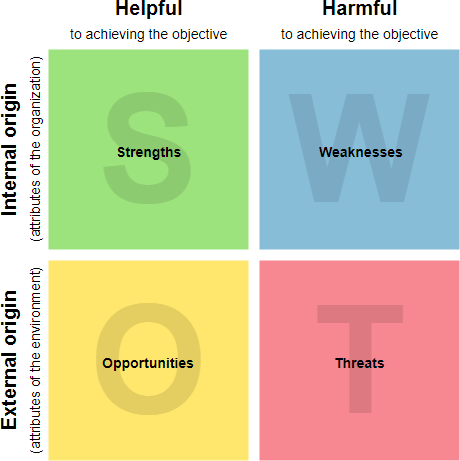
Edit this Diagram
What is a SWOT model
The analysis of strengths and weaknesses focuses on the strength of the company itself and its comparison with competitors, while the opportunity and threat analysis focus on changes in the external environment and possible impact on the company. In the analysis, all internal factors (i.e., strengths and weaknesses) should be grouped together and then evaluated by external forces (opportunities and threats).
Internal Factors (Strengths and weaknesses)
The analysis of strengths and weaknesses (S-W) of internal conditions is an internal method of assessment. The main purpose is to confirm the relationship between expertise and ability of the organization’s internal conditions. The strengths and weaknesses of its internal conditions are internal factors that the organization can control, including financial resources, technical resources, research and development, organizational culture, human resources, product characteristics, and marketing resources.
External Factors (opportunities and threats)
With the rapid development of economy, science and technology and many other aspects, especially the acceleration of globalization and integration of the world economy, the establishment of global information networks and the diversification of consumer demand, the environment in which companies are located are more open and volatile. This change has had a profound effect on almost all businesses. Because of this, environmental analysis has become an increasingly important corporate function.
The Opportunity and Threat (O-T) analysis is a method of evaluating the external environment. The main purpose is to confirm the relationship between the competitions of the industrial environment outside the organization. The opportunities and threats of the external environment are external factors that cannot be controlled by the organization, including factors such as competition, politics, economy, law, society, culture, science and technology, and demographic environment.
What is a Competitive Advantage?
Identifying attractive opportunities in the environment is one thing, and having the necessary competency to succeed in an opportunity is another matter. Each company must regularly check its strengths and weaknesses. When two companies are in the same market or they all can provide products and services to the same customer group, if one of them has higher profitability or profit potential, then we think that the company has a higher competitive advantage than the other. In other words, the so-called competitive advantage refers to a company’s ability to surpass its competitors, and this ability helps to achieve the company’s main goal – profitability. However, it is worth noting that competitive advantage is not necessarily fully reflected in higher profitability, because sometimes companies prefer to increase market share or employees.
Competitive advantage can refer to any superiority in the eyes of a consumer or its product in comparison with its competitors. It can be the breadth of the product line, the size, quality, reliability, suitability, style, and image of the product and services. Although a competitive advantage refers to a company that has a stronger overall advantage than its competitors, it is more meaningful to specify in which area the company has an advantage, because only in this way can we foster strengths and avoid weaknesses, or we can defeat the weakness.
Since the enterprise is a whole and the sources of competitive strengths are very extensive, it is necessary to make a detailed comparison between the company and its competitors from the aspects of the entire value chain when analyzing the strengths and weaknesses. Such as whether the product is novel, whether the manufacturing process is complicated, whether the sales channel is unimpeded, and whether the price is competitive. If an enterprise’s advantage in one aspect or several aspects is the key success factor that a company in the industry should have, then the enterprise’s comprehensive competitive advantage may be stronger. It should be pointed out that to measure whether a company and its products have a competitive advantage can only stand on the perspective of existing potential users, rather than stand on the perspective of the company.
In the process of maintaining a competitive advantage, enterprises must profoundly understand their resources and capabilities and take appropriate measures. Because once a company has a competitive advantage in one aspect, it is bound to attract the attention of competitors. Generally speaking, after a period of hard work, the company establishes a certain competitive advantage; then it is in a situation to maintain this competitive advantage, and competitors start to respond gradually; and if the competitors directly attack the advantage of the company, or Taking other more powerful strategies will weaken this advantage.
The main factors affecting the duration of a company’s competitive strengths are:
- How long does it take to establish this advantage?
- What are the advantages to be obtained?
- How long does it take for a competitor to make a strong reaction?
If the company analyzes these three factors clearly, it will identify itself in establishing and maintaining its competitive advantage.
The company should not correct all its weaknesses, nor should it make use of all its strengths. The main question is whether the company should be limited to the opportunities it already has, or whether it should acquire and develop some strengths to find better opportunities.
SWOT Analysis Strategies
In the process of adaptability analysis, enterprise top management should be based on the determination of internal and external variables, using leverage, inhibitory, vulnerability, and problematic four basic concepts to analyze this model.
- Leverage (S + O). Leverage effects arise when internal and external opportunities are consistent and adaptive to one another. In this situation, companies can use their internal strengths to pick up external opportunities and fully integrate opportunities and strengths. However, opportunities are often fleeting, so companies must sharply capture opportunities and seize the opportunity to seek greater development.
- Inhibitory (W + O). Inhibiting means impeding, preventing, influencing and controlling. When the opportunities provided by the environment are not suited to the internal resource advantages of the company, or cannot be overlapped with each other, the strengths of the enterprise will no longer be realized. In this situation, companies need to provide and add certain resources to promote the transformation of internal resources and weaknesses into strengths to cater to or adapt to external opportunities.
- Vulnerability (S + T). Vulnerability means the decrease or decrease in the degree or intensity of strengths. When environmental conditions pose a threat to the company’s strengths, the strengths cannot be fully exerted and ending up with a fragile situation. In this situation, companies must overcome the threats to take advantage of them.
- Problematic (W + T). When the company’s internal weaknesses and corporate external threats meet, companies face severe challenges. If they are not properly handled, they may directly threaten the survival of the company.
Steps for Conducting SWOT Analysis
- What is the current strategy?
- Confirm the changes in the external environment of the company (Porter 5 force or PEST)
- According to the company’s resource mix, confirm the company’s key capabilities and key constraints.
- Construct the SWOT Matrix by placing each one of already identified factors. This is an excellent graphic presentation of what is good and what is bad in your company, and what you can expect as an opportunity or threat.
- Define SWOT Strategies
- Choose what strategy to be adopted and determine the future direction and improvement actions to be taken
Case Study 1: Amazon SWOT Analysis

Amazon Detailed SWOT Analysis
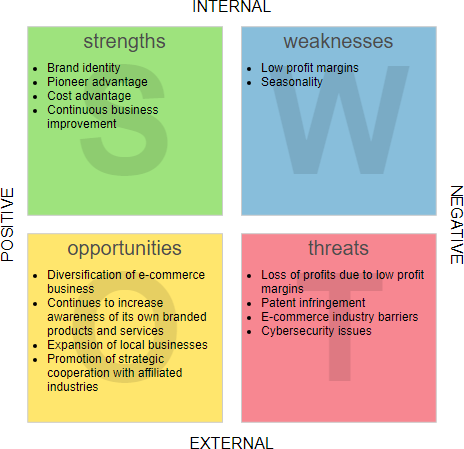
- Brand Identity: Amazon is synonymous with online sales services, and Amazon focuses on improving customer satisfaction during the business process.
- Pioneer advantage: Amazon is undoubtedly the leader in the online retail industry.
- Cost structure: Amazon effectively uses its cost advantage, operates on thin profits, and is still profitable in trading.
- Business Development: Amazon continuously improves its service level and provides diversified services.
- Low-profit margins: Amazon has a very thin profit margin to maintain its cost-leading strategy. But low-profit margins make companies vulnerable to external shocks and crises, as well as other market changes.
- Seasonality: There is a seasonal difference between Amazon’s revenue and business scope, with sales and revenue peaking in the fourth quarter of each year.
Opportunity
- Today’s diversification of e-commerce business
- Continues to increase awareness of its own branded products and services.
- Amazon develops more local websites to participate in the international market. With the international expansion of Amazon, some local businesses have the opportunity to enter the international market.
- Promoting the strategic cooperation between Amazon e-commerce and its related affiliated industries will drive positive development of the industry
- Loss of profits due to low-profit margins
- Patent infringement and other aspects of Amazon’s litigation
- E-commerce industry barriers to entry barriers
- Cybersecurity issues
Amazon – Recent Development
What do you need to do next after you understand strengths and weaknesses and identify opportunities and threats? Let us take a look at how Amazon has seized the opportunity to successfully transform itself from an e-commerce company into a global leading technology company! When Amazon realized the limitations of the retail industry, it expanded its business boundaries promptly. In addition to cloud computing and smart voice, Amazon has also contacted third-party platforms such as logistics and suppliers, and even invested in the film and television industry, making its business model more diversify. In 2008, Amazon realized that content can attract and extend users’ time on the platform, and began to provide original content on Prime Instant Video, Amazon’s mainstream media video platform, and as part of the Prime membership service. Amazon’s ecology can be described as a rotating flywheel. This flywheel is centered on Prime’s membership system, and new interests have been added to it, gradually creating an all-encompassing ecology. While continuing to attract new users, it has promoted the development of Amazon’s e-commerce and other new businesses, and it will continue to do so.
Case Study 2: Starbucks SWOT Analysis
- Strengths – The Starbucks Group has strong profitability, with 2004 revenue exceeding $600 million.
- Weaknesses – Starbucks is known for its continuous improvement and innovation. (Translator’s Note: It can be understood as the instability of the product line)
- Opportunity – The launch of new products and services, such as the sale of coffee at the show.
- Threats – rising costs of coffee and dairy products.
Starbucks Detailed SWOT Analysis
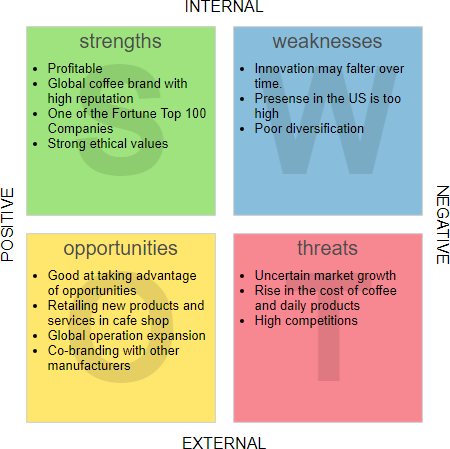
- Starbucks Corporation is a very profitable organization, earning more than $600 million in 2004. The company generated revenue of more than $5000 million in the same year.
- It is a global coffee brand built a reputation for fine products and services. It has almost 9000 cafe shop in almost 40 countries.
- Starbucks was one of the Fortune Top 100 Companies to Work For in 2005. The company is a respected employer that values its workforce.
- The organization has strong ethical values and an ethical mission statement as follows, ‘Starbucks is committed to a role of environmental leadership in all facets of our business.’
- Starbucks has a reputation for new product development and creativity. However, they can vulnerable to the possibility that their innovation may falter over time.
- The organization has a strong presence in the United States of America with more than three-quarters of its cafe shop located in the home market. Some people think they need to invest in different countries (national portfolios) to spread business risks.
- The organization is dependent on a main competitive advantage, the retail of coffee. This could make them slow to diversify into other sectors should the need arise.
Opportunities
- Starbucks is very good at taking advantage of opportunities. E.g. In 2004 the company created a CD-burning service in their Santa Monica (California USA) cafe with Hewlett Packard, where customers created their music CD.
- New products and services that can be retailed in their cafe shop, such as low price products.
- The company has the opportunity to expand its global operations. New markets for coffee such as India and the Pacific Rim nations are beginning to emerge.
- Co-branding with other manufacturers of food and drink and brand franchising to manufacturers of other goods and services both have potential.
- Who knows if the market for coffee will grow and stay in favor with customers, or whether another type of beverage or leisure activity will replace coffee in the future?
- Starbucks is exposed to rises in the cost of coffee and dairy products.
- Since its conception in Pike Place Market, Seattle in 1971, Starbucks’ success has to lead to the market entry of many competitors and copycat brands that pose potential threats.
Case Studies 3: Coca-Cola SWOT Analysis Example

Coca-Cola Detailed SWOT Analysis
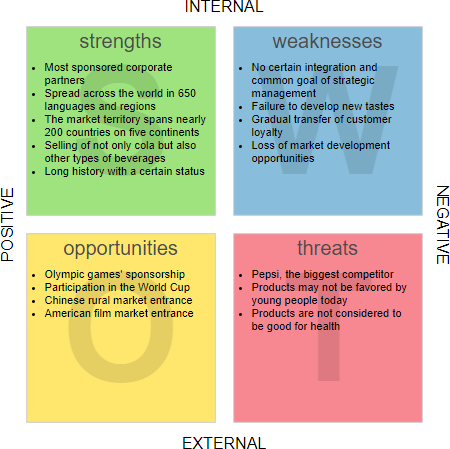
- Most sponsored corporate partners.
- Spread across the world in 650 languages and regions.
- The market territory spans nearly 200 countries on five continents.
- To develop new products, the Coca-Cola Company not only sells cola but also other types of beverages.
- Coca-Cola has a long history, so it has a certain status in the market.
- There is no certain integration and the common goal of strategic management.
- The failure to develop new tastes.
- The gradual transfer of customer loyalty.
- Loss of market development opportunities.
- Sponsor the Olympic Games, use this opportunity to replace their brands, products, and make advertisements, especially The Olympic Games is a worldwide movement that allows the world’s population to recognize this product, expand its market reach, and raise awareness of its products.
- Participate in the World Cup, take this world-wide activity to pave the way for your products and gain popularity.
- Enter the Chinese rural market.
- Enter the American film market.
- Pepsi is Coca-Cola’s biggest competitor
- The products produced by the company may not be favored by young people today.
- Coca-Cola is not considered to be good for health by many people
Formulating Actions for SWOT Analysis
Having completed a SWOT Analysis, so what’s next? Is this enough to conduct the SWOT analysis? You need to know when you are analyzing that at the end of the process you need to expect future directions for next actions. Here is an example of formulating actions for a SWOT analysis:
Disclaimer : This case study has been compiled from information freely available from public sources. It is merely intended to be used for educational purposes only.
©2024 by Visual Paradigm. All rights reserved.
- Terms of Service
- Privacy Policy
- Security Overview

3 Great SWOT Analysis Examples with Real Companies
Whether you want to assess the current position of your business, expand to new markets, or simply develop a new strategy, a SWOT analysis is probably one of the first steps that you will probably make in that direction. And, if it wasn’t on your radar, it should be! Today, we will see some of the best SWOT analysis examples to get you inspired, and help you understand how to do use it effectively for optimum results.

If you are not familiar with the concept, a SWOT analysis is a key technique for assessing some of the most important aspects of your business. In fact, its name comes from the abbreviation of these aspects:
Strengths – internal
These are the strengths of your company compared to other industry competitors. For example, what is it that you do particularly well that others don’t? What is your unique selling proposition , or that service or aspect of your business that differentiates you from the rest?
Do you have a particular competitive advantage over your biggest competitors? This could be technology, an easy access to primary resources, more product personalization, and so on.

Assessing your strengths will help you identify your current position on the market. But also, give you insights on those aspects that represent a clear advantage for your business, so you can leverage them even more.
Weaknesses – internal
Weaknesses, as you might have guessed, are the exact opposite of your organization’s strength. In other words, what do your competitors do better than you ? In what aspect do they have a clear advantage over you?
Is it something that you offer but can improve, or is it a service or an aspect that you lack altogether? For example, your customer service might be unsatisfactory. Or maybe, a competitor has a particular technological feature that your product don’t offer at all.
We will see more of this with practical cases in our section of SWOT Analysis examples.

Opportunities – external
The next aspect of the SWOT analysis is evaluating the positive trends that can open a new opportunity for your business. They usually arise from the outside of your organization , such as industry changes, important movements on the competitors’ landscape, or even a change in the laws applicable to your industry.
Analyzing other factors, such as VUCA – the leadership theory on volatility, uncertainty, complexity and ambiguity, can also reveal new opportunities for your business. To identify them, you will have to look around you from an external perspective.
Can you spot any current trends that could represent an opportunity for your business? For example, the COVID-19 pandemic made companies like Nike and Adidas sell protective masks on their website as a part of their product portfolio. And many new businesses opened to profit from the changes.

Threats – external
Threats are another aspect that is external to your business, but can impact you negatively if you aren’t paying attention. Some examples include supply chain problems, shift in market requirements, changes to current laws and regulations, and so on.
Of course, threats are not always easy to identify. You will have to be proactively looking for them – if they are obvious, it is probably too late. What is the competition doing? How is the current technology evolving?
Are you noticing a change in user behavior regarding the consumption of your particular product? All these questions can help you get a better understanding of the market , and what could potentially be harmful to you.

And now, let’s get right to our SWOT analysis examples!
Disclaimer: These examples are merely my own analysis and interpretation of the information that is publicly available online for these companies. I don´t work at any of these companies, and I do not pretend that I actually know what is going on behind the scenes for any of them. It is just a practical exercise with real companies with the purpose of giving you a clear idea of how to perform a SWOT analysis.
1. The Coca Cola Company

First on our list of SWOT analysis examples is this one from The Coca Cola Company.

SWOT Analysis examples #1: The Coca Cola Company
Let’s discuss it in detail.
- Variety of products – one of the biggest strengths that The Coca Cola Company has is their incredible variety of products across different categories. In fact, there are over 500 brands across 200 companies owned by Coca Cola. This not only gives them a higher control on the market, but also more diversified expertise, and less overall competition.
- Market share – with a market share of 43% in the soft drink industry, they have a very solid positioning compared to many other competitors. Which also means that it would be extremely difficult to compete with Coca Cola and its almost unlimited resources.
- Brand recognition – Coca Cola is one of the most recognized brands in the world, which gives them a huge advantage in front of their competitors. It also means that any new product or brand they invest in will gain visibility almost immediately.
- Secret recipes – and last but not least, the company prides itself in having a secret recipe for its flagship product – the Coca Cola. This means that this product will be difficult to replicate by competitors.

- Health trends – one of the biggest weaknesses that the company has is its unability to adapt to current health trends. As people are becoming more and more conscious about the unhealthy food and the amount of sugar they are consuming, soft and sugary drinks are slowly getting substituted by healthier options.
- Sugar substitute – another health-related weakness for the company involves the difficulty of improving their quality of their product without affecting its famous taste. Coca Cola has been actively looking for healthy sugar substitutes for years with no success.
- Current positioning – the current positioning of Coca Cola and its soft drinks is both a blessing and a curse. A blessing, because everyone knows the brand and the product it offers. This kind of brand recognition is something that every company dreams of.
However, this weakness comes with the fact that Coca Cola already has a certain reputation established for itself that is difficult to change. And, considering its sugary drinks with mysterious and secret ingredients, it is certainly not the most positive one.

- Health trends – if The Coca Cola Company closely monitors and responds adequately to current health trends, they have a huge opportunitiy to increase their market share. And get an even bigger chunk of the soft drink industry. Especially if they manage to find a healthy substitute for sugar.
- Few major competitors – considering the dominance of the brand and only a few major competitors for these particular types of products, Coca Cola can quickly introduce new products with the right Marketing strategy.
- Healthier alternatives – although the company is quite dominant when it comes to soft drinks, a lot of other healthier alternatives are arising on the market. Flavoured waters, smoothies, organic drinks, green juices, and so on, are just some of the alternatives that people are starting to prefer as they get more conscious with their health.
- Negative press and media coverage – although The Coca Cola Company is known for its brilliant Marketing strategies and its incredible brand recognition, it also gets a lot of negative coverage for being unhealthy. In-depth research, Youtube videos, and even articles from reputable sources such as The Telegraph might cause serious harm in the long run.

Now that we have seen the first one, let´s move on to the next on our list of SWOT Analysis examples!

Next on our collection of SWOT analysis examples is Airbus, the world’s largest airliner manufacturer, and the one who took the most orders in 2019. So, let’s see what are the strengths, weaknesses, opportunities and threats for Airbus:

SWOT Analysis examples #2: Airbus
- Market share – with an estimated market share of almost 63% , Airbus is the largest aircraft manufacturer in the world, which gives the company a very strong and powerful position in the industry.
- Global network & international presence – with business operations located in Europe, the Americas, Africa & The Middle East, and Asia, Airbus has an incredible international network and presence.
- Innovation & technology – additionally, Airbus is putting a huge focus on investing in technology, innovation, and next generation manufacturing, more than any other competitor in the industry.
- Eco-efficiency – and last but not least, another strength that Airbus counts with is eco-efficiency. The company has been recognized is a leader in proposing and developing solutions for sustainable aviation.
- Delay in delivery – in 2019, Airbus took more orders for aircraft delivery than any other competitor, including its biggest rival Boeing. However, this caused a delay in the delivery of the orders, causing the company to accumulate a lot of backlogs.
- Operational inefficiencies – compared to rivals such as Boeing, Airbus has gained a reputation of being somewhat inconsistent when it comes to executing operations. The company is often delaying launches of its new models – for example, the launch of Airbus A380 was delayed by more than one year. This weaknesses is definitely something that Airbus could work on.
- High production costs – another key weakness of the company is the fact that it has higher production costs than its main rival Boeing, which leaves them with lower profit margins.

- Boom in Travelling – as the travelling industry is booming due to the growing percentage of the middle class, and the lower costs for airplane tickets compared to a decade ago, aircraft manufacturers are receiving more orders than ever. In fact, even in the next few years, the air traffic is anticipated to grow by 4.3% annually. According to Airbus , this alone will require “ 39,200 new passenger and dedicated freighter aircraft over the next 20 years.”
- Technological advances – over the last few years, the industry has gone through a lot of innovation processes and technological improvements. This has allowed Airbus to improve its weaknesses and offer better and faster performance. Also, the fact that aircrafts are becoming more and more secure with the new technologies make people want to travel even more.
- Competition – the competition in the aerospace industry is practically considered a duopoly. The reason why is because Boeing and Airbus have a combined share of 91% for the whole commercial aircraft market globally. This means that they will not have to fight off small competitors, but also that the competition between both companies is extremely fierce. Which can be a significant threat for Airbus.
- Global pandemic – in 2020, the whole world suffered from the COVID-19 pandemic. This alone had a severe impact on the growth of the commercial aircraft market, as people suddenly had to stop travelling. And although this was a temporary decrease that is slowly starting to recover, aircraft manufacturers like Airbus will be affected at least for the next one year.
- Potential competitors in key markets – of course, the fact that Airbus and Boeing are currently dominating the global market does not mean that this will last forever. Currently, important markets like China and Russia are also planning to develop their own commercial aircraft. If that happens, it will most probably shrink the market share for Airbus.

Next on our list of SWOT Analysis examples is Zara, one of the biggest clothing companies in the world. Zara is a brand owned by Inditex , among with several others such as Bershka, Stradivarius, and Oysho.

SWOT Analysis examples #3: Zara
- Efficient manufacturing & delivery – Zara is one of the most efficient clothing companies in the world when it comes to all operational processes – manufacturing, delivery, supply chain and logistics. Reportedly, the company needs just 1 week to develop a new product and get it to all 2,259 stores it has worldwide, compared to an industry average of 6 months. This gives Zara a huge advantage when it comes to delivering new designs in record time.
- Competitive pricing – additionally, the company also offers a very competitive pricing for the variety and amount of products it offers. Its clothing is targeted to a middle class audience, although it´s also true that the pricing is adapted to the characteristics of each market. For example, the prices for Zara in South Korea are 96% higher than the prices in Spain, taking into account the exchange rate of the study.
- Strong global presence – As we already mentioned, Zara has over 2,200 stores across 96 countries, positioning itself as a strong international brand with a solid support (Inditex, with over 7,000 stores ).
- Fast reaction to new trends – the company is known for imitating high-fashion trends, and it is extremely fast when it comes to spotting and replicating them for its own products.
The company´s strengths is what makes it one of my favourite SWOT analysis examples on this list. They are very well defined, and definitely makes Zara stand out from competitors. However, this does not mean that there are no weaknesses:

- Zero policy advertising – the company is famous for its zero policy advertising. This means that, instead of investing in Marketing and Communication actions, they use the money for opening new stores. Although this policy has some awesome benefits, I think that it´s also a very big weakness. The heavy digital advertising done by competitors can completely overshadow Zara in the long run.
- Limited product stock – because Zara delivers fashion pieces in record time, they don´t produce as much stock as other companies would. Which is not great news for customers who often love a piece, and it is already out of stock – or simply not in the size they need.
- Controversies – additionally, the company is also involved in multiple controversies revolving child labour and paying under minimum wage. As people are getting more and more conscious about these topics, these controversies is doing a lot of harm to the company´s reputation.
- High fashion imitation – as we already mentioned, Zara is known to imitate fashion trends. Which means that they are not a trend setter, and they do not offer a lot of unique and creative pieces designed exclusively by them.

- Growing demand for high fashion – currently, there is a growing demand for clothing that looks high fashion, but don´t cost thousands of dollars for a single piece. This is a great opportunity for Zara, which does precisely what people want – selling high fashion style for affordable prices.
- Fast fashion – as customer behavior is changing, people get bored with everything faster than ever. And this is true for fashion as well – clothes that people would wear for months and years now get substituted with new pieces much more often. Which is another excellent opportunity for Zara as the so-called “fast fashion is on the rise”.
- Market growth – according to Statista , the growth of the apparel market is steadily increasing by 5-6% every year, which is great news for clothing companies like Zara.
And now, let´s take a look at the external changes that are imposing a threat for this one of our SWOT analysis examples:
- Growing competition – the increasing demand for fashion and apparel also means that competition is growing as well. With huge online providers taking over the Internet such as ASOS, Fashion Nova, Shein and others, Zara´s popularity is becoming threatened by other companies. Especially considering the fact that these providers actually offer products from multiple brands at the same place.
- Increasing costs – another tendency that could impose a significant threat for Zara are the increasing costs for production and raw material. Which, as a consequence, will probably reduce its revenue and profit margins. Especially considering the fact the prices are already relatively low! For now, Zara has managed to develop a well integrated and efficient supply chain that keeps the cost of raw materials low. But this might not last forever, especially if the prices keep rising.
- Regulatory threats – the business industry is gradually getting more and more regulated. On a global scale, governments and legal agencies are regulating all kind of sectors and businesses, and the fashion market is not an exception. This includes labour, quality, customer services, and many other aspects of the industry. All of these regulations might eventually have a negative impact on Zara.

Do you want to learn more about SWOT analysis? You might want to check these articles:
- 9 Effective Ways to Identify Opportunities in SWOT Analysis
- 10 Common SWOT Analysis Mistakes in 2022 & How to Fix Them
Need more SWOT analysis examples? Check out our article on Coca Cola SWOT analysis.

Made with Easelly, free infographic maker
How do you write a good SWOT analysis?
The first step for writing a good SWOT analysis is to determine your objective - what company and strategy are you going to analyze? Next, take a piece of paper and draw a grid with 4 squares, labeling each one of them as it follows - Strengths, Weaknesses, Opportunities and Threats. The key to a good SWOT analysis is getting as specific as possible with each section in order to get more tangible and clear points of action.
What is a SWOT analysis tool?
SWOT analysis is a technique for strategic planning that allows you to assess and identify the strengths and weaknesses of your company (internal factors), as well as the opportunities and threats that may come from the outside, including market trends and competition (external factors).
Why is SWOT analysis important?
SWOT analysis is important for businesses because it provides them with a simple, but powerful framework to assess their own ability to compete on the market, identifying strengths to highlight and weaknesses to work on improving. It also gives them a quick glance at the market from an outside perspective, allowing them to spot current opportunities and identify potential threats that should be addressed as early as possible.
What is the most difficult part of the SWOT analysis?
While the answer may vary between companies and industries, the most difficult part of the SWOT analysis tends to be Opportunities. The main reason why is because the answer may sometimes require a comprehensive and detailed market research to reveal certain opportunities.
And that was all from me, folks! I hope you liked my in-depth SWOT analysis examples. I think the best way to learn a concept is to see how it is applied in practice. For this reason, I wanted to focus this article from a practical rather than a theoretical perspective. However, if you have any questions, do not hesitate to send me an email at [email protected] , or just let me know in the comments below!
Thank you for taking the time to read my article 3 Great SWOT Analysis Examples with Real Companies, and I hope to see you in the next one!
animitevabg
Hello, and welcome to my blog! Let me present myself.
My name is Ani and I am a trilingual Digital Marketing & Analytics Specialist with 10 years of experience across multiple sectors including Cloud-based services, SaaS, Digital payments, Mobile apps, and Executive Education, among others.
My expertise covers areas such as Google Ads, Google Analytics, Search Engine Optimization, Content Marketing, and Social Media.
Join the discussion Cancel reply
Further reading.

- Enhance Customer Satisfaction With This Ultimate Guide

The Future of Property Listings: How Tech is Changing the Game

VPN Protocols: A Comprehensive Analysis

8 Reasons To Hire A Design Agency

How Can A Startup Get Its Own Office Space In New Zealand

The Vital Importance of AI in Marketing and Business
Follow my LinkedIn page for the latest updates!
Recent Posts
- Evergreen Marketing: Building A Timeless Brand Strategy
- The Rise of Virtual Health Assistants: Transforming Patient Care
- Best of Both Worlds: How SEO Helps Mortgage Brokers
- 7 Tips for Hosting Successful Virtual Business Meetings
Recent Comments
- Paul on Top 15 Powerful Alternatives to Google Ads for 3x More Leads
- Lilly on Why is High-Quality Content Important for the Educational Business?
- Lilly on How To Create A Marketing Pamphlet For Your Business
- Katarzyna on 10 Brilliant Kpop Marketing Strategies That Set Guinness Records
- animitevabg on Starbucks Marketing Strategy: Selling 4 Million Coffees Daily
- December 2023
- November 2023
- October 2023
- September 2023
- August 2023
- February 2023
- January 2023
- December 2022
- November 2022
- October 2022
- September 2022
- August 2022
- February 2022
- January 2022
- December 2021
- November 2021
- October 2021
- September 2021
- August 2021
- February 2021
- January 2021
- December 2020
- November 2020
- October 2020
- September 2020
- August 2020
- February 2020
- January 2020
- December 2019
- November 2019
- October 2019
- September 2019
- August 2019
- February 2018
- January 2018
- November 2017
- September 2017
- August 2017
- Business Strategy
- Case Studies
- Data & Analytics
- Digital Marketing
- Evergreen Marketing
- Social Media
- Uncategorized
- Entries feed
- Comments feed
- WordPress.org
- Project management |
SWOT analysis: Examples and templates

A SWOT analysis helps you identify strengths, weaknesses, opportunities, and threats for a specific project or your overall business plan. It’s used for strategic planning and to stay ahead of market trends. Below, we describe each part of the SWOT framework and show you how to conduct your own.
Whether you’re looking for external opportunities or internal strengths, we’ll walk you through how to perform your own SWOT analysis, with helpful examples along the way.
What is a SWOT analysis?
A SWOT analysis is a technique used to identify strengths, weaknesses, opportunities, and threats for your business or even a specific project. It’s most widely used by organizations—from small businesses and non-profits to large enterprises—but a SWOT analysis can be used for personal purposes as well.
While simple, a SWOT analysis is a powerful tool for helping you identify competitive opportunities for improvement. It helps you improve your team and business while staying ahead of market trends.
What does SWOT stand for?
SWOT is an acronym that stands for:

When analyzed together, the SWOT framework can paint a larger picture of where you are and how to get to the next step. Let’s dive a little deeper into each of these terms and how they can help identify areas of improvement.
Strengths in SWOT refer to internal initiatives that are performing well. Examining these areas helps you understand what’s already working. You can then use the techniques that you know work—your strengths—in other areas that might need additional support, like improving your team’s efficiency .
When looking into the strengths of your organization, ask yourself the following questions:
What do we do well? Or, even better: What do we do best?
What’s unique about our organization?
What does our target audience like about our organization?
Which categories or features beat out our competitors?
Example SWOT strength:
Customer service: Our world-class customer service has an NPS score of 90 as compared to our competitors, who average an NPS score of 70.
Weaknesses in SWOT refer to internal initiatives that are underperforming. It’s a good idea to analyze your strengths before your weaknesses in order to create a baseline for success and failure. Identifying internal weaknesses provides a starting point for improving those projects.
Identify the company’s weaknesses by asking:
Which initiatives are underperforming and why?
What can be improved?
What resources could improve our performance?
How do we rank against our competitors?
Example SWOT weakness:
E-commerce visibility: Our website visibility is low because of a lack of marketing budget , leading to a decrease in mobile app transactions.
Opportunities in SWOT result from your existing strengths and weaknesses, along with any external initiatives that will put you in a stronger competitive position. These could be anything from weaknesses that you’d like to improve or areas that weren’t identified in the first two phases of your analysis.
Since there are multiple ways to come up with opportunities, it’s helpful to consider these questions before getting started:
What resources can we use to improve weaknesses?
Are there market gaps in our services?
What are our business goals for the year?
What do your competitors offer?
Example SWOT opportunities:
Marketing campaign: To improve brand visibility, we’ll run ad campaigns on YouTube, Facebook, and Instagram.
Threats in SWOT are areas with the potential to cause problems. Different from weaknesses, threats are external and out of your control. This can include anything from a global pandemic to a change in the competitive landscape.
Here are a few questions to ask yourself to identify external threats:
What changes in the industry are cause for concern?
What new market trends are on the horizon?
Where are our competitors outperforming us?
Example SWOT threats:
New competitor: With a new e-commerce competitor set to launch within the next month, we could see a decline in customers.
SWOT analysis example
One of the most popular ways to create a SWOT analysis is through a SWOT matrix—a visual representation of strengths, weaknesses, opportunities, and threats. The matrix comprises four separate squares that create one larger square.
A SWOT matrix is great for collecting information and documenting the questions and decision-making process . Not only will it be handy to reference later on, but it’s also great for visualizing any patterns that arise.
Check out the SWOT matrix below for a simple example. As you can see, each of the quadrants lists out the company's strengths, weaknesses, opportunities, and threats.
![swot analysis business case study [Inline illustration] SWOT analysis (Example)](https://assets.asana.biz/transform/cfab4ed2-46d1-4636-b801-14b3d86c8367/inline-project-management-SWOT-analysis-4-2x?io=transform:fill,width:2560&format=webp)
When used correctly and effectively, your matrix can be a great toolkit for evaluating your organization’s strengths and weaknesses.
How to do a SWOT analysis, with examples
A SWOT analysis can be conducted in a variety of ways. Some teams like to meet and throw ideas on a whiteboard, while others prefer the structure of a SWOT matrix. However you choose to make your SWOT analysis, getting creative with your planning process allows new ideas to flow and results in more unique solutions.
There are a few ways to ensure that your SWOT analysis is thorough and done correctly. Let’s take a closer look at some tips to help you get started.
Tip 1: Consider internal factors
Often, strengths and weaknesses stem from internal processes. These tend to be easier to solve since you have more control over the outcome. When you come across internal factors, you can start implementing improvements in a couple of different ways.
Meet with department stakeholders to form a business plan around how to improve your current situation.
Research and implement new tools, such as a project management tool , that can help streamline these processes for you.
Take immediate action on anything that can be changed in 24 hours or less. If you don’t have the capacity, consider delegating these items to others with deadlines.
The way you go about solving internal factors will depend on the type of problem. If it’s more complex, you might need to use a combination of the above or a more thorough problem management process.
Tip 2: Evaluate external factors
External factors stem from processes outside of your control. This includes competitors, market trends, and anything else that’s affecting your organization from the outside in.
External factors are trickier to solve, as you can’t directly control the outcome. What you can do is pivot your own processes in a way that mitigates negative external factors.
You can work to solve these issues by:
Competing with market trends
Forecasting market trends before they happen
Improving adaptability to improve your reaction time
Track competitors using reporting tools that automatically update you as soon as changes occur
While you won’t be able to control an external environment, you can control how your organization reacts to it.
Let’s say, for instance, that you’re looking to compete with a market trend. For example, a competitor introduced a new product to the market that’s outperforming your own. While you can’t take that product away, you can work to launch an even better product or marketing campaign to mitigate any decline in sales.
Tip 3: Hold a brainstorming session
Brainstorming new and innovative ideas can help to spur creativity and inspire action. To host a high impact brainstorming session, you’ll want to:
Invite team members from various departments. That way, ideas from each part of the company are represented.
Be intentional about the number of team members you invite, since too many participants could lead to a lack of focus or participation. The sweet spot for a productive brainstorming session is around 10 teammates.
Use different brainstorming techniques that appeal to different work types.
Set a clear intention for the session.
Tip 4: Get creative
In order to generate creative ideas, you have to first invite them. That means creating fun ways to come up with opportunities. Try randomly selecting anonymous ideas, talking through obviously bad examples, or playing team building games to psych up the team.
Tip 5: Prioritize opportunities
Now, rank the opportunities. This can be done as a team or with a smaller group of leaders. Talk through each idea and rank it on a scale of one through 10. Once you’ve agreed on your top ideas based on team capabilities, competencies, and overall impact, it’s easier to implement them.
Tip 6: Take action
It’s all too easy to feel finished at this stage —but the actual work is just beginning. After your SWOT analysis, you’ll have a list of prioritized opportunities. Now is the time to turn them into strengths. Use a structured system such as a business case , project plan, or implementation plan to outline what needs to get done—and how you plan to do it.
SWOT analysis template
A SWOT analysis template is often presented in a grid format, divided into four quadrants. Each quadrant represents one of the four elements.
Use this free SWOT analysis template to jump-start your team’s strategic planning.
Identify the strengths that contribute to achieving your objectives. These are internal characteristics that give you an advantage. Some examples could be a strong brand reputation, an innovative culture, or an experienced management team.
Next, focus on weaknesses. These are internal factors that could serve as obstacles to achieving your objectives. Common examples might include a lack of financial resources, high operational costs, or outdated technology.
Move on to the opportunities. These are external conditions that could be helpful in achieving your goals. For example, you might be looking at emerging markets, increased demand, or favorable shifts in regulations.
Lastly, let's address threats. These are external conditions that could negatively impact your objectives. Examples include increased competition or potential economic downturns.
Why is a SWOT analysis important?
A SWOT analysis can help you improve processes and plan for growth. While similar to a competitive analysis , it differs because it evaluates both internal and external factors. Analyzing key areas around these opportunities and threats will equip you with the insights needed to set your team up for success.

A SWOT analysis isn’t only useful for organizations. With a personal SWOT analysis, you can examine areas of your life that could benefit from improvement, from your leadership style to your communication skills. These are the benefits of using a SWOT analysis in any scenario.
1. Identifies areas of opportunity
One of the biggest benefits of conducting an analysis is to determine opportunities for growth. It’s a great starting point for startups and teams that know they want to improve but aren’t exactly sure how to get started.
Opportunities can come from many different avenues, like external factors such as diversifying your products for competitive advantage or internal factors like improving your team’s workflow . Either way, capitalizing on opportunities is an excellent way to grow as a team.
2. Identifies areas that could be improved
Identifying weaknesses and threats during a SWOT analysis can pave the way for a better business strategy.
Ultimately, learning from your mistakes is the best way to excel. Once you find areas to streamline, you can work with team members to brainstorm an action plan . This will let you use what you already know works and build on your company’s strengths.
3. Identifies areas that could be at risk
Whether you have a risk register in place or not, it’s always crucial to identify risks before they become a cause for concern. A SWOT analysis can help you stay on top of actionable items that may play a part in your risk decision-making process.
It may be beneficial to pair your SWOT analysis with a PEST analysis, which examines external solutions such as political, economic, social, and technological factors—all of which can help you identify and plan for project risks .
When should you use a SWOT analysis?
You won’t always need an in-depth SWOT analysis. It’s most useful for large, general overviews of situations, scenarios, or your business.
A SWOT analysis is most helpful:
Before you implement a large change—including as part of a larger change management plan
When you launch a new company initiative
If you’d like to identify opportunities for growth and improvement
Any time you want a full overview of your business performance
If you need to identify business performance from different perspectives
SWOT analyses are general for a reason—so they can be applied to almost any scenario, project, or business.
SWOT analysis: Pros and cons
Although SWOT is a useful strategic planning tool for businesses and individuals alike, it does have limitations. Here’s what you can expect.
The simplicity of SWOT analysis makes it a go-to tool for many. Because it is simple, it takes the mystery out of strategic planning and lets people think critically about their situations without feeling overwhelmed.
For instance, a small bakery looking to expand its operations can use SWOT analysis to easily understand its current standing. Identifying strengths like a loyal customer base, weaknesses such as limited seating space, opportunities like a rising trend in artisanal baked goods, and threats from larger chain bakeries nearby can all be accomplished without any specialized knowledge or technical expertise.
Versatility
Its versatile nature allows SWOT analysis to be used across various domains. Whether it’s a business strategizing for the future or an individual planning their career path, SWOT analysis lends itself well.
For example, a tech start-up in the competitive Silicon Valley landscape could employ SWOT to navigate its pathway to profitability. Strengths might include a highly skilled development team; weaknesses could be a lack of brand recognition; opportunities might lie in emerging markets; and threats could include established tech giants.
Meaningful analysis
SWOT excels in identifying external factors that could impact performance. It nudges organizations to look beyond the present and anticipate potential future scenarios.
A retail company, for example, could use SWOT analysis to identify opportunities in e-commerce and threats from changing consumer behavior or new competitors entering the market. By doing so, the company can strategize on how to leverage online platforms to boost sales and counteract threats by enhancing the customer experience or adopting new technologies.
Subjectivity and bias
The subjective nature of SWOT analysis may lead to biases. It relies heavily on individual perceptions, which can sometimes overlook crucial data or misinterpret information, leading to skewed conclusions.
For example, a manufacturing company might undervalue the threat of new entrants in the market due to an overconfidence bias among the management. This subjectivity might lead to a lack of preparation for competitive pricing strategies, ultimately affecting the company's market share.
Lack of prioritization
SWOT analysis lays out issues but falls short on prioritizing them. Organizations might struggle to identify which elements deserve immediate attention and resources.
For instance, a healthcare provider identifying numerous opportunities for expansion into new services may become overwhelmed with the choices. Without a clear way to rank these opportunities, resources could be spread too thinly or given to projects that do not have as much of an impact, leading to less-than-ideal outcomes.
Static analysis
Since SWOT analysis captures a snapshot at a particular moment, it may miss the evolving nature of challenges and opportunities, possibly leading to outdated strategies. An example could be a traditional retail business that performs a SWOT analysis and decides to focus on expanding physical stores, overlooking the growing trend of e-commerce. As online shopping continues to evolve and gain popularity, the static analysis might lead to investment in areas with diminishing returns while missing out on the booming e-commerce market trend.
SWOT analysis FAQ
What are the five elements of swot analysis.
Traditionally, SWOT stands for its four main elements: strengths, weaknesses, opportunities, and threats. However, a fifth essential element often overlooked is "actionable strategies." Originally developed by Albert Humphrey, SWOT is more than just a list—it's a planning tool designed to generate actionable strategies for making informed business decisions. This fifth element serves to tie the other four together, enabling departments like human resources and marketing to turn analysis into actionable plans.
What should a SWOT analysis include?
A comprehensive SWOT analysis should focus on the internal and external factors that affect your organization. Internally, consider your strong brand and product line as your strengths, and maybe your supply chain weaknesses. Externally, you'll want to look at market share, partnerships, and new technologies that could either pose opportunities or threats. You should also account for demographics, as it helps in market targeting and segmentation.
Writing an effective SWOT analysis begins with research. Start by identifying your strengths, like a strong brand, and your weaknesses, like a small human resources department. Following that, look outward to find opportunities, possibly in technological advancement, and threats, like fluctuations in market share. Many businesses find it helpful to use a free SWOT analysis template to structure this information. A good SWOT analysis doesn't just list these elements; it integrates them to provide a clear roadmap for making business decisions.
What are four examples of threats in SWOT analysis?
New technologies: Rapid technological advancement can make your product or service obsolete.
Supply chain disruptions: Whether due to natural disasters or geopolitical tensions, an unstable supply chain can seriously jeopardize your operations.
Emerging competitors: New players entering the market can erode your market share and offer alternative solutions to your customer base.
Regulatory changes: New laws or regulations can add costs and complexity to your business, affecting your competitiveness.
How do you use a SWOT analysis?
Once you've completed a SWOT analysis, use the results as a decision-making aid. It can help prioritize actions, develop strategic plans that play to your strengths, improve weaknesses, seize opportunities, and counteract threats. It’s a useful tool for setting objectives and creating a roadmap for achieving them.
Plan for growth with a SWOT analysis
A SWOT analysis can be an effective technique for identifying key strengths, weaknesses, opportunities, and threats. Understanding where you are now can be the most impactful way to determine where you want to go next.
Don’t forget, a bit of creativity and collaboration can go a long way. Encourage your team to think outside of the box with 100+ team motivational quotes .
SWOT Analysis: How To Do One [With Template & Examples]
Published: October 05, 2023
As your business grows, you need a roadmap to help navigate the obstacles, challenges, opportunities, and projects that come your way. Enter: the SWOT analysis.

This framework can help you develop a plan to determine your priorities, maximize opportunities, and minimize roadblocks as you scale your organization. Below, let’s go over exactly what a SWOT analysis is, a few SWOT analysis examples, and how to conduct one for your business.
![swot analysis business case study → Download Now: Market Research Templates [Free Kit]](https://no-cache.hubspot.com/cta/default/53/6ba52ce7-bb69-4b63-965b-4ea21ba905da.png)
When you’re done reading, you’ll have all the inspiration and tactical advice you need to tackle a SWOT analysis for your business.
What is a SWOT analysis? Importance of a SWOT Analysis How to Write a Good SWOT Analysis SWOT Analysis Examples How to Act on a SWOT Analysis
A SWOT analysis is a strategic planning technique that puts your business in perspective using the following lenses: Strengths, Weaknesses, Opportunities, and Threats. Using a SWOT analysis helps you identify ways your business can improve and maximize opportunities, while simultaneously determining negative factors that might hinder your chances of success.
While it may seem simple on the surface, a SWOT analysis allows you to make unbiased evaluations on:
- Your business or brand.
- Market positioning.
- A new project or initiative.
- A specific campaign or channel.
Practically anything that requires strategic planning, internal or external, can have the SWOT framework applied to it, helping you avoid unnecessary errors down the road from lack of insight.
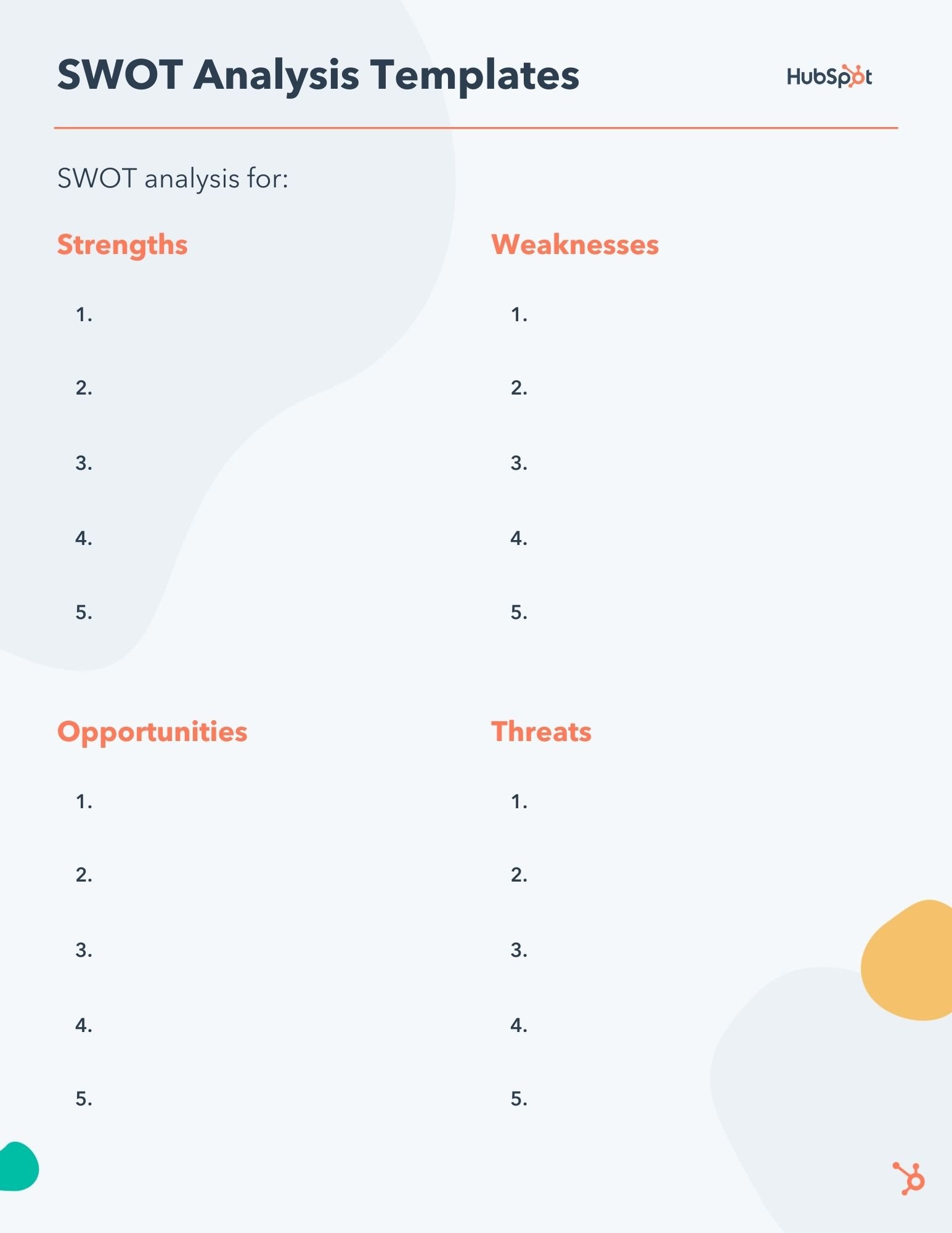
Free SWOT Analysis Template
A free SWOT analysis template, plus other helpful market research resources.
You're all set.
Click this link to access this resource at any time.
Importance of a SWOT Analysis
You’ve noticed by now that SWOT stands for Strengths, Weaknesses, Opportunities, and Threats. The framework seems simple enough that you’d be tempted to forgo using it at all, relying instead on your intuition to take these things into account.
But you shouldn’t. Doing a SWOT analysis is important. Here’s why.
SWOT gives you the chance to worry and to dream.
A SWOT analysis is an important step in your strategic process because it gives you the opportunity to explore both the potential risks and the exciting possibilities that lie ahead. You’re giving yourself the space to dream, evaluate, and worry before taking action. Your insights then turn into assets as you create the roadmap for your initiative.
For instance, when you consider the weaknesses and threats that your business may face, you can address any concerns or challenges and strategize on how to mitigate those risks. At the same time, you can identify strengths and opportunities, which can inspire innovative ideas and help you dream big. Both are equally important.
SWOT forces you to define your variables.
Instead of diving head first into planning and execution, you’re taking inventory of all your assets and roadblocks. This process will help you develop strategies that leverage your strengths and opportunities while addressing and mitigating the impact of weaknesses and threats.
As a result, you'll gain a comprehensive understanding of your current situation and create a more specific and effective roadmap. Plus, a SWOT analysis is inherently proactive. That means you'll be better equipped to make informed decisions, allocate resources effectively, and set realistic goals.
SWOT allows you to account for mitigating factors.
As you identify weaknesses and threats, you’re better able to account for them in your roadmap, improving your chances of success.
Moreover, accounting for mitigating factors allows you to allocate your resources wisely and make informed decisions that lead to sustainable growth. With a SWOT analysis as a guide, you can confidently face challenges and seize opportunities.
SWOT helps you keep a written record.
As your organization grows and changes, you’ll be able to strike things off your old SWOTs and make additions. You can look back at where you came from and look ahead at what’s to come.
In other words, SWOT analyses serve as a tangible history of your progress and provide a reference point for future decision-making. With each update, your SWOT analysis becomes a living document that guides your strategic thinking and helps you stay agile and adaptable in an ever-changing business landscape.
By maintaining this written record, you foster a culture of continuous improvement and empower your team to make data-driven decisions and stay aligned with your long-term vision.
Parts of a SWOT Analysis
Conducting a SWOT analysis will help you strategize effectively, unlock valuable insights, and make informed decisions. But what exactly does a SWOT analysis include?
Let’s explore each component: Strengths, Weaknesses, Opportunities, and Threats.
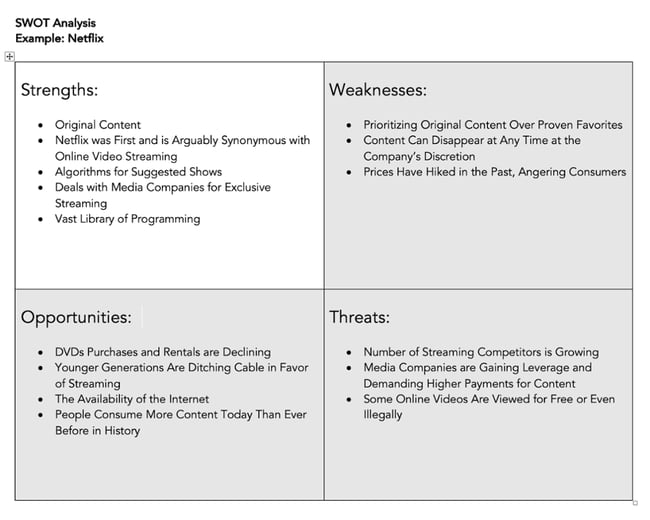
Your strengths are the unique advantages and internal capabilities that give your company a competitive edge in the market. A strong brand reputation, innovative products or services, or exceptional customer service are just a few examples. By identifying and capitalizing on your strengths, you can foster customer loyalty and build a solid foundation for growth.
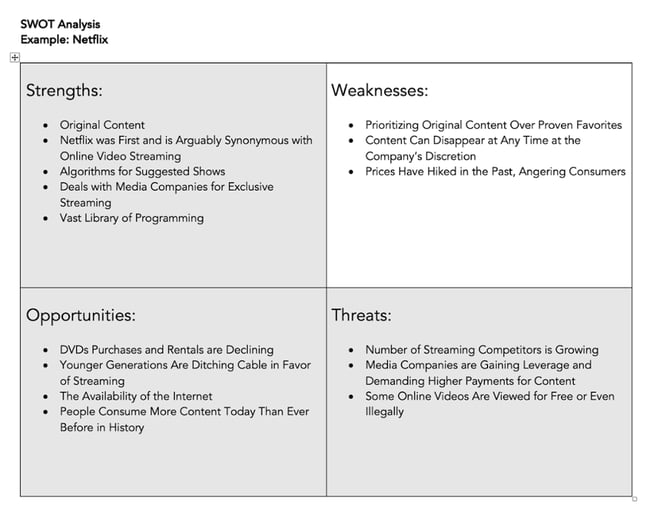
No business is flawless. Weaknesses are areas where you may face challenges or fall short of your potential. It could be outdated processes, skill gaps within the team, or inadequate resources. By acknowledging these weaknesses, you can establish targeted initiatives for improvement, upskill your team, adopt new technologies, and enhance your overall operational efficiency.
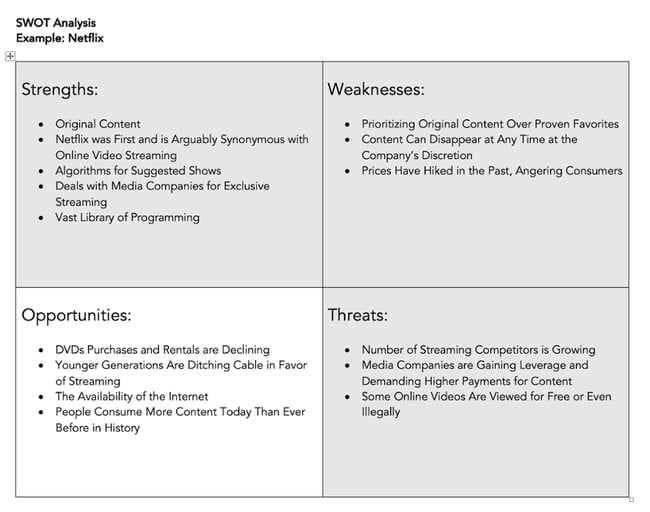
Opportunities are external factors that can contribute to your company's progress. These may include emerging markets, technological advancements, changes in consumer behavior, or gaps in the market that your company can fill. By seizing these opportunities, you can expand your market reach, diversify your product offerings, forge strategic partnerships, or even venture into untapped territories.
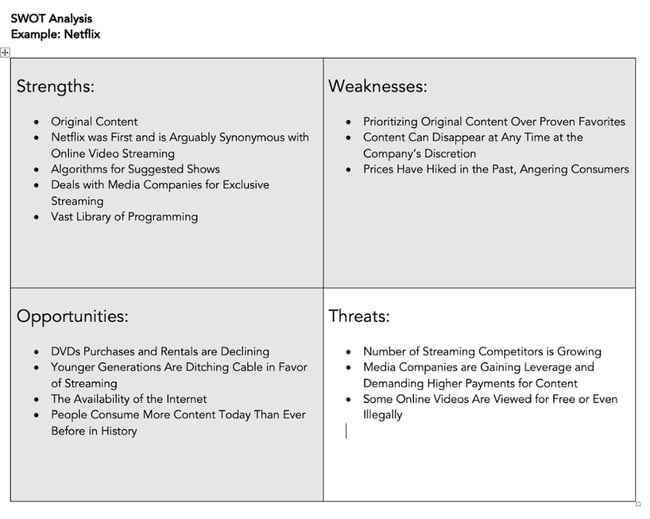
Threats are external factors that are beyond your control and pose challenges to your business. Increased competition, economic volatility, evolving regulatory landscapes, or even changing market trends are examples of threats. By proactively assessing and addressing them, you can develop contingency plans, adjust your strategies, and minimize their impact on your operations.
In a SWOT analysis, you’ll have to take both internal and external factors into account. We’ll cover those next.
.png)
Free Market Research Kit
5 Research and Planning Templates + a Free Guide on How to Use Them in Your Market Research
- SWOT Analysis Template
- Survey Template
- Focus Group Template
SWOT Analysis Internal and External Factors
A SWOT analysis typically has internal (i.e., within your organization) and external (i.e., outside your organization) factors at play. Here's a breakdown of each.
Internal Factors
Internal factors refer to the characteristics and resources within your organization that directly influence its operations and performance. These factors are completely within your organization's control, so they can be modified, improved, or capitalized upon.
In a SWOT analysis, strengths and weaknesses are categorized as internal factors. Let’s look at a few examples.
- Brand reputation
- Unique expertise
- Loyal customer base
- Talented workforce
- Efficient processes
- Proprietary technology
- Outdated technology
- Inadequate resources
- Poor financial health
- Inefficient processes
- Skill gaps within the team
External Factors
External factors are elements outside the organization's control that have an impact on its operations, market position, and success. These factors arise from the industry climate and the broader business environment. You typically have no control over external factors, but you can respond to them.
In a SWOT analysis, opportunities and threats are categorized as external factors. Let’s look at a few examples.
- Emerging markets
- Changing consumer trends
- Technological advancements
- Positive shifts in regulations
- New gaps in the market you could fill
- Intense competition
- Economic downturns
- Disruptive technologies
- Changing regulations
- Negative shifts in consumer behavior
Remember, a well-rounded SWOT analysis empowers you to capitalize on strengths, address weaknesses, seize opportunities, and navigate threats — all while making informed decisions for the future.
Now, let’s take a look at how you can write a good SWOT analysis for yourself or for stakeholders.
There are several steps you’ll want to take when evaluating your business and conducting a strategic SWOT analysis.
1. Download HubSpot's SWOT Analysis Template.
There’s no need to start from scratch for your analysis. Instead, start by downloading a free, editable template from HubSpot. Feel free to use the model yourself, or create your own as it suits your needs.
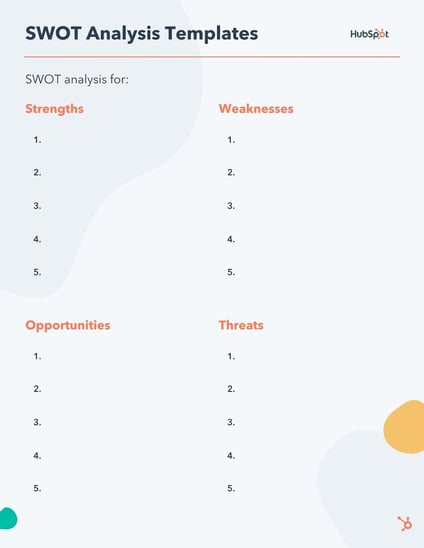
Download a free, editable SWOT analysis template.
2. Arrange each section into a table with four quadrants.
Whether you use the template above or create your own, a table format can help you visualize your SWOT analysis . This can be done by arranging each of the four sections into separate quadrants.
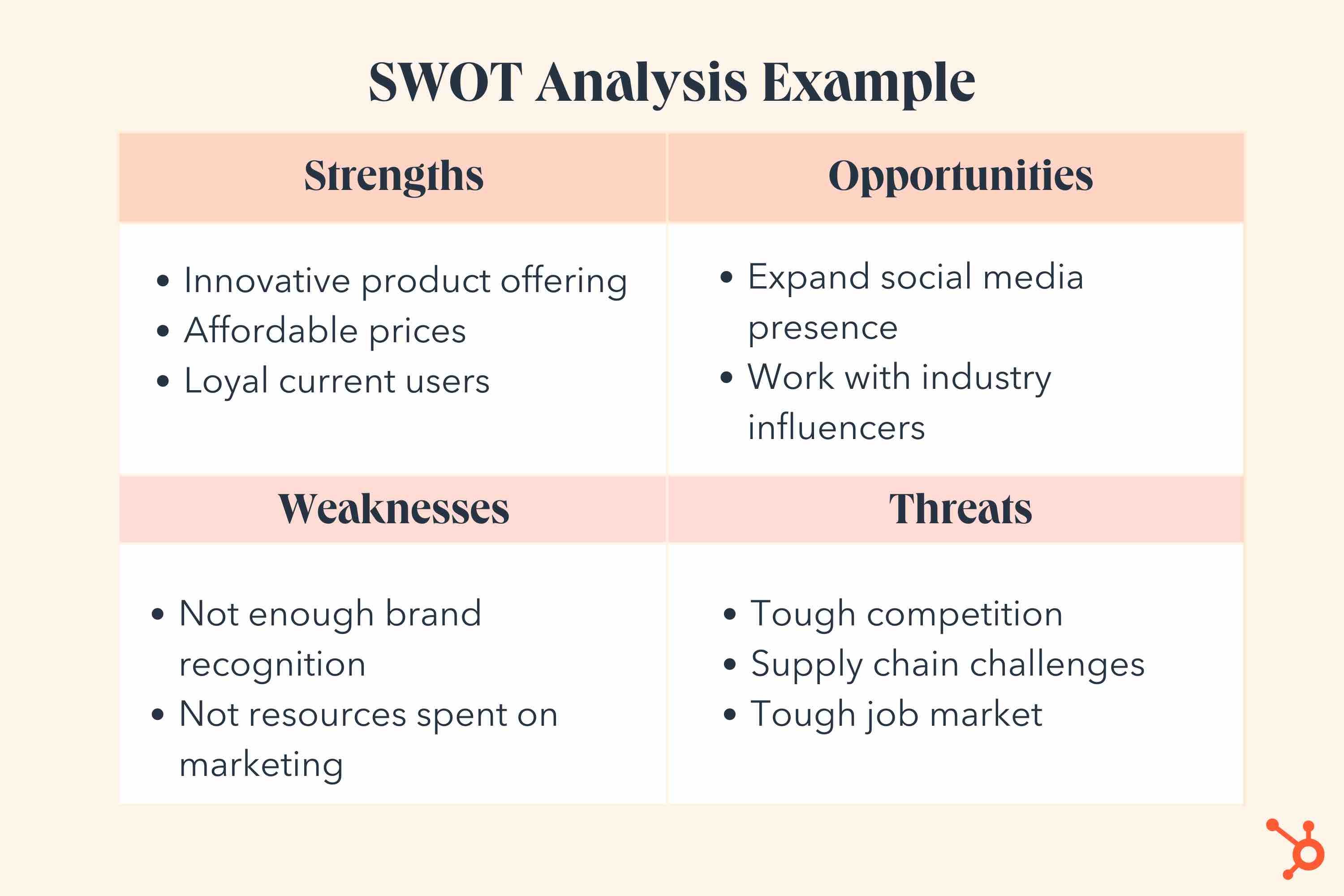
3. Identify your objective.
Before you start writing things down, you’ll need to figure out what you’re evaluating with your SWOT analysis.
Be specific about what you want to analyze. Otherwise, your SWOT analysis may end up being too broad, and you’ll get analysis paralysis as you are making your evaluations.
If you’re creating a new social media program, you’ll want to conduct an analysis to inform your content creation strategy. If you’re launching a new product, you’ll want to understand its potential positioning in the space. If you’re considering a brand redesign, you’ll want to consider existing and future brand conceptions.
All of these are examples of good reasons to conduct a SWOT analysis. By identifying your objective, you’ll be able to tailor your evaluation to get more actionable insights.
4. Identify your strengths.
“Strengths” refers to what you are currently doing well. Think about the factors that are going in your favor as well as the things you offer that your competitors just can’t beat.
For example, let’s say you want to use a SWOT analysis to evaluate your new social media strategy.
If you’re looking at a new social media program, perhaps you want to evaluate how your brand is perceived by the public. Is it easily recognizable and well-known? Even if it’s not popular with a widespread group, is it well-received by a specific audience?
Next, think about your process: Is it effective or innovative? Is there good communication between marketing and sales?
Finally, evaluate your social media message, and in particular, how it differs from the rest of the industry. I’m willing to bet you can make a lengthy list of some major strengths of your social media strategy over your competitors, so try to dive into your strengths from there.
5. Identify your weaknesses.
In contrast to your strengths, what are the roadblocks hindering you from reaching your goals? What do your competitors offer that continues to be a thorn in your side?
This section isn’t about dwelling on negative aspects. Rather, it’s critical to foresee any potential obstacles that could mitigate your success.
When identifying weaknesses, consider what areas of your business are the least profitable, where you lack certain resources, or what costs you the most time and money. Take input from employees in different departments, as they’ll likely see weaknesses you hadn’t considered.
If you’re examining a new social media strategy, you might start by asking yourself these questions: First, if I were a consumer, what would prevent me from buying this product, or engaging with this business? What would make me click away from the screen?
Second, what do I foresee as the biggest hindrance to my employees’ productivity, or their ability to get the job done efficiently? What derails their social media efforts?
6. Consider your opportunities.
This is your chance to dream big. What are some opportunities for your social media strategy you hope, but don’t necessarily expect, to reach?
For instance, maybe you’re hoping your Facebook ads will attract a new, larger demographic. Maybe you’re hoping your YouTube video gets 10,000 views and increases sales by 10%.
Whatever the case, it’s important to include potential opportunities in your SWOT analysis. Ask yourself these questions:
- What technologies do I want my business to use to make it more effective?
- What new target audience do I want to reach?
- How can the business stand out more in the current industry?
- Is there something our customers complain about that we could fix?
The opportunities category goes hand-in-hand with the weaknesses category. Once you’ve made a list of weaknesses, it should be easy to create a list of potential opportunities that could arise if you eliminate your weaknesses.
7. Contemplate your threats.
It’s likely, especially if you’re prone to worry, you already have a good list of threats in your head.
If not, gather your employees and brainstorm. Start with these questions:
- What obstacles might prevent us from reaching our goals?
- What’s going on in the industry, or with our competitors, that might mitigate our success?
- Is there new technology out there that could conflict with our product?
Writing down your threats helps you evaluate them objectively.
For instance, maybe you list your threats in terms of least and most likely to occur and divide and conquer each. If one of your biggest threats is your competitor’s popular Instagram account, you could work with your marketing department to create content that showcases your product’s unique features.
SWOT Analysis Chart
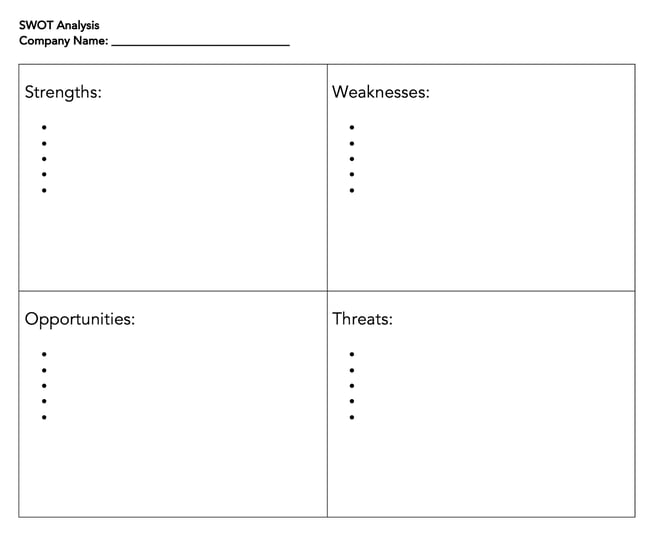
Download a free SWOT analysis chart included in HubSpot’s free market research kit .
A SWOT analysis doesn’t have to be fancy. Our SWOT analysis chart provides a clear and structured framework for capturing and organizing your internal strengths and weaknesses, and external opportunities and threats. It's the perfect visual aid to make sense of the wealth of information gathered during your analysis.
(Plus, you can always customize and paste it into a document you plan to share with stakeholders.)
But remember: Filling out the SWOT chart is just one step in the process. Combine it with our entire market research kit , and you'll have all the tools necessary to help your organization navigate new opportunities and threats.
SWOT Analysis Examples
The template above helps get you started on your own SWOT analysis.
But, if you’re anything like me, it’s not enough to see a template. To fully understand a concept, you need to see how it plays out in the real world.
These SWOT examples are not exhaustive. However, they are a great starting point to inspire you as you do your own SWOT analysis.
Apple’s SWOT analysis
Here’s how we’d conduct a SWOT analysis on Apple.

First off, strengths. While Apple has many strengths, let’s identify the top three:
- Brand recognition.
- Innovative products.
- Ease of use.
Apple’s brand is undeniably strong, and its business is considered the most valuable in the world . Since it’s easily recognized, Apple can produce new products and almost ensure a certain degree of success by virtue of the brand name itself.
Apple’s highly innovative products are often at the forefront of the industry. One thing that sets Apple apart from the competition is its product inter-connectivity.
For instance, an Apple user can easily sync their iPhone and iPad together. They can access all of their photos, contacts, apps, and more no matter which device they are using.
Lastly, customers enjoy how easy it is to use Apple’s products. With a sleek and simple design, each product is developed so that most people can quickly learn how to use them.
Next, let’s look at three of Apple’s weaknesses.
- High prices
- Closed ecosystem
- Lack of experimentation
While the high prices don’t deter Apple’s middle- and upper-class customer base, they do hinder Apple’s ability to reach a lower-class demographic.
Apple also suffers from its own exclusivity. Apple controls all its services and products in-house, and while many customers become loyal brand advocates for this reason, it means all burdens fall on Apple employees.
Ultimately, Apple’s tight control over who distributes its products limits its market reach.
Lastly, Apple is held to a high standard when it comes to creating and distributing products. Apple’s brand carries a high level of prestige. That level of recognition inhibits Apple from taking risks and experimenting freely with new products that could fail.
Now, let’s take a look at opportunities for Apple.
It’s easy to recognize opportunities for improvement, once you consider Apple’s weaknesses. Here’s a list of three we came up with:
- Expand distribution options.
- Create new product lines.
- Technological advancement.
One of Apple’s biggest weaknesses is its distribution network, which, in the name of exclusivity, remains relatively small. If Apple expanded its network and enabled third-party businesses to sell its products, it could reach more people globally, while alleviating some of the stress currently put on in-house employees.
There are also plenty of opportunities for Apple to create new products. Apple could consider creating more affordable products to reach a larger demographic, or spreading out into new industries — Apple self-driving cars, perhaps?
Finally, Apple could continue advancing its products’ technology. Apple can take existing products and refine them, ensuring each product offers as many unique features as possible.
Finally, let’s look at threats to Apple.
Believe it or not, they do exist.
Here are three of Apple’s biggest threats:
- Tough competition.
- International issues.
Apple isn’t the only innovative tech company out there, and it continues to face tough competition from Samsung, Google, and other major forces. In fact, Samsung sold more smartphones than Apple did in Q1 of 2022 , shipping 17 million more units than Apple and holding 24% of the market share.
Many of Apple’s weaknesses hinder Apple’s ability to compete with the tech corporations that have more freedom to experiment, or that don’t operate in a closed ecosystem.
A second threat to Apple is lawsuits. Apple has faced plenty of lawsuits, particularly between Apple and Samsung . These lawsuits interfere with Apple’s reputable image and could steer some customers to purchase elsewhere.
Finally, Apple needs to improve its reach internationally. The company isn’t number one in China and doesn’t have a very positive relationship with the Chinese government. In India, which has one of the largest consumer markets in the world, Apple’s market share is low , and the company has trouble bringing stores to India’s market.
If Apple can’t compete globally the way Samsung or Google can, it risks falling behind in the industry.
Starbucks SWOT Analysis
Now that we’ve explored the nuances involved with a SWOT analysis, let’s fill out a SWOT template using Starbucks as an example.
Here’s how we’d fill out a SWOT template if we were Starbucks:

Download this Template for Free
Restaurant Small Business SWOT Analysis
Some small business marketers may have difficulty relating to the SWOTs of big brands like Apple and Starbucks. Here’s an example of how a dine-in Thai restaurant might visualize each element.
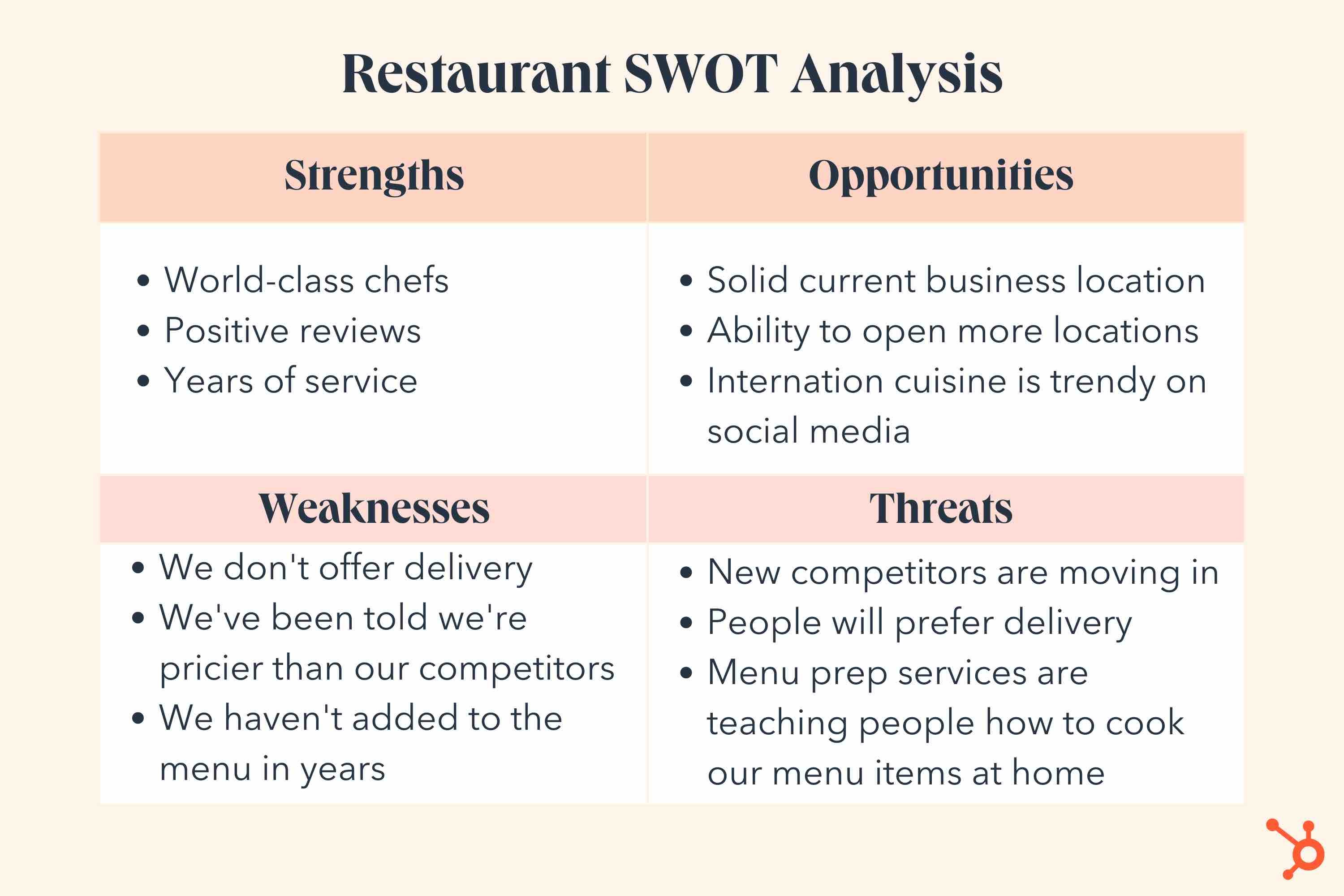
Small restaurants can lean into their culinary expertise and service skills to find opportunities for growth and brand awareness. A SWOT analysis can also help identify weaknesses that can be improved, such as menu variation and pricing.
While a restaurant might not be as worried about high-level lawsuits, a small business might be more concerned about competitors or disruptors that might enter the playing field.
Local Boutique SWOT Analysis
In another small business example, let’s take a look at a SWOT analysis for a local boutique.
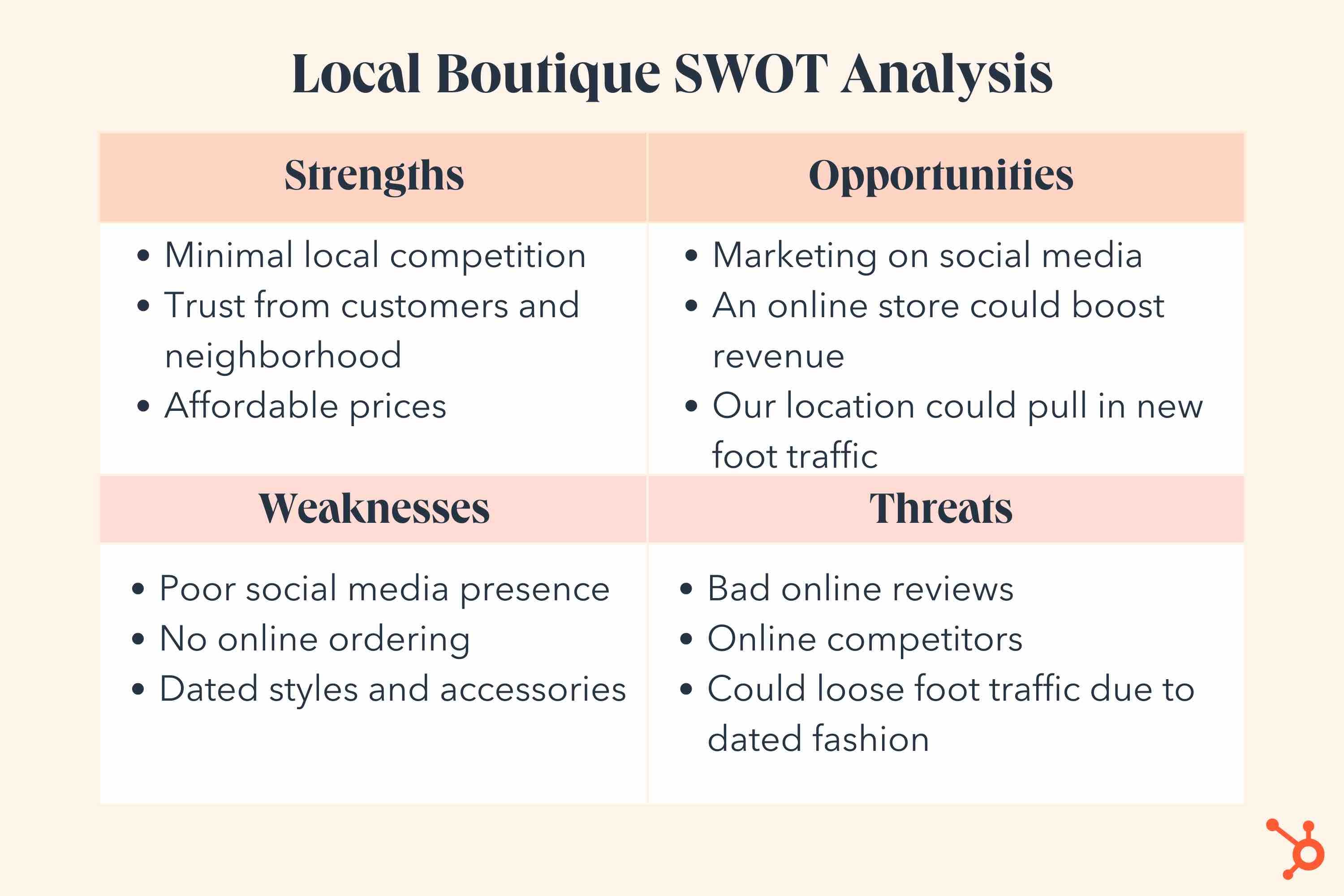
This shop might be well known in its neighborhood, but it also might take time to build an online presence or get its products in an online store.
Because of this, some of its strengths and opportunities might relate to physical factors while weaknesses and threats might relate to online situations.
How to Act on a SWOT Analysis
After conducting a SWOT analysis, you may be asking yourself: What’s next?
Putting together a SWOT analysis is only one step. Executing the findings identified by the analysis is just as important — if not more.
Put your insights into action using the following steps.
Take advantage of your strengths.
Use your strengths to pursue opportunities from your analysis.
For example, if we look at the local boutique example above, the strength of having affordable prices can be a value proposition. You can emphasize your affordable prices on social media or launch an online store.
Address your weaknesses.
Back to the boutique example, one of its weaknesses is having a poor social media presence. To mitigate this, the boutique could hire a social media consultant to improve its strategy. They may even tap into the expertise of a social-savvy employee.
Make note of the threats.
Threats are often external factors that can’t be controlled, so it’s best to monitor the threats outlined in your SWOT analysis to be aware of their impacts on your business.
When to Use a SWOT Analysis
While the examples above focus on business strategy in general, you can also use a SWOT analysis to evaluate and predict how a singular product will play out in the market.
Ultimately, a SWOT analysis can measure and tackle both big and small challenges, from deciding whether or not to launch a new product to refining your social media strategy.
Editor's note: This post was originally published in May 2018 and has been updated for comprehensiveness.

Don't forget to share this post!

Market Research: A How-To Guide and Template

20+ Tools & Resources for Conducting Market Research

What's a Competitive Analysis & How Do You Conduct One?

TAM SAM SOM: What Do They Mean & How Do You Calculate Them?
![swot analysis business case study How to Run a Competitor Analysis [Free Guide]](https://blog.hubspot.com/hubfs/Google%20Drive%20Integration/how%20to%20do%20a%20competitor%20analysis_122022.jpeg)
How to Run a Competitor Analysis [Free Guide]
![swot analysis business case study 5 Challenges Marketers Face in Understanding Audiences [New Data + Market Researcher Tips]](https://blog.hubspot.com/hubfs/challenges%20marketers%20face%20in%20understanding%20the%20customer%20.png)
5 Challenges Marketers Face in Understanding Audiences [New Data + Market Researcher Tips]

Causal Research: The Complete Guide

Total Addressable Market (TAM): What It Is & How You Can Calculate It

What Is Market Share & How Do You Calculate It?
![swot analysis business case study 3 Ways Data Privacy Changes Benefit Marketers [New Data]](https://blog.hubspot.com/hubfs/how-data-privacy-benefits-marketers_1.webp)
3 Ways Data Privacy Changes Benefit Marketers [New Data]
Free Guide & Templates to Help Your Market Research
Marketing software that helps you drive revenue, save time and resources, and measure and optimize your investments — all on one easy-to-use platform
Home » blog » Understand SWOT Analysis With 3 Examples – Netflix, Pepsico & Starbucks
Understand SWOT Analysis With 3 Examples – Netflix, Pepsico & Starbucks
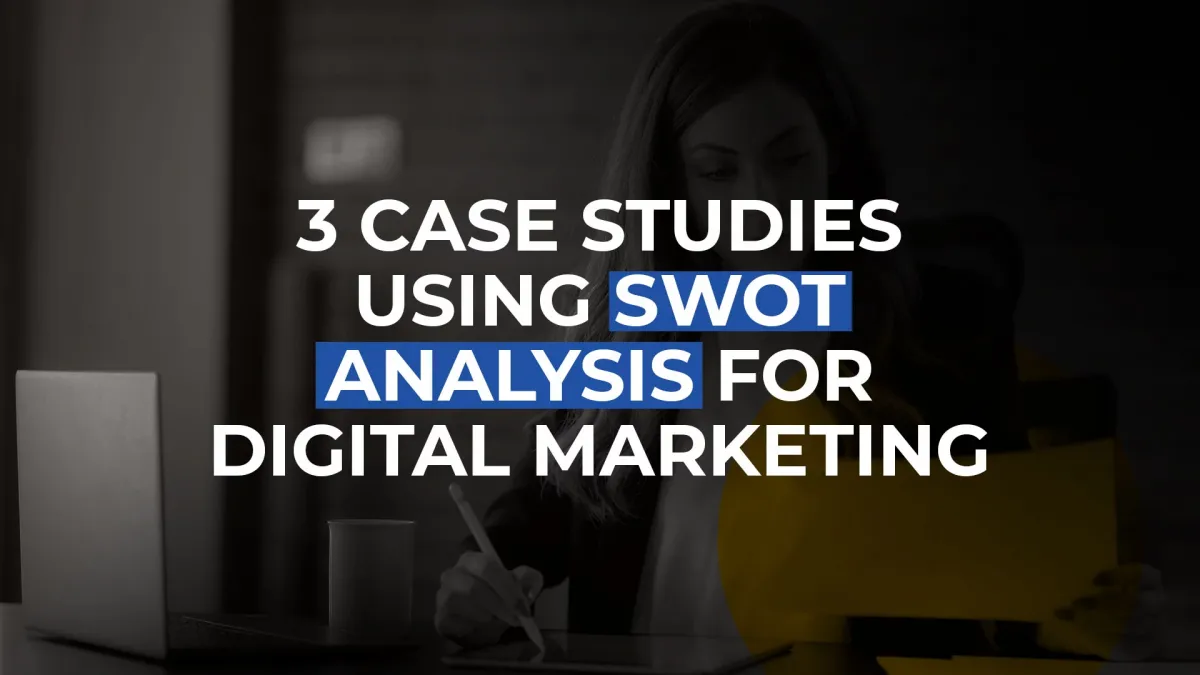
Brand marketing is an ancient art form. Did you know ancient civilizations would stamp their goods for customers to guarantee the quality? That was probably the earliest form of cultivating brand loyalty.
Then came the printing press. With it, we entered the age of pamphlets, posters and paper-centric information.
With mass media, brands made an appearance everywhere. Outside your window on a billboard, next to your favorite newspaper crossword and in between your favorite TV show.
If you follow the trail, brands go where the customers are. When the consumer moved online, all companies followed suit. We are now in the age of digital marketing. It’s an advanced form of the marketing industry that uses sophisticated techniques and technology to reach the target customer. Unlike earlier, you no longer have to shout from the rooftops about your brand. Now you can quietly slip into someone’s email or cleverly catch their attention through social media algorithms. In 2022, five billion people were on the internet. With digital marketing, not only can you effectively reach out to this massive number, but you can also personalize the message to have a significant impact. It also helps to perform a SWOT analysis in marketing as it always helps to understand your company better and enhance productivity.
What Is Digital Marketing?
Digital marketing is a form of online communication that uses different electronic media to promote brands and spread messages. People are constantly on their phones, tablets or computers. Look around, and you’ll see eyeballs glued to phone screens everywhere. That tiny piece of digital space is prime marketing real estate. You can use it to showcase ads, banners, links, direct emails and social media posts that are tailor-made to appeal to the customer. It’s an exciting opportunity to be creative yet precise. You can fine-tune your strategy to appeal to specific consumers. It is a fantastic way to generate interest in your products among potential customers as you create a unique connection.
Read more about Digital Marketing
Why Do Digital Marketing Agencies Use SWOT Analysis?
The competition between brands has never been more fierce. If you want the online user to prefer your brand and be a loyal customer, you need a structured system to form your strategy. That is what SWOT is all about. Here is the SWOT full form in marketing:
Opportunities
SWOT isn’t a new tool. It has already been implemented by companies the world over. However, it has also proven useful when it comes to digital marketing. It is a valuable method to help your business become successful and stay ahead of the competition.
What is SWOT analysis?
The SWOT method can help you create a long-term digital marketing strategy that works. It is essential to ask the right questions when doing the analysis.
Internal factors
- What is the company’s USP?
- What is the quality of services compared to other businesses?
- How strong is our brand recall?
- Do we have a strong clientele?
Weaknesses
- In which areas are we lacking productivity?
- Where are we falling behind our competition?
- What complaints have we received?
- Any internal limitations are affecting our targets?
External factors
- Will the new product fill in a gap in the market?
- Can we reach out to a larger audience?
- Is there a faster, more efficient way to increase numbers?
- Is new technology affecting our business?
- Are new products in the market taking our customers?
- Is there a lack of resources due to unforeseen circumstances?
Benefits Of Doing A SWOT Analysis In Marketing
- You can build an efficient model that helps you accurately gauge the business performance
- Analyze the organization’s internal and external strengths
- You learn how to increase visibility in the market
- Develop a plan of action that is implemented when needed
- Discover new areas of opportunities
- You can understand your business position in the market better, especially when compared to the competition
- You solve customer problems and business-related challenges
- Understand where the company needs improvement
Case studies for SWOT Analysis in digital marketing
The electronic transformation of businesses has created a paradigm shift in how companies are run. You need a high-powered digital strategy to optimize your presence across all online channels. Here are a few major companies that have successfully used product SWOT analysis to enhance their digital marketing campaign.
As one of the most viewed OTT platforms, Netflix has nearly 200 million subscribers all over the world. However, they are facing a lot of competition from other streaming services and have lost quite a few subscriptions in 2022. Here is the SWOT analysis for Netflix:
- The streaming service enjoys a strong reputation worldwide and has a big name in the market
- Award-winning, original content across various genres that is customized to every region
- Flexible services
- Uses data analytics to create algorithms for personalized recommendations
- The user-centric strategy aimed at keeping the customers happy
- Available across different media platforms such as phones, tablets and laptops
- Uses SEO, social media channels and emails to attract and retain customers
- Prime content is largely aimed at the North American region and needs to improve quality for non-English speaking areas
- Limited copyright issues which affect their profits
- Weak customer service department that influences consumer satisfaction
- Pricing is higher than the competition
- Increasing debt
OPPORTUNITIES
- Can enter other digital domains such as gaming, VR, interactive channels, etc.
- Tie up with production companies in various countries and encourage new talent to create high-quality yet localized content
- Improve social media presence by collaborating with influencers, celebrities and industry giants
- Create an innovative digital marketing strategy to promote content and create hype
- Use algorithms to personalize direct emails to every customer
- Introduce an advertising-based model to increase revenue
- Losing subscribers to cheaper services like Amazon Prime and Disney+, YouTube
- Stricter government rules in some countries can affect the content streamed there
- Saturated markets as subscription rates have slowed down
- Piracy over Netflix shows occurs all over the world, leading to several losses
What started as a beverage company to rival Coca-Cola, is now a multi-brand, diversified food giant with a steady hold over the market in many countries. However, the packaged food industry is saturated with many products. Can the company continue to command such a large share of market value?
Here is the SWOT analysis for PepsiCo:
- Overwhelming global presence in over 200 countries
- Occupies a dominant position in all major outlets, such as restaurants, supermarkets, vending machines, etc.
- Known for its award-winning advertising and traditional marketing strategies
- Targets the younger generation
- Excellent supply chain management system that reduces production costs
- Partners with major sports events and hires famous celebrities as brand ambassadors
WEAKNESSES
- The entire portfolio of products is in the ‘unhealthy’ classification, therefore a large section of the target audience, i.e. children, are not allowed to indulge often
- Spends too much money on retaining big celebrities, TV ads and other forms of traditional media
- Are responsible for contributing to major environmental issues such as excess plastic production, water and air pollution, etc.
- Have quite a few failed products in their kitty, such as Pepsi Blue
- The company has been in several controversies over the years, which has tarnished their reputation
- Expanding their presence online through various e-commerce platforms
- Increase research and development funding in the health food sector of the industry
- Adapt to changing trends by introducing newer flavors and updating older packaging to appeal to a younger audience
- Most of the younger generation is now found online
- Explore options to connect with target audiences through social media ads, online content sponsorships, banners and emails
- Hire digital content creators to add value to PepsiCo’s online presence
- Tie up with online food brands or food delivery apps
- There is intense competition in the food and beverage industry
- Many consumers are moving towards a healthier lifestyle and are well aware of the harmful effects of excess salt and sugar
- If PepsiCo doesn’t adapt to newer technology and changes in the marketplace, it will lose out to stronger competitors
- Government regulations about ‘unhealthy’ foods can affect their business
- Demographics are changing as some countries have a higher population of older people which is not PepsiCo’s target audience
- Sales are hit during economic crises and recessions
A multinational chain of coffeehouses that is also a multi-billion dollar enterprise, Starbucks is a textbook corporate success story. The organization took the humble cup of coffee and transformed it into an addictive experience. However, can they make as much of an impact with most of their customers shopping online?
Here is the SWOT analysis for Starbucks:
- Loyal customers who are devoted to buying Starbucks products
- A wide selection of premium beverages and edibles
- Cool, urban vibe that appeals to most coffee drinkers
- Huge presence and a strong reputation around the world
- Continues to be a profitable venture
- There are a lot of newer, cheaper options available on the local level in several countries
- The company is subjected to different government regulations and tax laws that exist in other nations
- It can be a challenge to procure coffee beans at competitive prices, especially from other countries
- The menu needs to change periodically to ensure customers don’t tire of the brand
OPPORTUNITIES
- The Asian markets are an untapped segment and prime for expansion
- Moving to online delivery apps can help reach a wider net of customers
- Direct marketing methods such as social media tie-ups and emailers can keep the customer aware of new products and discounts
- Use data analytics to observe the more popular, trending products and capitalize on them
- Other multinational fast-food chains such as Mcdonald’s offer cheaper coffee
- The younger generation prefers healthier or vegan options for hot beverages
- Too many sugary drinks or salty foods can be considered a ‘health hazard’
- The lack of a strong digital presence can cause the brand to lose some of its value
About The Digital Marketing Course
If you want to be the next big thing in digital marketing, you need to do a course and get certified first. A digital marketing qualification teaches you industry-centric knowledge and skills to master the genre. Once you receive your certificate, you can work in any company. Almost all organizations are now online or are getting there. As a digital marketing specialist, you will be in great demand.
Course Syllabus
Here are some of the topics that are covered in the digital marketing certification
- Internet marketing foundation
- Paid Search Marketing
- Display Advertising
- Email Marketing
Why Proschool’s Digital Marketing Course Is One Of TheBest
A good coaching center helps you holistically prepare for the digital marketing course . Proschool has a wide range of resources, innovative teaching methods and a stellar faculty to ensure you are well-equipped to join the industry. The institute has adopted active learning methods, so the students learn from real-world examples. The students are put together in groups and work as a team. The onus is to learn by ‘doing’. There is also a strong focus on skill development. Once you finish the course, you are eligible to apply for six certifications by Google, Facebook, LinkedIn, etc.
Course highlights:
- There is a 3-week that spans 20 hours
- The 3-month course has an 80-hour duration
- You receive an NSDC certification with the 3-month program
- You can attend weekend classes or do the course online
- The coaching classes cover all the subjects, including case studies using SWOT analysis
- On completion, Proschool offers all its students job placement assistance
- You are well-trained in digital marketing and ready to apply for any entry-level job
In Conclusion
Digital marketing is here to stay. Traditional companies are fast making a move online while new start-ups begin their journey in cyberspace. To help businesses grow, a SWOT analysis of digital marketing is an important tool. It draws focus on the key points of the company and areas where improvement is needed. You can do it at any time, for any reason. And the results will help you achieve your targets.
Find out more about the digital marketing course here
Share This Event!
Related posts.

How to Become a Certified Digital Marketer in 2024?

Top 10 Benefits of Taking Up a Digital Marketing Course in 2024

Top 10 Digital Marketing Courses In Chennai – Fees, Location, Syllabus etc.
Leave a comment cancel reply.
Save my name, email, and website in this browser for the next time I comment.
Join our elite club of 50,000 students upskilling in IMS Proschool Right Now

IMS Proschool – Shaping Careers, Building Lives Upskilling Professionals and Enhancing Competencies
IMS Proschool is the market leader in delivering exceptional career-building courses using intensive professional certifications.
Mumbai 9867958900
Thane 9867842800
Navi Mumbai 9867842800
Pune 8454988892
Delhi – Connaught Place 7304957442
Delhi – Pitampura 9136687002
Hyderabad 9136908879
Bangalore 7892295842
Kochi 9645629999
Kolkata 8591956474
Chennai 9600137479
Lucknow 7389180009
Online 9867994700
[email protected]
Monday – Sunday: 10:00 AM – 07:00 PM
Partner with us
- Start a Centre
- Corporate Training
- Skill Yatra
- Terms & Conditions
- Excel Financial Model
- Brochures & Ebooks
© Copyright 2012 - 2024 | All Rights Reserved
Join Over 50,000 Students Enjoying IMS Proschool E-Learning Education Now

Join Over 500,000 Students Enjoying IMS Proschool E-Learning Education Now

Join Over 500,000 Students Enjoying IMS Proschool E-Learning Education Now DBM
WhatsApp us
Enquiry Form
- Browse All Articles
- Newsletter Sign-Up
SWOTAnalysis →
No results found in working knowledge.
- Were any results found in one of the other content buckets on the left?
- Try removing some search filters.
- Use different search filters.

- Onsite training
3,000,000+ delegates
15,000+ clients
1,000+ locations
- KnowledgePass
- Log a ticket
01344203999 Available 24/7
Business Analysis Case Study: Unlocking Growth Potential for a Company
Have you ever wondered what are the necessary steps for conducting a Business Analyst Case Study? This blog will take you through the steps for conducting it.

Exclusive 40% OFF
Training Outcomes Within Your Budget!
We ensure quality, budget-alignment, and timely delivery by our expert instructors.
Share this Resource
- Business Process Mapping Training
- BCS Practitioner Certificate in Requirements Engineering
- BCS Foundation Certificate in Organisational Behaviour
- BCS Certificate in Business Analysis Practice
- Creating Effective Stakeholder Engagement Training

Table of Contents
1) An overview of the Business Analysis Case Study
2) Step 1: Understanding the company and its objectives
3) Step 2: Gathering relevant data
4) Step 3: Conducting SWOT analysis
5) Step 4: Identifying key issues and prioritising
6) Step 5: Analysing the root causes
7) Step 6: Proposing solutions and developing an action plan
8) Step 7: Monitoring and evaluation
9) Conclusion
An overview of the Business Analysis Case Study
To kickstart our analysis, we will gain a deep understanding of the company's background, industry, and specific objectives. By examining the hypothetical company's objectives and aligning our analysis with its goals, we can lay the groundwork for a focused and targeted approach. This Business Analysis Case Study will demonstrate how the analysis process is pivotal in driving growth and overcoming obstacles that hinder success.
Moving forward, we will navigate through various steps involved in the case study, including gathering relevant data, conducting a SWOT analysis, identifying key issues, analysing root causes, proposing solutions, and developing an action plan. By following this step-by-step approach, we can address the core challenges and devise actionable strategies that align with the company's objectives.
The primary focus of this Business Analysis Case Study is to highlight the significance of Business Analysis in identifying key issues, evaluating potential growth opportunities, and developing effective solutions. Through a comprehensive examination of the hypothetical company's strengths, weaknesses, opportunities, and threats, we will gain valuable insights that drive informed decision-making.
By the end of this Business Analysis Case Study, we aim to provide a holistic view of the analysis process, its benefits, and the transformative impact it can have on unlocking growth potential. Through real-world examples and practical solutions, we will showcase the power of Business Analysis in driving success and propelling companies towards achieving their goals. So, let's dive into the fascinating journey of this Business Analysis Case Study and explore the path to unlocking growth potential for our hypothetical company.
Unlock your potential as a Certified Business Analyst Professional and transform the world of business with our expert CBA-PRO training .
Step 1: Understanding the company and its objectives
In this initial step, we need to gain a thorough understanding of the hypothetical company's background, industry, and specific objectives. Our hypothetical company, TechSolutions Ltd., is a software development firm aiming to expand its customer base and increase revenue by 20% within the next year.
TechSolutions Ltd. operates in the dynamic software solutions market, catering to various industries such as finance, healthcare, and manufacturing. The company's primary objective is to leverage its technical expertise and establish itself as a leading provider of innovative software solutions. This objective sets the foundation for our analysis, enabling us to align our efforts with the company's goals.
Accelerate your career as a Business Analyst with our comprehensive Business Analyst training courses !

Step 2: Gathering relevant data
To conduct a comprehensive analysis, we need to gather relevant data pertaining to the company's operations, market trends, competitors, customer preferences, and financial performance. This data serves as a valuable resource to gain insights into the company's current position and identify growth opportunities.
For our case study, TechSolutions Ltd. collects data on various aspects, including customer satisfaction levels, market penetration rates, and financial metrics such as revenue, costs, and profitability. Additionally, industry reports, market research, and competitor analysis provide insights into market trends, emerging technologies, and the competitive landscape. This data-driven approach ensures that our analysis is well-informed and grounded in reality.
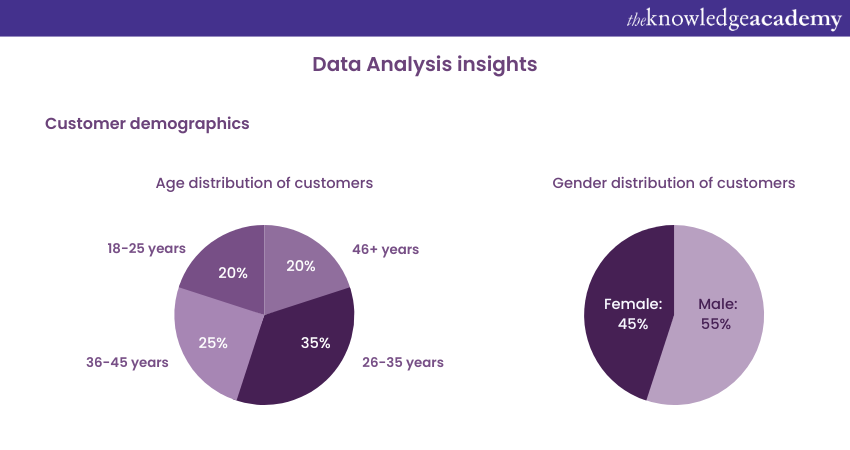
Master the fundamentals of Business Analysis and pave your path to success with our immersive Business Analyst Fundamentals training .
Step 3: Conducting SWOT analysis
A SWOT analysis is a powerful tool to assess the company's internal strengths and weaknesses, as well as external opportunities and threats. By conducting a thorough SWOT analysis, we can gain valuable insights into the company's strategic position and identify factors that impact its growth potential.
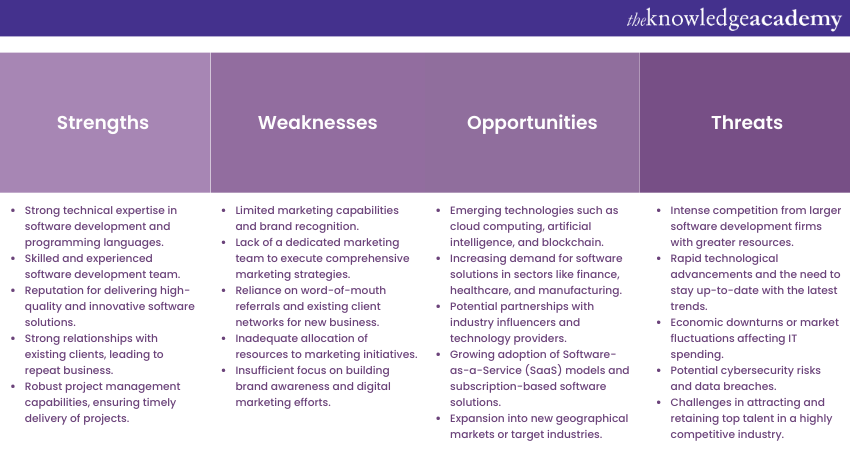
Step 4: Identifying key issues and prioritising

In the case of TechSolutions Ltd., the analysis reveals two primary issues: an outdated technology infrastructure and limited marketing efforts. These issues are prioritised as they directly impact the company's ability to meet its growth objectives. By addressing these key issues, TechSolutions Ltd. can position itself for sustainable growth.
Embark on your journey to becoming a skilled Business Analyst with our Business Analyst Green Belt training , unlocking endless opportunities!
Step 5: Analysing the root causes
To develop effective solutions, we must analyse the root causes behind the identified issues. This involves a detailed examination of internal processes, conducting interviews with key stakeholders, and exploring market dynamics. By identifying the underlying factors contributing to the issues, we can tailor our solutions to address them at their core.
In the case of TechSolutions Ltd., the analysis reveals that the outdated technology infrastructure is primarily due to budget constraints and a lack of awareness about the latest software solutions. Limited marketing efforts arise from a shortage of skilled personnel and inadequate allocation of resources.
Understanding these root causes provides valuable insights for developing targeted and impactful solutions.
Master the art of Business Process Mapping and streamline your organisation's efficiency with our expert Business Process Mapping training !
Step 6: Proposing solutions and developing an action plan
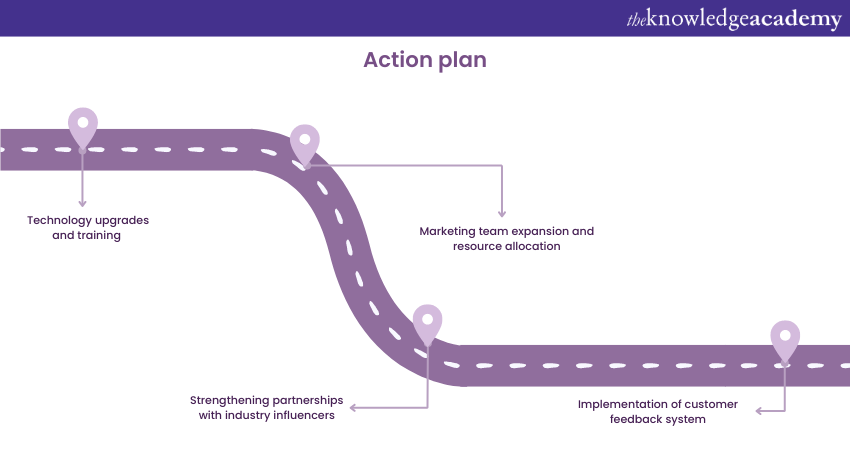
For TechSolutions Ltd., the following solutions are proposed:
a) Allocate a portion of the budget for technology upgrades and training: TechSolutions Ltd. should allocate a dedicated portion of its budget to upgrade its technology infrastructure and invest in training its employees on the latest software tools and technologies. This will ensure that the company remains competitive and can deliver cutting-edge solutions to its customers.
b) Hire a dedicated marketing team and allocate resources for targeted campaigns: To overcome the limited marketing efforts, TechSolutions Ltd. should invest in building a skilled and dedicated marketing team. This team will focus on developing comprehensive marketing strategies, leveraging digital platforms, and conducting targeted campaigns to reach potential customers effectively.
c) Strengthen partnerships with industry influencers: Collaborating with industry influencers can significantly enhance TechSolutions Ltd.'s brand visibility and credibility. By identifying key industry influencers and forming strategic partnerships, the company can tap into their existing networks and gain access to a wider customer base.
d) Implement a customer feedback system: To enhance product quality and meet customer expectations, TechSolutions Ltd. should establish a robust customer feedback system. This system will enable the company to gather valuable insights, identify areas for improvement, and promptly address any customer concerns or suggestions. Regular feedback loops will foster customer loyalty and drive business growth.
The proposed solutions are outlined in a detailed action plan, specifying the timeline, responsible individuals, and measurable milestones for each solution. Regular progress updates and performance evaluations ensure that the solutions are effectively implemented and deliver the desired outcomes.
Unleash the potential of Mathematical Optimisation for solving complex business problems with our specialised Mathematical Optimisation for Business Problems training !
Step 7: Monitoring and evaluation
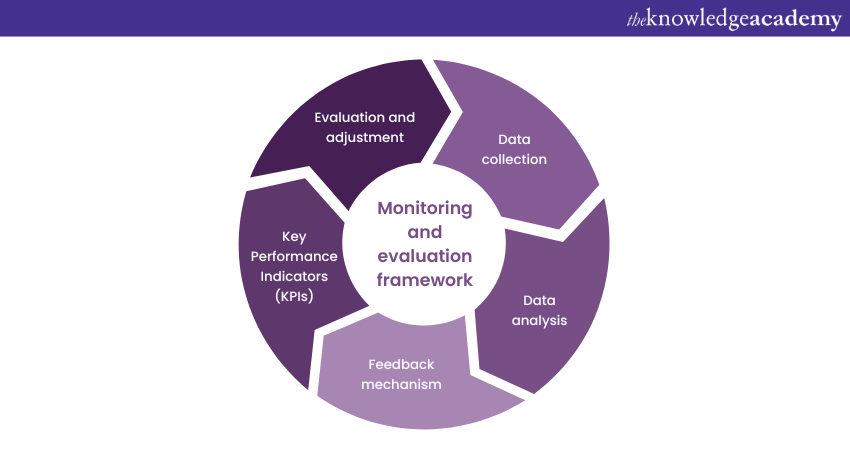
Conclusion
In this detailed Business Analysis Case Study, we explored the challenges faced by a hypothetical company, TechSolutions Ltd., and proposed comprehensive solutions to unlock its growth potential. By following a systematic analysis process, which includes understanding the company's objectives, conducting a SWOT analysis, identifying key issues, analysing root causes, proposing solutions, and monitoring progress, businesses can effectively address their challenges and drive success.
Business Analysis plays a vital role in identifying areas for improvement and implementing strategic initiatives. By leveraging data-driven insights and taking proactive measures, companies can navigate competitive landscapes, overcome obstacles, and achieve their growth objectives. With careful analysis and targeted solutions, TechSolutions Ltd. is poised to unlock its growth potential and establish itself as a leading software development firm in the industry. By implementing the proposed solutions and continuously monitoring their progress, the company will be well-positioned for long-term success and sustainable growth.
Discover the power of Business Analytics with our comprehensive Introduction to Business Analytics training , gaining valuable insights for success!
Frequently Asked Questions
Upcoming business analysis resources batches & dates.
Thu 6th Jun 2024
Thu 10th Oct 2024
Thu 19th Dec 2024
Get A Quote
WHO WILL BE FUNDING THE COURSE?
My employer
By submitting your details you agree to be contacted in order to respond to your enquiry
- Business Analysis
- Lean Six Sigma Certification
Share this course
Unlock exceptional learning at unbeatable prices.

We cannot process your enquiry without contacting you, please tick to confirm your consent to us for contacting you about your enquiry.
By submitting your details you agree to be contacted in order to respond to your enquiry.
We may not have the course you’re looking for. If you enquire or give us a call on 01344203999 and speak to our training experts, we may still be able to help with your training requirements.
Or select from our popular topics
- ITIL® Certification
- Scrum Certification
- Change Management Certification
- Business Analysis Certification
- Microsoft Azure
- Microsoft Excel & Certification Course
- Microsoft Project
- Explore more courses
Press esc to close
Fill out your contact details below and our training experts will be in touch.
Fill out your contact details below
Thank you for your enquiry!
One of our training experts will be in touch shortly to go over your training requirements.
Back to Course Information
Fill out your contact details below so we can get in touch with you regarding your training requirements.
* WHO WILL BE FUNDING THE COURSE?
Preferred Contact Method
No preference
Back to course information
Fill out your training details below
Fill out your training details below so we have a better idea of what your training requirements are.
HOW MANY DELEGATES NEED TRAINING?
HOW DO YOU WANT THE COURSE DELIVERED?
Online Instructor-led
Online Self-paced
WHEN WOULD YOU LIKE TO TAKE THIS COURSE?
Next 2 - 4 months
WHAT IS YOUR REASON FOR ENQUIRING?
Looking for some information
Looking for a discount
I want to book but have questions
One of our training experts will be in touch shortly to go overy your training requirements.
Your privacy & cookies!
Like many websites we use cookies. We care about your data and experience, so to give you the best possible experience using our site, we store a very limited amount of your data. Continuing to use this site or clicking “Accept & close” means that you agree to our use of cookies. Learn more about our privacy policy and cookie policy cookie policy .
We use cookies that are essential for our site to work. Please visit our cookie policy for more information. To accept all cookies click 'Accept & close'.

How it works
For Business
Join Mind Tools
Article • 17 min read
SWOT Analysis
Understanding your business, informing your strategy.
By the Mind Tools Content Team
What Is a SWOT Analysis?
SWOT stands for Strengths, Weaknesses, Opportunities, and Threats, and so a SWOT analysis is a technique for assessing these four aspects of your business.
SWOT Analysis is a tool that can help you to analyze what your company does best now, and to devise a successful strategy for the future. SWOT can also uncover areas of the business that are holding you back, or that your competitors could exploit if you don't protect yourself.
A SWOT analysis examines both internal and external factors – that is, what's going on inside and outside your organization. So some of these factors will be within your control and some will not. In either case, the wisest action you can take in response will become clearer once you've discovered, recorded and analyzed as many factors as you can.
In this article, video and infographic, we explore how to carry out a SWOT analysis, and how to put your findings into action. We also include a worked example and a template to help you get started on a SWOT analysis in your own workplace.
Why Is SWOT Analysis Important?
SWOT Analysis can help you to challenge risky assumptions and to uncover dangerous blindspots about your organization's performance. If you use it carefully and collaboratively, it can deliver new insights on where your business currently is, and help you to develop exactly the right strategy for any situation.
For example, you may be well aware of some of your organization's strengths, but until you record them alongside weaknesses and threats you might not realize how unreliable those strengths actually are.
Equally, you likely have reasonable concerns about some of your business weaknesses but, by going through the analysis systematically, you could find an opportunity, previously overlooked, that could more than compensate.
How to Write a SWOT Analysis
SWOT analysis involves making lists – but so much more, too! When you begin to write one list (say, Strengths), the thought process and research that you'll go through will prompt ideas for the other lists (Weaknesses, Opportunities or Threats). And if you compare these lists side by side, you will likely notice connections and contradictions, which you'll want to highlight and explore.
You'll find yourself moving back and forth between your lists frequently. So, make the task easier and more effective by arranging your four lists together in one view.
A SWOT matrix is a 2x2 grid, with one square for each of the four aspects of SWOT. (Figure 1 shows what it should look like.) Each section is headed by some questions to get your thinking started.
Figure 1. A SWOT Analysis Matrix.
Swot analysis template.
When conducting your SWOT analysis, you can either draw your own matrix, or use our free downloadable template .
How to Do a SWOT Analysis
Avoid relying on your own, partial understanding of your organization. Your assumptions could be wrong. Instead, gather a team of people from a range of functions and levels to build a broad and insightful list of observations.
Then, every time you identify a Strength, Weakness, Opportunity, or Threat, write it down in the relevant part of the SWOT analysis grid for all to see.
Let's look at each area in more detail and consider what fits where, and what questions you could ask as part of your data gathering.
Strengths are things that your organization does particularly well, or in a way that distinguishes you from your competitors. Think about the advantages your organization has over other organizations. These might be the motivation of your staff, access to certain materials, or a strong set of manufacturing processes.
Your strengths are an integral part of your organization, so think about what makes it "tick." What do you do better than anyone else? What values drive your business? What unique or lowest-cost resources can you draw upon that others can't? Identify and analyze your organization's Unique Selling Proposition (USP), and add this to the Strengths section.
Then turn your perspective around and ask yourself what your competitors might see as your strengths. What factors mean that you get the sale ahead of them?
Remember, any aspect of your organization is only a strength if it brings you a clear advantage. For example, if all of your competitors provide high-quality products, then a high-quality production process is not a strength in your market: it's a necessity.
Weaknesses, like strengths, are inherent features of your organization, so focus on your people, resources, systems, and procedures. Think about what you could improve, and the sorts of practices you should avoid.
Once again, imagine (or find out) how other people in your market see you. Do they notice weaknesses that you tend to be blind to? Take time to examine how and why your competitors are doing better than you. What are you lacking?
Be honest! A SWOT analysis will only be valuable if you gather all the information you need. So, it's best to be realistic now, and face any unpleasant truths as soon as possible.
Opportunities are openings or chances for something positive to happen, but you'll need to claim them for yourself!
They usually arise from situations outside your organization, and require an eye to what might happen in the future. They might arise as developments in the market you serve, or in the technology you use. Being able to spot and exploit opportunities can make a huge difference to your organization's ability to compete and take the lead in your market.
Think about good opportunities that you can exploit immediately. These don't need to be game-changers: even small advantages can increase your organization's competitiveness. What interesting market trends are you aware of, large or small, which could have an impact?
You should also watch out for changes in government policy related to your field. And changes in social patterns, population profiles, and lifestyles can all throw up interesting opportunities.
Threats include anything that can negatively affect your business from the outside, such as supply-chain problems, shifts in market requirements, or a shortage of recruits. It's vital to anticipate threats and to take action against them before you become a victim of them and your growth stalls.
Think about the obstacles you face in getting your product to market and selling. You may notice that quality standards or specifications for your products are changing, and that you'll need to change those products if you're to stay in the lead. Evolving technology is an ever-present threat, as well as an opportunity!
Always consider what your competitors are doing, and whether you should be changing your organization's emphasis to meet the challenge. But remember that what they're doing might not be the right thing for you to do. So, avoid copying them without knowing how it will improve your position.
Be sure to explore whether your organization is especially exposed to external challenges. Do you have bad debt or cash-flow problems, for example, that could make you vulnerable to even small changes in your market? This is the kind of threat that can seriously damage your business, so be alert.
Use PEST Analysis to ensure that you don't overlook threatening external factors. And PMESII-PT is an especially helpful check in very unfamiliar or uncertain environments.
Frequently Asked Questions About SWOT Analysis
1. who invented swot analysis.
Many people attribute SWOT Analysis to Albert S. Humphrey. However, there has been some debate on the originator of the tool, as discussed in the International Journal of Business Research .
2. What Does SWOT Analysis Stand For?
SWOT Analysis stands for Strengths, Weaknesses, Opportunities and Threats.
3. What Can a SWOT Analysis Be Used For?
SWOT analysis is a useful tool to help you determine your organization's position in the market. You can then use this information to create an informed strategy suited to your needs and capabilities.
4. How Do I Write a SWOT Analysis?
To conduct a SWOT analysis, you first need to create a 2x2 matrix grid. Each square is then assigned to one of the four aspects of SWOT. You can either draw this grid yourself or use our downloadable template to get started.
5. How Do SWOT Analysis and the TOWS Matrix compare?
While SWOT analysis puts the emphasis on the internal environment (your strengths and weaknesses), TOWS forces you to look at your external environment first (your threats and opportunities). In most cases, you'll do a SWOT Analysis first, and follow up with a TOWS Matrix to offer a broader context.
6. What Are the Biggest SWOT Analysis Mistakes?
- Making your lists too long. Ask yourself if your ideas are feasible as you go along.
- Being vague. Be specific to provide more focus for later discussions.
- Not seeing weaknesses. Be sure to ask customers and colleagues what they experience in real life.
- Not thinking ahead. It's easy to come up with nice ideas without taking them through to their logical conclusion. Always consider their practical impact.
- Being unrealistic. Don't plan in detail for opportunities that don't exist yet. For example, that export market you've been eyeing may be available at some point, but the trade negotiations to open it up could take years.
- Relying on SWOT Analysis alone. SWOT Analysis is valuable. But when you use it alongside other planning tools (SOAR, TOWS or PEST), the results will be more vigorous.
How to Use a SWOT Analysis
Use a SWOT Analysis to assess your organization's current position before you decide on any new strategy. Find out what's working well, and what's not so good. Ask yourself where you want to go, how you might get there – and what might get in your way.
Once you've examined all four aspects of SWOT, you'll want to build on your strengths, boost your weaker areas, head off any threats, and exploit every opportunity. In fact, you'll likely be faced with a long list of potential actions.
But before you go ahead, be sure to develop your ideas further. Look for potential connections between the quadrants of your matrix. For example, could you use some of your strengths to open up further opportunities? And, would even more opportunities become available by eliminating some of your weaknesses?
Finally, it's time to ruthlessly prune and prioritize your ideas, so that you can focus time and money on the most significant and impactful ones. Refine each point to make your comparisons clearer. For example, only accept precise, verifiable statements such as, "Cost advantage of $30/ton in sourcing raw material x," rather than, "Better value for money."
Remember to apply your learnings at the right level in your organization. For example, at a product or product-line level, rather than at the much vaguer whole-company level. And use your SWOT analysis alongside other strategy tools (for example, Core Competencies Analysis ), so that you get a comprehensive picture of the situation you're dealing with.
A SWOT Analysis Example
Imagine this scenario: a small start-up consultancy wants a clear picture of its current situation, to decide on a future strategy for growth. The team gathers, and draws up the SWOT Analysis shown in Figure 2.
Figure 2. A Completed SWOT Analysis.
As a result of the team's analysis, it's clear that the consultancy's main strengths lie in its agility, technical expertise, and low overheads. These allow it to offer excellent customer service to a relatively small client base.
The company's weaknesses are also to do with its size. It will need to invest in training, to improve the skills base of the small staff. It'll also need to focus on retention, so it doesn't lose key team members.
There are opportunities in offering rapid-response, good-value services to local businesses and to local government organizations. The company can likely be first to market with new products and services, given that its competitors are slow adopters.
The threats require the consultancy to keep up-to-date with changes in technology. It also needs to keep a close eye on its largest competitors, given its vulnerability to large-scale changes in its market. To counteract this, the business needs to focus its marketing on selected industry websites, to get the greatest possible market presence on a small advertising budget.
It's also possible to carry out a Personal SWOT Analysis . This can be useful for developing your career in ways that take best advantage of your talents, abilities and opportunities.
SWOT Analysis Infographic
See SWOT Analysis represented in our infographic :
SWOT Analysis helps you to identify your organization's Strengths, Weaknesses, Opportunities, and Threats.
It guides you to build on what you do well, address what you're lacking, seize new openings, and minimize risks.
Apply a SWOT Analysis to assess your organization's position before you decide on any new strategy.
Use a SWOT matrix to prompt your research and to record your ideas. Avoid making huge lists of suggestions. Be as specific as you can, and be honest about your weaknesses.
Be realistic and rigorous. Prune and prioritize your ideas, to focus time and money on the most significant and impactful actions and solutions. Complement your use of SWOT with other tools.
Collaborate with a team of people from across the business. This will help to uncover a more accurate and honest picture.
Find out what's working well, and what's not so good. Ask yourself where you want to go, how you might get there – and what might get in your way.
Download Template Worksheet
You've accessed 1 of your 2 free resources.
Get unlimited access
Discover more content
Personal swot analysis.
Seeing Strengths, Weaknesses, Opportunities, and Threats
Add comment
Comments (2)
SWOT is useless. When you try it and you find Weaknesses box bulging, but Strengths & Opportunities completely empty, what can that possibly achieve?
Leslie Bartnicki
The love of my life for 15 years was diagnosed 2 years ago at age 54. Symptoms were tremor in right leg, loss of handwriting ability, and soft voice. He also have difficulty rising from a seated position and have balance issues. he started out taking only Azilect, then Mirapex, and 6 months ago Sinemet. Several months ago he started falling frequently, hence the reason for Sinemet. We tried every shots available but nothing worked. In March 2023, my neurologist and I decided to go with natural treatment and was introduced to Natural Herbs Centre Ayurvedic organic Parkinson’s protocol, he had a total decline of symptoms with this treatment, the Tremor, falling frequently, stiffness, body weakness, balance issues, depression and others has subsided. Visit Natural Herbs Centre official website naturalherbscentre. com. This treatment is a breakthrough for all suffering from Parkinson’s, don’t give up Hope. Keep Sharing the Awareness, herbs are truly gift from God. I can personally vouch for these remedy but you would probably need to decide what works best for you

Introducing Mind Tools for Business
Mind Tools for Business is a comprehensive library of award-winning performance and management support resources.
Whether you want to increase engagement, upskill teams, or complement your existing workplace programs – this is content designed to achieve impactful results.
Sign-up to our newsletter
Subscribing to the Mind Tools newsletter will keep you up-to-date with our latest updates and newest resources.
Subscribe now
Business Skills
Personal Development
Leadership and Management
Most Popular
Newest Releases

What Are Henri Fayol's Five Functions of Management?

Henri Fayol's Principles of Management
Mind Tools Store
About Mind Tools Content
Discover something new today
Connecting remote and hybrid workers to organizational mission.
Bringing people together through a shared purpose
Is Our Partnership at Risk?
Identify Those Areas of Partnership Work Which May Have Been Left Open to Risk
How Emotionally Intelligent Are You?
Boosting Your People Skills
Self-Assessment
What's Your Leadership Style?
Learn About the Strengths and Weaknesses of the Way You Like to Lead
Recommended for you
The straw man concept.
Build It Up, Knock It Down, and Create a Solid Final Solution
Business Operations and Process Management
Strategy Tools
Customer Service
Business Ethics and Values
Handling Information and Data
Project Management
Knowledge Management
Self-Development and Goal Setting
Time Management
Presentation Skills
Learning Skills
Career Skills
Communication Skills
Negotiation, Persuasion and Influence
Working With Others
Difficult Conversations
Creativity Tools
Self-Management
Work-Life Balance
Stress Management and Wellbeing
Coaching and Mentoring
Change Management
Team Management
Managing Conflict
Delegation and Empowerment
Performance Management
Leadership Skills
Developing Your Team
Talent Management
Problem Solving
Decision Making
- SUGGESTED TOPICS
- The Magazine
- Newsletters
- Managing Yourself
- Managing Teams
- Work-life Balance
- The Big Idea
- Data & Visuals
- Reading Lists
- Case Selections
- HBR Learning
- Topic Feeds
- Account Settings
- Email Preferences
Are You Doing the SWOT Analysis Backwards?
- Laurence Minsky

Don’t worry about strengths and weaknesses until you’ve identified opportunities and threats.
The SWOT analysis is a recognized tool to identify an organization, department, product, or service’s strengths, weaknesses, opportunities, and threats. Yet, despite the tool’s wide use, it’s often conducted ineffectively, making the analysis less than insightful with no clear path to action. Part of the problem lies in focusing on internal factors — strengths and weaknesses — first. But by turning it on its head, you can conduct a better analysis that can result in more actionable strategic recommendations. First, gather an inventory of relevant environmental conditions — the threats and opportunities. Next, explore internal strengths and weaknesses. Finally, generate recommendations using this simple sentence: “Given the condition of [external factor], our ability to [internal factor] leads to our recommendation that we [recommendation].” By looking at the external conditions first and internal internal attributes second, you will generate a better set of clear-cut and supported ideas for moving forward.
There are few tools more ubiquitous in management, marketing, and other key business functions than the SWOT analysis: It involves listing the strengths, weaknesses, opportunities, and threats facing your firm, division, functional area, or other aspects of your organization, products, or services. The results of a SWOT analysis can be (and almost always are) presented simply as a 2 x 2 grid, with one dimension representing the internal versus external factors, and the other depicting positive versus negative valence.
- LM Laurence Minsky is an Associate Professor at Columbia College Chicago. His most recent books include Global Brand Management , The Activation Imperative , and Audio Branding .
- DA David Aron is Professor of Marketing and Director of Graduate Programs at Dominican University . A frequent conference presenter, his research on consumer satisfaction and marketing pedagogy has been widely published in academic journals.
Partner Center
Nykaa Case Study: SWOT Analysis, Business Model and Marketing Strategy
Nykaa is an Indian brand of beauty and cosmetic products. It was founded by Falguni Nayyar in 2012. Since then, it has evolved into a lifestyle brand offering a curated selection of 1900+ brands and 1 lakh+ products across skincare, makeup, fragrance, health, haircare, etc.
It is a dominant player in the market and is continuously trying to adapt and innovate itself to align with consumer preferences. Its omnichannel approach, curated product selection, and focus on building a loyal community position it for sustained growth in the years to come.
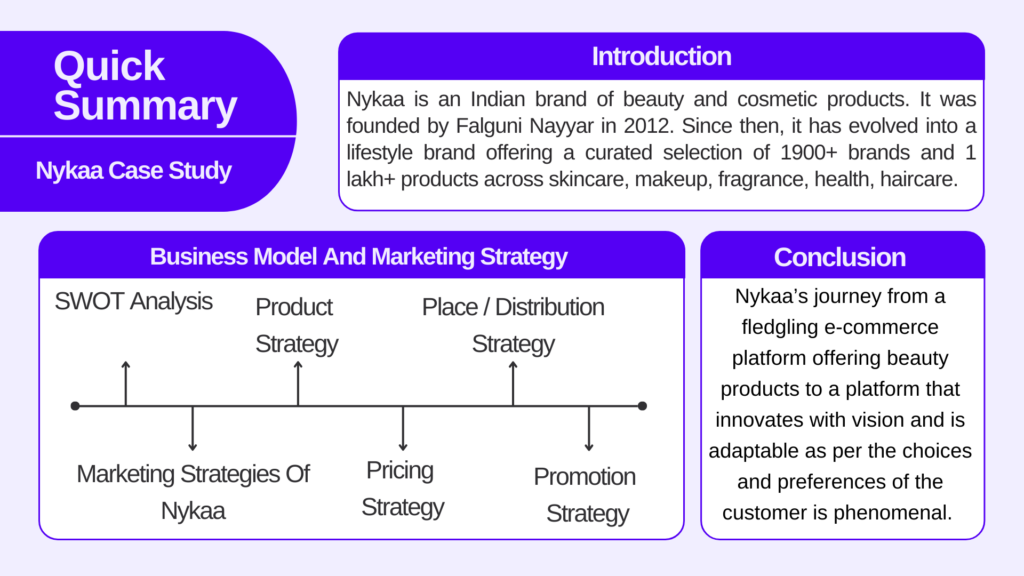
Nykaa is a public company that was initially incorporated as FSN E-Commerce Ventures Private Limited and was listed on the stock exchange in 2021. Nykaa’s shareholding pattern as of September 2023:
Nykaa’s USP includes first-mover advantage, strong brand identity in the cosmetics industry, and a data-driven approach with personalised recommendations for customers. Nykaa’s target audience is primarily women aged 18–50 and beauty influencers. Nykaa has extensively used brand marketing and social media reach to build its customers’ base. The phrase “Be Bold and Be Good” drives Nykaa and the company is still working towards its goals.
Nykaa is a D2C brand of consumer products with 145 BPC stores and 9 fashion stores across 60 cities that work on an inventory-based model, i.e., the company buys the products from the manufacturers and stores them in warehouses. Products are sold either through online apps or in offline stores.
Nykaa also has a series of in-house brands in fashion and beauty. Some of them are Nykaa Cosmetics, Kay Beauty, and Nykaa Naturals. Nykaa Fashion: 20 Dresses, Nykd by Nykaa. The apparel and accessories verticals consist of 1,350 brands.
Source-Nykaa.com
The beauty brand Nykaa faces tough competition from Purplle, Myntra, Ajio, etc. As of December 2023, Nykaa’s valuation stood at $5.94 billion. In this blog, we will be analysing strengths, weaknesses, opportunities, and threats along with Nykaa’s marketing strategy.
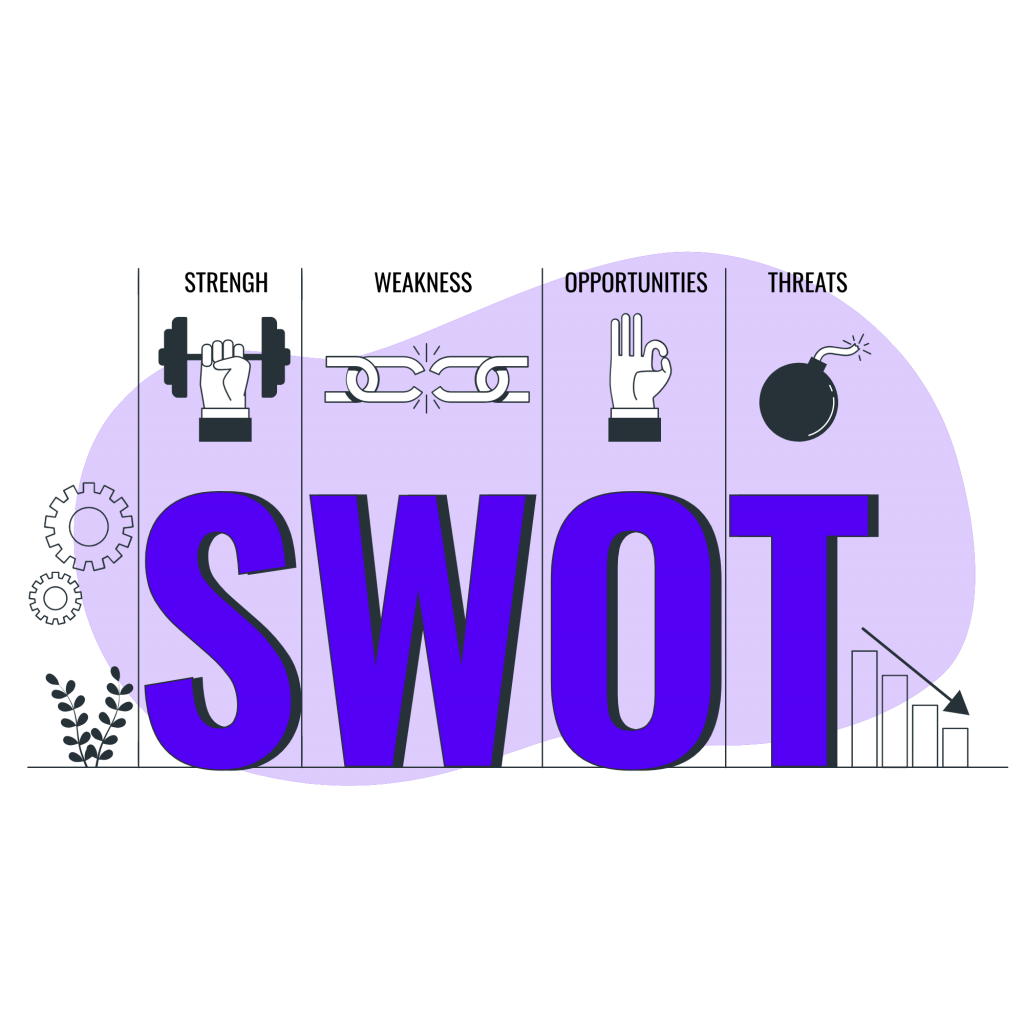
1. Nykaa captures a significant market share when it comes to online beauty. It created a strong customer base and brand loyalty, which gives the company’s first mover advantage.
2. Unlike generic e-commerce platforms, Nykaa offers a carefully curated range of authentic beauty and wellness products catering to diverse needs and preferences.
3. Nykaa’s engaging content, user-friendly interface, and social media presence fascinate the young generation of India.
4. Nykaa offers its customers a wide variety of products in various categories.
5. Nykaa has shown exponential and exemplary growth over the years with continuous expansion in its product lines.
1. Maintaining inventory and storage of beauty products can be complex and challenging, leading to stockouts and inefficiencies. This can impact the customer shopping experience negatively.
2. Nykaa also faces tough competition from other D2C brands and this can put the company under immense pressure, thereby affecting the margins.
3. No free delivery below INR 700 can make it unattractive to customers with low budgets.
4. Nykaa hardly spends on research and development activities, which can limit its capacity to compete with other beauty brands, and as a retail business with both offline and online presence, functioning without proper R&D can lead to operational challenges.
5. Overdependence on the female demographic can affect the business.
1. Nykaa can tap international markets, which can help the company increase its customer base and revenue.
2. Acquisitions of niche brands can cater to the needs of customers and create a new customer base.
3. The existing loyalty programme of the brand can be enhanced and improved with some exclusive offerings, which can eventually help boost customer retention.
4. Nykaa can further invest in AI-powered solutions for product recommendations, chatbot customer service, and AR/VR beauty consultations. This can improve operational efficiency and potential customers.
1. Tough competition from other brands is a threat for Nykaa, as this can move their price-conscious customers to other websites.
2. Evolving consumer preferences and buying behaviour can be a threat to the beauty brand if it does not align with the changing trend.
3. At the time of listing, the company’s valuation stood at $15.36 billion. A significant decline can be seen in the valuation of the company post-listing. Further, as of December 2023, the company is trading at a P/E of INR 2,483, which is high as compared to its peers.
4. Evolving technologies like augmented reality (AR) and virtual reality (VR) offer try-on methods to customers. If not implemented with a seamless experience, it can be a threat to Nykaa.
Marketing Strategies of Nykaa

1. Product Strategy
Nykaa is currently offering a diverse range of 1500+ beauty and wellness products. The company has also recently launched its product brand, which is adding an extra dimension to its product basket. Nykaa aims to be a one-stop destination for people of all age groups and offers beauty products from both national and international brands with a presence across major markets like the U.A.E., Mauritius and the U.S.A.
It tries to offer curated products suitable for various skin tones and types to its customers that align with their needs and are also in trend. The brand also launches limited-edition products and collaborates with celebrities and influencers to create exclusive collections. It personalizes the product experience by offering recommendations based on individual purchase histories and reviews from other users. The brand also promotes environment-friendly packaging to promote sustainability.
Nykaa has also launched Nykaa fashion and Nykaa men. We can say that the product strategy of Nykaa is dynamic.
2. Pricing Strategy
The company generally focuses on cost-based pricing, where it analyses the cost of acquiring and distributing products and adds a markup to decide the final price, and prestige pricing, where the company has collaborated with different luxury brands like MAC, Anamoly, Aveda, etc. to justify the higher prices.
Nykaa runs promotional campaigns, discounts, and special offers during festive sales to attract customers and drive sales. It also offers diverse payment options, including cash on delivery, credit card EMI, and buy-now-pay-later schemes, making purchases accessible to a broader customer base.
3. Place / Distribution Strategy
Nykaa’s omnichannel presence has helped the company evolve over the years. The brand provides three options to customers. They can visit either Nykaa’s luxe store for a premium shopping experience or on-trend stores for budget shopping. The third option is to buy products online via Nykaa’s web and mobile app.
In recent years, the company has tried to expand its network. It has collaborated with different logistics partners to offer flexible delivery options like express delivery and scheduled delivery in some locations.
4. Promotion Strategy
Nykaa engages itself in blog posts, makeup tutorials on Youtube and articles for spreading informative content among the audience. This creates a sense of trust among the customers. The company also collaborates with influencers to promote its trendy products. It sends targeted emails to customers based on their purchase history, preferences, and interests, offering personalized recommendations and promotions.
Nykaa leverages influencers through its customised creator-focused product and program called Nykaa affiliate program, which enables external content creators to publish content on behalf of the company across several digital platforms. Further, the company continuously post deals and giveaway alerts on social sites to attract customers.
Nykaa’s journey from a fledgling e-commerce platform offering beauty products to a platform that innovates with vision and is adaptable as per the choices and preferences of the customer is phenomenal. The brand knows well how to capitalise on opportunities. It has carved out a significant niche in the Indian market and has the potential to further expand its business, shaping the future of the beauty market.
If you have enjoyed reading our blog, check out the related case study: Flipkart Case Study- Business Model and Marketing Strategy .
Frequently Asked Questions (FAQs)
1. Who founded Nykaa?
Ans. Nykaa was founded by Falguni Nayyar in 2012.
2. Is Nykaa target market only for females?
Ans. No, Nykaa is not only for females; it also sells grooming and personal care products for men.
3. Is Nykaa a public company?
Ans. Yes, Nykaa is a public company listed on the NSE & BSE.
4. Who are the competitors of Nykaa?
Ans. Nykaa faces tough competition from Purplle, Myntra, Ajio, etc.
5. What is the biggest sale introduced by Nykaa ?
Ans. The biggest sale of Nykaa is the “Nykaa Pink Friday sale”.
Disclaimer : The securities, funds, and strategies mentioned in this blog are purely for informational purposes and are not recommendations.
Related Posts
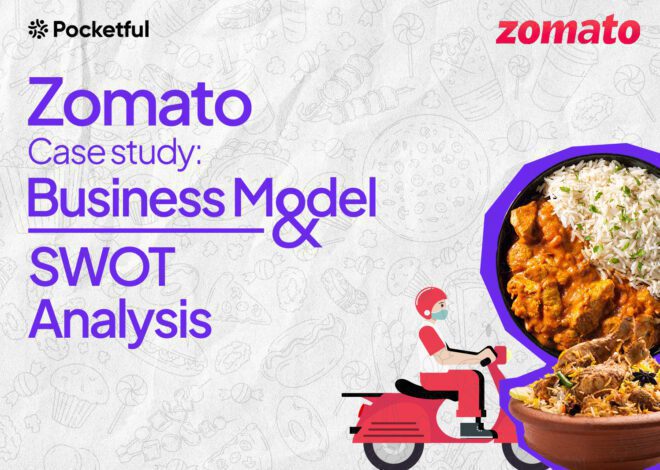
Zomato Case Study: Business Model, Acquisitions, KPIs, Financials, and SWOT Analysis

Gopal Snacks IPO: Segments, Financials, Key Details, Strengths, and Weaknesses

Pune E-Stock Broking Limited IPO: Key Details, Business Model, Financials, Strengths, and Weaknesses
We are a concern of pace group. pocketful is an investing platform that helps people be better investors. pocketful unlocks the discoverability of new investment and trading ideas., quick links.
- Open an Account
- Pocketful Web
- Pocketful App
- Investment Tool
- Trading Tool
- Support Portal
- Referral Program
- Calculators
- Stocks Pages
- Government Schemes
- Index Heat Map
- Stock Screener
- Mutual Funds
- Terms & Conditions
- Policies & Procedures
- Press & Media
- The Open University
- Explore OpenLearn
- Get started
- Create a course
- Free courses
Collections
My openlearn create profile.
- Personalise your OpenLearn profile
- Save Your favourite content
- Get recognition for your learning
Already Registered?
- Text and media area
- Support your understanding of the SWOT Analysis to...
- 1 When to use a SWOT analysis
- 2 Exploring the environment of a project
- 3.1 Strengths and weaknesses
- 3.2 Opportunities and threats
- 4 Completing the SWOT analysis
5.1 SWOT analysis: a case study
- Self Assessment Questions
- End of Module Quiz
- References and acknowledgements
- Return to the DIY Learn home page
- SWOT Analysis quiz
- DIY Toolkit
Download this course
Download this course for use offline or for other devices.
The materials below are provided for offline use for your convenience and are not tracked. If you wish to save your progress, please go through the online version.
About this course
- 2 hours study
- 0 Level 0: Beginner
- Course description
Course rewards
Free Statement of Participation on completion of these courses.
Earn a free digital badge if you complete this course, to display and share your achievement.

If you create an account, you can set up a personal learning profile on the site.
Read through the case study and SWOT Analysis Template, then try to complete the activity below.
Case study 1: Syed’s business opportunity
Syed runs his own enterprise in an area on the outskirts of Dhaka, Bangladesh. He manages a collective of people with disabilities who make Bangladeshi puppets in a traditional style, mainly selling to tourists through local shops, and pays them a basic salary as well as a profit share. The puppets are all made to Syed’s own designs, and are quite different to the standard items in most tourist stores. His quirky designs and their popularity with shoppers have come to the attention of Muhammad, who runs a relatively large factory producing puppets and other tourist-friendly wares. Muhammad approaches Syed to suggest that he buy his enterprise, including his designs, and that Syed and his employees all come and work at Muhammad’s factory. He is offering a lot of money, and Syed doesn’t know whether he wants to maintain his independence or go for the security offered by a lump cash sum and guaranteed employment. He uses a SWOT analysis to take a snapshot of his current situation and help him consider the decision:
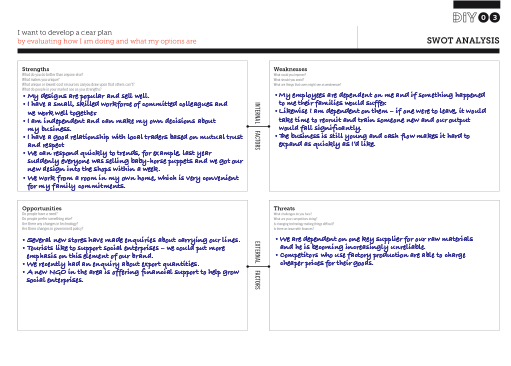
Looking at the case study above, including Syed’s SWOT analysis, imagine you are helping Syed make his decision. What points would you highlight? Would you recommend him to sell to Muhammad? Make some notes in answer to this question in the text box below.
Syed has provided some interesting information in his SWOT analysis. By taking a realistic look at his business as it is, he can decide what is most likely to make sense for its future. There’s no absolute right or wrong here (there rarely is in this sort of decision-making), but based on the information given I would advise Syed not to sell. These are the key points I would highlight:
- Syed has a lot of strengths, mainly based on the very fact that the organisation is small and under his management.
- Being dependent on one supplier is always a risk, especially now they are becoming unreliable. However, there’s no reason he couldn’t identify other suppliers and shop around to get a good deal and spread the risk by regularly using two or three.
- Syed has said that cash flow is a weakness that stops him from expanding. It sounds like now would be a great time to explore the financial support from the new NGO, as this would enable him to respond to some of the other opportunities (new shops and the potential for export) at his own pace and under his control.
- If he expands, perhaps he could take on some new employees part time? If he has, say, four employees who work half time rather than two who work full time, he has spread the risk of his dependency – if someone is ill or leaves, one or more of the others might be able to increase their hours.
- If he agrees to Muhammad’s offer, he will lose his independence and have to commute to a different workplace. Will the people he works with be able to commute, or in practical terms will this mean they become unemployed (and how might he feel about that)? More people will see and buy his designs, but will his name or mark be on them?
- What if he explores the opportunities for expansion that the SWOT analysis has highlighted, and then considers whether the offer looks tempting?
Finally, I would perhaps suggest that this isn’t a yes or no decision, and there might be a way that Syed could maintain all his strengths but still work in partnership with Muhammad. He could create some designs especially for Muhammad’s factory, and/or draw on some of his resources in exchange for design expertise. At this point, a SWOT analysis of the potential partnership could be a useful decision-making tool.
5 Using the SWOT analysis for decision making
For further information, take a look at our frequently asked questions which may give you the support you need.
Have a question?
If you have any concerns about anything on this site please get in contact with us here.
Report a concern
Table of Contents
What is swot analysis, swot analysis process, how to do a swot analysis for your business, swot analysis for business analysts, the ultimate guide to swot analysis for business and why it matters.

To run a business successfully and efficiently, business analysts need to regularly analyze a number of things and processes. There are a number of ways a business analyst assess a business, but one of the most effective methods out there is to conduct a SWOT analysis for business.
A SWOT analysis is a planning technique used to determine a business’ strengths, weaknesses, opportunities and threats. The primary objective of performing a SWOT analysis for business is to help organizations overcome challenges and decide what new leads to pursue.
SWOT analysis was created by Albert Humphrey of the Stanford Research Institute during the 1960s to identify why corporate plans fail. Ever since its inception, it has become one of the most useful tools used in the growth of any business.
SWOT analysis involves four main areas - Strengths, Weaknesses, Opportunities, and Threats. It includes both internal and external components, which are equally important for the success of a business. Here is a brief summary of the SWOT analysis process:
In a SWOT analysis, strength refers to the attributes within an organization that are necessary for the success of a project and ultimately, the success of a business. It can comprise all resources and capabilities that can be used at a competitive advantage. Some example of strengths of a business include:
- Good company reputation
- Strong social media presence
- Skilled and knowledgeable staff
- Qualities that make you stand out from your competitors
Any factor that could prevent successful results within a project are called weaknesses. You need to enhance these weaknesses in order to beat your competitors. Some examples of weaknesses of a business include:
- Lack of appropriate funding
- Rivalry between departments
- Weak internal communication system
- Unclear unique selling proposition
Opportunities of a business are those external elements that could be potentially helpful in achieving the goals of a project. They might come in the form of developments in the market you are in, the technologies you use, etc. You need to be able to spot and seize these opportunities for the long-lasting success of a business. Some examples of opportunities of business include:
- Media coverage for your company
- Emerging need for your products or services
- Few competitors in your market
- Overflowing leads
Threats can be anything that poses a potential risk for the success and growth of a business. It is important to anticipate threats and take action against them before they become a more serious problem. Some examples of threats of a business include:
- Negative public image
- Cheaper and better products and services
- Changes in laws and regulations
- Lack of vendors to supply raw materials
Become a Business and Leadership Professional
- Top 10 skills in demand Business Analysis as a skill in 2020
- 14% Growth in Jobs of Business Analysis profile by 2028
- $85K Average Salary
Post Graduate Program in Business Analysis
- Certificate from Simplilearn in collaboration with Purdue University
- Become eligible to be part of the Purdue University Alumni Association
Business Analyst
- Industry-recognized certifications from IBM and Simplilearn
- Masterclasses from IBM experts
Here's what learners are saying regarding our programs:
I was keenly looking for a change in my domain from business consultancy to IT(Business Analytics). This Post Graduate Program in Business Analysis course helped me achieve the same. I am proficient in business analysis now and am looking for job profiles that suit my skill set.
Assistant Consultant at Tata Consultancy Services , Tata Consultancy Services
My experience with Simplilearn has been great till now. They have good materials to start with, and a wide range of courses. I have signed up for two courses with Simplilearn over the past 6 months, Data Scientist and Agile and Scrum. My experience with both is good. One unique feature I liked about Simplilearn is that they give pre-requisites that you should complete, before a live class, so that you go there fully prepared. Secondly, there support staff is superb. I believe there are two teams, to cater to the Indian and US time zones. Simplilearn gives you the most methodical and easy way to up-skill yourself. Also, when you compare the data analytics courses across the market that offer web-based tutorials, Simplilearn, scores over the rest in my opinion. Great job, Simplilearn!
SWOT analysis for business is best conducted among a group of people with different perspectives and stakes in a business. Upper management customer service, sales, marketing, and even customers can provide valuable insights.
SWOT analysis matrix
Traditionally, a SWOT analysis is conducted by using a four-square SWOT analysis template where there is a box for each of the four components - strengths, weakness, opportunities, and threats. This makes it easier to have a glance at all the components in one go. However, you can just make a simple list as well for each component. The best method is the one which will make it easier for you to organize and understand the results.
These are the various steps that you can take to perform a SWOT analysis for business:
Step 1: Identify Your Strengths
Strengths are internal to your company and within your call. The first step is all about identifying all of your best assets. Here are some questions to get you started.
- Why do your customers stay?
- Why does your business do well?
- What is your unique selling point (USP) that sets you apart from competitors?
Step 2: Evaluate Your Weaknesses
Weaknesses are also internal factors that can break your business or leave you at a competitive disadvantage. The questions you can ask to identify some of your main weaknesses are:
- In which areas does your business struggle?
- Why do customers select your competitors over your business?
- What stops you from performing your best?
Step 3: Look Out for New Opportunities
In order to find new opportunities for your business, you need to do a lot of research. For this section of the SWOT analysis, you can think outside of the box for any possible thing that would be good for the business. One of the most important things you need to do is market research to gauge new and upcoming changes.
Step 4: Identify Threats
The most difficult part of SWOT analysis for business is to come up with a list of potential threats because you never know what can hit you. It may also cause some anxiety to think about threats, but it’s better to identify them before they turn into bigger problems in the future. List out all the threats, no matter how minor you think it might be. Even though it may not have severe consequences to watch out for, it is always better to have it on your radar so that you are ready whenever it becomes a major problem.
Step 5: Develop Actionable Strategies
Once you’ve come up with a list of each of your strengths, weaknesses, opportunities and threats, you can start developing actionable strategies from them using a technique called TOWS analysis.
TOWS analysis example
TOWS analysis is an extension of SWOT analysis and involves matching up your strengths, opportunities, threats, and weaknesses to develop actionable strategies.
Gain expertise in the latest Business analytics tools and techniques with the Business Analyst Master's Program . Enroll now!
A business analyst needs to know the working knowledge of SWOT analysis and its applications. A business analyst can utilize SWOT analysis in a number of ways:
- To ascertain the viability of a proposed solution
- To identify new opportunities in a domain or sector
- To find better alternatives for an existing solution
- To analyze a system undergoing change
- To study and research about business competition
If you want to learn more about SWOT analysis and other tools for business analysts, Simplilearn’s Business Analysis Certification Program will enhance your expertise in all the latest business analyst tools and techniques. This Post Graduate program will provide you with real-world examples and case studies to make you market-ready for any industry.
Our Business And Leadership Courses Duration And Fees
Business And Leadership Courses typically range from a few weeks to several months, with fees varying based on program and institution.
Learn from Industry Experts with free Masterclasses
Data science & business analytics.
Program Overview: How Purdue University Can Help You Succeed in Business Analysis
Business and Leadership
Program Overview: The Reasons to Get Certified in Business Analysis in 2023
Program Preview: Post Graduate Program in Business Analysis
Recommended Reads
Free eBook: Guide To The CCBA And CBAP Certifications
The Ultimate Guide to Business Impact Analysis
A Holistic Look at Tesla SWOT Analysis
Digital Marketing Salary Guide 2021
What Is Data Analysis: A Comprehensive Guide
A Complete Guide to Get a Grasp of Time Series Analysis
Get Affiliated Certifications with Live Class programs
- PMP, PMI, PMBOK, CAPM, PgMP, PfMP, ACP, PBA, RMP, SP, and OPM3 are registered marks of the Project Management Institute, Inc.

SWOT Analysis of IKEA 2023

This is IKEA International Group SWOT analysis. For more information on how to do a SWOT analysis please refer to our article.
Company Overview
You can find more information about the business in its official website or Wikipedia’s article .
IKEA SWOT Analysis
- Customer knowledge. One of the key competitive advantages IKEA has is its extensive knowledge about the customers. The company understands the purchasing factors that influence customers to buy and implements the best practices to induce that decision. IKEA offers low prices and a huge range of products. Designers constantly introduce new design products that look stylish in the eyes of customers. All the products are designed so it would be easy to transport and assemble. Moreover, the company offers the widest product range and positive shopping experience. All of these factors are aligned with what customers want and need and which results in higher sales. Without such extensive customer knowledge and best practices to benefit from that knowledge, IKEA would be unable to outcompete its current competitors.
- Constantly using innovations to drive costs down. Low prices are the cornerstone of IKEA business idea and the the company always try to do things as efficient and cost-effective as possible. To drive costs down all the time, the company must find new and innovative ways to do that and to incorporate them in its businesses model. The business’ innovations include new materials that contribute more to sustainable environment and are less costly or using newest ways of packaging, handling and transporting materials.
- Supply chain integration. IKEA is committed to long lasting relationships with its suppliers. In this way, the company can order large volumes and benefit from lower prices and greater quality while suppliers are assured of guaranteed orders. IKEA sources its materials close to suppliers to reduce transporting costs. The company also uses IWAY approach to closely integrate suppliers with its supply chain. All the efforts of closely integrating supply chain results in lower costs and a competitive advantage.
- Brand reputation and market presence. According to Interbrand, IKEA is the most valuable furniture retailer brand in the world, valued at nearly $US 12.8 billion in 2012. The business operates 332 stores in 38 countries and is present in the major world markets. More than 600 million customers visit IKEA stores every year. Worldwide market presence and strong brand reputation ensures that customers will often choose IKEA over its competitors.
- Diversified product portfolio. Unlike IKEA’s largest competitors, the company has fairly diversified businesses. In addition to its furniture products, the company operates restaurants, houses and flats. Although, firm’s main business is designing, manufacturing and selling furniture it is not so affected by the changing forces in this market as other furniture retailers.
- Negative publicity. The company has been criticized many times for issues like poor treatment of employees, questionable advertising practices or lobbying government authorities. Negative publicity decreases brand reputation and customer loyalty.
- Low quality of products and services. IKEA is unable to find compromise between continuous cost reductions while maintaining the same quality of products. According to UK Customer Insights report on IKEA by Verdict, IKEA’s customers are less satisfied with its product and services quality than the average customer in UK buying at other stores. Firm’s cost reductions lead to decreasing product quality, which was followed by higher number of products returned and damaged brand.
- Standard products. IKEA’s main competitive advantage derives from low costs, which in part are achieved due to standardized products. Standardized products attract fewer customer segments. Therefore, the business inability to offer better quality more customized products allows its competitors to fill that niche and fortify their position in it.
- Further expansion into developing economies. Retail markets grew by at least 5% on average in emerging markets in the last year, opening huge opportunities for IKEA’s revenue growth. The company currently operates in most of the developed economies but hasn’t firmly stepped into developing economies, except China. There are great opportunities for IKEA to expand into Brazil, Mexico, Indonesia and Malaysia to increase its presence in these markets to sustain future growth.
- Growing online sales. Online retail sales account for 17% and 4% of total retail sales in UK and US respectively. Online sales grow constantly and with 870 million visitors to its website IKEA could exploit this opportunity and benefit from increased sales and lower costs.
- Expansion to growing grocery market. The current trend of eating healthier food has resulted in higher demand for grocery products in many developed economies. IKEA has an opportunity to expand its grocery business by introducing more grocery stores in its current retail places. The company is already successfully managing its food outlets, so this expansion opportunity would be well aligned with the current operations.
- Intensifying competition. Many low cost retailers such as Walmart, ASDA or Tesco are entering homeware specialists market where IKEA operates. These large retailers have similar specifics as IKEA, including low costs, well managed supply chain and huge market presence and can easily gain some market share from IKEA.
- Growth of average consumer income. Growth of average consumer income means that people buy less low price and low quality products, which is exactly what IKEA offers in its stores. With the rising income people will be less attracted to IKEA and will turn to retailers that offer higher quality homeware products.
- IKEA (2013). About IKEA. Available at: http://www.ikea.com/ms/en_GB/about_ikea/index.html
- The Times 100 (2012). Business Case Studies. Ikea case study. Available at: http://businesscasestudies.co.uk/ikea/swot-analysis-and-sustainable-business-planning/strengths.html#axzz2VB9TPpjz
- Interbrand (2012). Best Global Brands in 2012. Available at: http://www.interbrand.com/en/best-global-brands/2012/Best-Global-Brands-2012.aspx
- Wikipedia (2013). IKEA. Available at: http://en.wikipedia.org/wiki/IKEA
- IKEA Mission Statement
- SWOT Analysis of Walt Disney 2023
- SWOT Analysis of Blackberry 2023
- SWOT analysis of BMW 2023
- SWOT Analysis of eBay 2023
Leave a Comment Cancel reply
Save my name and email in this browser for the next time I comment.
- Home
- Student Scholarship
- Honors Theses
Case Study of TATA Motors: SWOT Analysis and Strategy Suggestions

entitlement
Export search results
The export option will allow you to export the current search results of the entered query to a file. Different formats are available for download. To export the items, click on the button corresponding with the preferred download format.
By default, clicking on the export buttons will result in a download of the allowed maximum amount of items.
To select a subset of the search results, click "Selective Export" button and make a selection of the items you want to export. The amount of items that can be exported at once is similarly restricted as the full export.
After making a selection, click one of the export format buttons. The amount of items that will be exported is indicated in the bubble next to export format.
Send us an email
How to build a competitive analysis report with examples and tools
Written by by Juliet John
Published on March 7, 2024
Reading time 8 minutes
Your company is launching a new product, eyeing a new market segment or contemplating a strategic pivot—as a seasoned marketer, your first move would be to conduct a competitive analysis. This exercise is elementary to uncover critical insights about the new market and gain visibility into the competitive landscape.
However, beyond research, there’s the crucial task of distilling those insights into actionable strategies that’ll give your business an advantage. This is where competitive analysis reports become critical, providing you a roadmap for translating raw data into strategic direction.
In this guide, we’ll explore how competitive analysis reports benefit your business, how you can build effective reports, the areas to focus on and competitive reporting tools.
What is a competitive analysis report?
A competitive analysis report is a strategic document that examines the position and performance of your competitors in your business. The report synthesizes your competitive intelligence research data and provides conclusions for better decision-making. It helps you understand the competitive landscape, identify areas for innovation or improvement and formulate strategies to outperform competitors.

A competitive analysis report typically contains information on marketing tactics, target audience demographics, product comparison and industry trends.
Benefits of a competitive analysis report
A competitive analysis report serves as a tool for competitor benchmarking . You can use it as a standard for realistic goal setting, accessing your business performance and measuring growth.
Let’s dive into some more key benefits.
Know where your business stands in the market
A good competitive analysis provides a realistic understanding of your business’ position in the market. Rather than make assumptions, use your report to make data-driven calculations of how your business compares in terms of market share, customers, messaging and differentiation.
For example, if you’re selling video editing software, you might use a competitive analysis report to learn how easy or difficult it is for novices to use your tool compared to your competitors’ tools. With this insight, you can define your unique selling proposition, understand customer preferences, identify gaps and decide on a positioning strategy that aligns your business goals with customer needs.
Understand your strengths and weaknesses vs. your competitors
Digging into competitor data doesn’t just uncover their strengths and weaknesses, it also exposes yours. Done properly, competitive reporting removes bias and shows you raw data on the areas where your business excels and lags.
A competitive analysis report also sheds light on the mistakes, failures and successes of your business rivals. So, you can build on those successes, avoid making the same mistakes and better position your business for growth.
Identify untapped opportunities and threats
A comprehensive competitive report uncovers growth opportunities such as underserved markets, emerging customer segments and areas where your competitors are underperforming. It also highlights potential threats like new market entrants or changes in customer behaviors. With this knowledge, you can create strategies to bridge those gaps.
Enhance marketing effectiveness
Reporting on your competitors’ marketing strategies is an opportunity to review and refine your own. For example, if you notice gaps in your competitor’s offering, messaging or positioning, you can devise strategies to differentiate yourself by marketing and selling your unique value more effectively.
Inform stronger business decisions
The insights in a competitive analysis report can inform stronger business decisions across departments such as product, marketing, procurement and others. By anchoring your strategies on data-driven insights, you can better defend your market and meet customer needs.
How to create a competitive analysis report
A competitor analysis report should your teams a clear picture of what the business is up against and the necessary strategies to get ahead.
Follow these steps to create an effective competitive analysis report:
Have a clear objective for your report
Since competitive analysis serves every aspect of your business, it can quickly become overwhelming. Outline it at the beginning of your document to clarify your goals and objectives. This will keep you and your report from getting lost in the vast amount of data you’ll uncover.
Do you want to investigate every aspect of your competitors and create an all-encompassing report? Or are you interested in specific areas like their sales and marketing strategies? Your objective will guide your research and direct the format for the report.
Identify your main competitors
Once you’re clear on the “why”, outline the competitors you must outperform to gain the upper hand in the market.
You can identify these competitors by speaking to your sales team or leaning into customer feedback. Alternatively, you can use competitive monitoring and social listening to learn what other companies your audience is interested in.
It’s also important to identify your SEO competitors as they can sometimes differ from your business competitors. You can find SEO competitors by using keyword research tools to check who’s ranking for your target keywords.
Conduct in-depth market research
The next step is market research to gather and organize information about your competitors, customers and industry.
Deep dive into particular customer segments with detailed customer profiles that will guide your marketing decisions later on. A social analytics tool like Sprout Social helps you conduct market research on social channels using advanced social media listening. Build sophisticated Listening queries to track millions of conversions happening around key topics and get a complete scope of your data to analyze insights by adjusting key filters as well without changing queries.

Keep track of your competitors’ social strategies, find out what’s working in your market and learn how well customer needs are being met.
Compare your product offerings
Compare your product to your competitors for quality, price, customer service and other areas to reveal your differentiators. Use social listening to gather information as well as scout forums like G2, Capterra and TrustPilot for unbiased opinions on your product and the competition.
It’s not compulsory to compare every feature you and your competitors offer. Instead, focus on only those relevant to the objectives of your analysis.
Compare your marketing strategies
Research the marketing and sales strategies of each competitor to understand how they conduct business. The goal is to analyze the factors behind their success and use those insights to inform your strategy. Investigate details such as their content marketing plans, influencer collaborations and sales channels. Look at the channels they use to communicate and engage with customers, promote their business and drive the most visibility.
The report should show how each competitor tells their brand story and the value they deliver to customers. These insights will help with clarifying your position and messaging to differentiate your brand and stand out among competitors.
Run a SWOT analysis
A SWOT analysis helps you evaluate your competitive position by laying out your company’s strengths, weaknesses, opportunities and threats based on all the data you’ve gathered. For instance, competitor analysis can help you collect key information through strategic social listening using filters like keywords, content type, social networks, common themes in Listening data and so on, so you can synthesize key areas the business needs to focus on across the competitive landscape. It’s also a great way to visualize all your research in an easy-to-understand and shareable format.
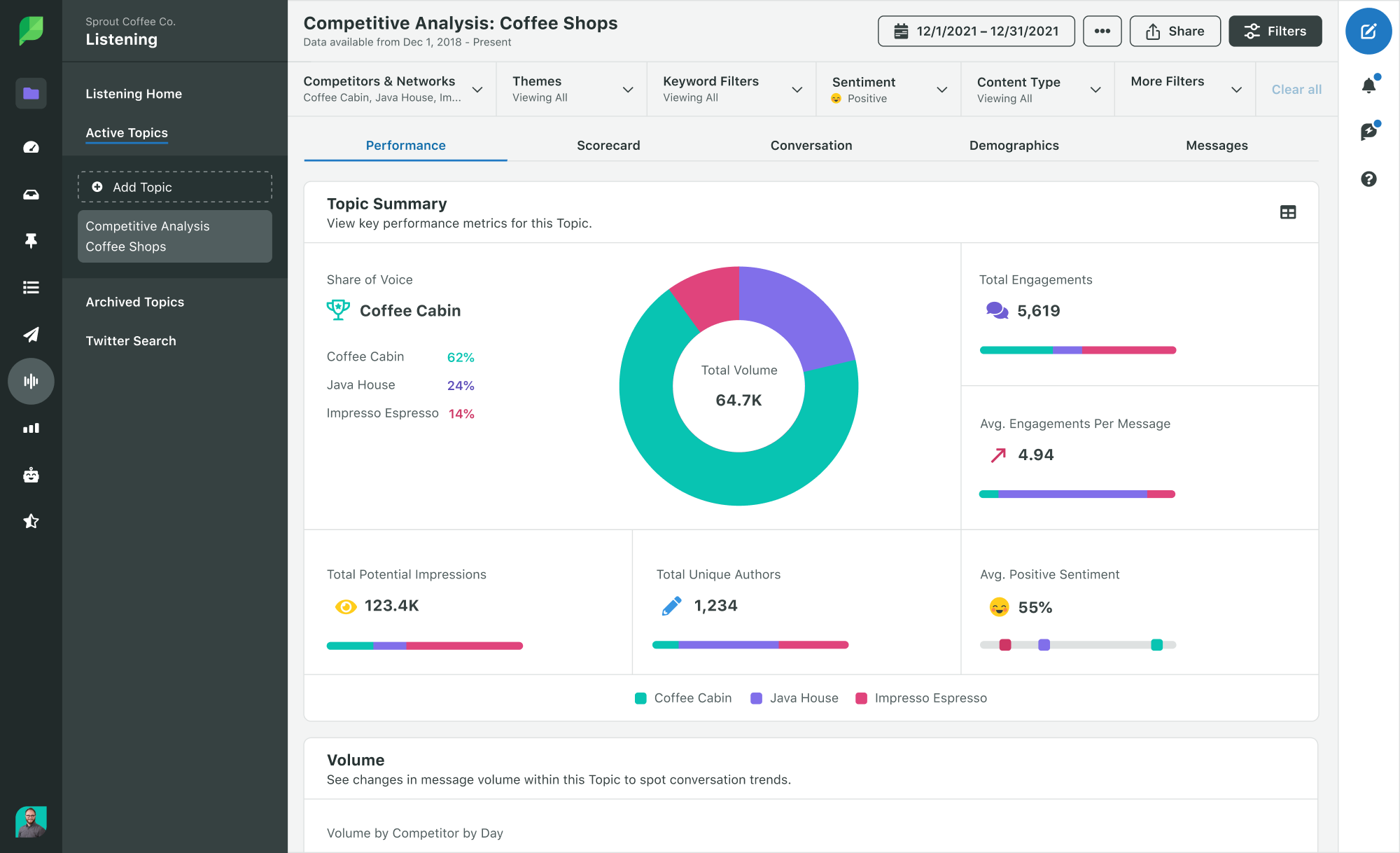
Show your position in the competitive landscape
Finally, a competitive analysis report must show where your business and every important competitor stands in the competitive landscape. This can be achieved by pinpointing the two most important dimensions for competitiveness in your market and mapping them on a matrix alongside your company and its competitors.
With that, you’ll get a clear idea of your position based on the SWOT analysis you created earlier. Conclude the report by making recommendations that serve the original purpose of the competitive analysis.
Examples of competitive analysis reports
Here are some sample scenarios showing the details a competitive analysis report should focus on.
1. Increasing market share
To create a competitive analysis report focused on increasing market share, you must first start with a thorough product analysis . Identify and compare the core features and functionality of your competitors’ products against yours. Consider how their products meet the pressing needs of customers and look for areas of dissatisfaction you can capitalize on.
Evaluate the overall target market, including the customer segments your competitors focus on and their marketing strategies. By studying their positioning, messaging and marketing channels, you’ll discover underserved customer segments or areas of overlap in the market. The report should outline the opportunities gleaned from the analysis and recommend possible ways to address the needs and preferences of the untapped market segment.
2. New product launch
For a competitive report on a new product launch, start with a marketing competitive analysis to identify your direct and indirect competitors. Analyze their market share, product offerings and pricing strategies to determine the best ways to position your product, establish a strong presence and win customers early.
Consider the quality of each competing product, including its user experience and technological capabilities. Look for areas where your product can leverage emerging technology to gain a competitive edge. Also evaluate your competitors’ customer service and support offerings, including their return policies to identify how you can use superior customer service to build trust and loyalty quickly.
3. SEO campaigns
A competitive analysis report for an SEO campaign should focus on evaluating the content marketing, social media presence and SEO strategies of competitors. Analyze the keywords, content types and promotional strategies that drive the most organic traffic and customers for their business. On social channels, monitor their engagement levels, posting frequency, top-performing content and audience growth. These insights are useful for comparing and benchmarking your performance.
The report should also cover local search optimization and online advertising efforts for a comprehensive view of your competitors’ strengths and weaknesses.
Top competitive analysis reporting tools
Competitive monitoring tools help optimize the research process, analyze multiple data points and deliver data-driven insights you can use immediately.
Check out these three tools that help streamline the process of creating competitive analysis reports.
Sprout Social
Sprout Social provides powerful tools to help you monitor your competitors’ performance across social platforms like Instagram, Facebook and X (formerly Twitter).

It allows you to benchmark your social performance against your top competitors so you can truly understand your brand’s social health. Sprout’s Advanced Listening tool helps you tap into conversations about you, your industry and competitors across social channels, review sites and communities.
With its powerful AI technology, you can sift through millions of conversations to uncover insights about key topics, your audience and industry in seconds. Those insights help you measure your share of voice (SOV), develop crisis management strategies and identify new market opportunities.
With access to tools like Premium Analytics and Sprout’s suite of competitive reports , you can easily visualize and show the impact of in-depth competitive analysis research. Your report can include:
- Customized metrics based on your business goals and team’s priorities
- Interactive charts and graphs that illuminate critical social data
- Custom date range comparisons for performance benchmarking.
And with Sprout’s dynamic shareable link, you can quickly share the report with your team and external shareholders outside Sprout.
Kompyte gathers competitive intelligence from millions of data points, including social, website, content, ads, reviews, job postings and more. The platform uses artificial intelligence to filter through the noise and deliver actionable insights on your competitors.

It automatically organizes competitive data into battle cards highlighting differentiators, market feedback, revenue and everything else your sales teams need to win deals.
Crayon uses artificial intelligence to track your competitors and also gives you alerts based on your requirements. It analyzes social content, reviews, press releases, pricing updates and other information to collect and provide insights into top competitors to keep your teams informed with relevant data.

Crayon allows you to create customizable reports and use battle cards, newsletters and announcements to share competitive intelligence data with your team.
Use competitive analysis reporting to grow your business
A competitive report is a compilation of data and statistics that empowers your company to make informed decisions and develop effective strategies. Once you compile the information from your competitive intelligence, you’ll be able to follow up on your findings with a clear action plan to boost your business.
Sprout can help streamline your competitive research process, benchmark your performance against the competition and create comprehensive reports that highlight your most critical data in an engaging way. Sign up for a free trial to try it for yourself.
- Competitive Strategies
- Customer Experience
Business intelligence reporting: making sense of your organization’s data
- Marketing Disciplines
Competitor mapping: The benefits and how to create your own
12 of the best competitive intelligence tools for marketers
- Social Listening
Why competitive research will become more important for social teams in 2024
- Now on slide
Build and grow stronger relationships on social
Sprout Social helps you understand and reach your audience, engage your community and measure performance with the only all-in-one social media management platform built for connection.
SWOT Analysis Case Studies. The SWOT analysis method is the situation analysis method. It was proposed by Weirik, a professor of management at the University of San Francisco in the early 1980s. It is often used in enterprise strategy formulation, competitor analysis and other occasions including analysis of S trengths, W eaknesses, O ...
If that happens, it will most probably shrink the market share for Airbus. 3. Zara. Next on our list of SWOT Analysis examples is Zara, one of the biggest clothing companies in the world. Zara is a brand owned by Inditex, among with several others such as Bershka, Stradivarius, and Oysho. SWOT Analysis examples #3: Zara.
A SWOT analysis is a technique used to identify strengths, weaknesses, opportunities, and threats for your business or even a specific project. It's most widely used by organizations—from small businesses and non-profits to large enterprises—but a SWOT analysis can be used for personal purposes as well. While simple, a SWOT analysis is a ...
SWOT Analysis: How To Do One [With Template & Examples] As your business grows, you need a roadmap to help navigate the obstacles, challenges, opportunities, and projects that come your way. Enter: the SWOT analysis. This framework can help you develop a plan to determine your priorities, maximize opportunities, and minimize roadblocks as you ...
Benefits Of Doing A SWOT Analysis In Marketing. You can build an efficient model that helps you accurately gauge the business performance. Analyze the organization's internal and external strengths. You learn how to increase visibility in the market. Develop a plan of action that is implemented when needed.
The SWOT analysis is a simple, structured approach for analyzing businesses. The framework is widely used and applicable in numerous scenarios. It's useful when operating a business, acting as an advisor, or preparing for case interviews. Apply it to your own business situation and let us know how it benefits you!
by Sarah Jane Gilbert. These tools can help managers make informed decisions on market analysis, breakeven analysis, customer lifetime value, profit and pricing, and analyzing the competitive environment. Interview with Tom Steenburgh. Key concepts include: Immense changes in marketing are driving an increasing need for data analysis.
1) An overview of the Business Analysis Case Study. 2) Step 1: Understanding the company and its objectives. 3) Step 2: Gathering relevant data. 4) Step 3: Conducting SWOT analysis. 5) Step 4: Identifying key issues and prioritising. 6) Step 5: Analysing the root causes. 7) Step 6: Proposing solutions and developing an action plan.
Key Highlights. SWOT is used to help assess the internal and external factors that contribute to a company's relative advantages and disadvantages. A SWOT analysis is generally used in conjunction with other assessment frameworks, like PESTEL and Porter's 5-Forces. Findings from a SWOT analysis will help inform model assumptions for the ...
SWOT stands for Strengths, Weaknesses, Opportunities, and Threats, and so a SWOT analysis is a technique for assessing these four aspects of your business. SWOT Analysis is a tool that can help you to analyze what your company does best now, and to devise a successful strategy for the future. SWOT can also uncover areas of the business that are ...
February 23, 2021. 1973/Getty Images. Summary. The SWOT analysis is a recognized tool to identify an organization, department, product, or service's strengths, weaknesses, opportunities, and ...
Nykaa Case Study: SWOT Analysis, Business Model and Marketing Strategy. Nykaa is an Indian brand of beauty and cosmetic products. It was founded by Falguni Nayyar in 2012. Since then, it has evolved into a lifestyle brand offering a curated selection of 1900+ brands and 1 lakh+ products across skincare, makeup, fragrance, health, haircare, etc.
The SWOT matrix is a simple analysis of internal strengths and weaknesses as well as external opportunities and threats. Opportunities can be seen as threats and vice versa. SWOT matrices don't show the interrelationship between internal and external factors. The SWOT analysis itself does not allow us to make strategic decisions but can be ...
An evaluation of marketing strategies undertaken by Coca Cola Company as a multinational corporation in Nigeria. Effects of sucrose, caffeine, and cola beverages on obesity, cold resistance, and ...
successful deployment of its business strategy of organic expansion into international markets, horizontal integration through smart acquisitions and alliances that maintains their long-term strategic objective being the most recognized and respected brands in the world. 3.2) Starbucks SWOT Analysis: Strengths:
Read through the case study and SWOT Analysis Template, then try to complete the activity below. Case study 1: Syed's business opportunity. ... By taking a realistic look at his business as it is, he can decide what is most likely to make sense for its future. There's no absolute right or wrong here (there rarely is in this sort of decision ...
A SWOT analysis is a framework used in a business's strategic planning to evaluate its competitive positioning in the marketplace. The analysis looks at four key characteristics that are ...
A business analyst can utilize SWOT analysis in a number of ways: To ascertain the viability of a proposed solution. To identify new opportunities in a domain or sector. To find better alternatives for an existing solution. To analyze a system undergoing change. To study and research about business competition.
SWOT stands for ''strengths, weaknesses, opportunities, and threats.''. A SWOT analysis is useful because it helps an organization to determine where they stand in the market and whether or not ...
Strengths. Customer knowledge. One of the key competitive advantages IKEA has is its extensive knowledge about the customers. The company understands the purchasing factors that influence customers to buy and implements the best practices to induce that decision.
Abstract. According to the case study, the company, TATA Motors wants to have a multiband approach to competing in the global car industry. Based on the case-study, I analyzed the company as a whole in the global car industry and based on my findings figured out their SWOT (strengths, weaknesses, opportunities and threats).
Weaknesses are used to refer to areas where the business or the brand needs improvement. Some of the key weaknesses of Lidl are: Inability to Penetrate Successfully in Foreign Markets: Quite unlike global contemporaries like Target or Walmart, Lidl has restricted itself mostly just to Europe, the UK, and the USA.
3. SEO campaigns. A competitive analysis report for an SEO campaign should focus on evaluating the content marketing, social media presence and SEO strategies of competitors. Analyze the keywords, content types and promotional strategies that drive the most organic traffic and customers for their business.
SWOT analyses look at the Strengths, Weaknesses, Opportunities, and Threats of a given organization or venture. SWOT is perfect for business analysis because it delves into the factors that matter most, cutting right to the chase. It also reminds you, through the simple 4-letter mnemonic, to include both the positive and negative factors and ...

Turn Your Curiosity Into Discovery
Latest facts.
15 Facts About World Health Day April 7th
8 Facts About International Day Of Light May 16th
40 facts about elektrostal.
Written by Lanette Mayes
Modified & Updated: 02 Mar 2024
Reviewed by Jessica Corbett

Elektrostal is a vibrant city located in the Moscow Oblast region of Russia. With a rich history, stunning architecture, and a thriving community, Elektrostal is a city that has much to offer. Whether you are a history buff, nature enthusiast, or simply curious about different cultures, Elektrostal is sure to captivate you.
This article will provide you with 40 fascinating facts about Elektrostal, giving you a better understanding of why this city is worth exploring. From its origins as an industrial hub to its modern-day charm, we will delve into the various aspects that make Elektrostal a unique and must-visit destination.
So, join us as we uncover the hidden treasures of Elektrostal and discover what makes this city a true gem in the heart of Russia.
Key Takeaways:
- Elektrostal, known as the “Motor City of Russia,” is a vibrant and growing city with a rich industrial history, offering diverse cultural experiences and a strong commitment to environmental sustainability.
- With its convenient location near Moscow, Elektrostal provides a picturesque landscape, vibrant nightlife, and a range of recreational activities, making it an ideal destination for residents and visitors alike.
Known as the “Motor City of Russia.”
Elektrostal, a city located in the Moscow Oblast region of Russia, earned the nickname “Motor City” due to its significant involvement in the automotive industry.
Home to the Elektrostal Metallurgical Plant.
Elektrostal is renowned for its metallurgical plant, which has been producing high-quality steel and alloys since its establishment in 1916.
Boasts a rich industrial heritage.
Elektrostal has a long history of industrial development, contributing to the growth and progress of the region.
Founded in 1916.
The city of Elektrostal was founded in 1916 as a result of the construction of the Elektrostal Metallurgical Plant.
Located approximately 50 kilometers east of Moscow.
Elektrostal is situated in close proximity to the Russian capital, making it easily accessible for both residents and visitors.
Known for its vibrant cultural scene.
Elektrostal is home to several cultural institutions, including museums, theaters, and art galleries that showcase the city’s rich artistic heritage.
A popular destination for nature lovers.
Surrounded by picturesque landscapes and forests, Elektrostal offers ample opportunities for outdoor activities such as hiking, camping, and birdwatching.
Hosts the annual Elektrostal City Day celebrations.
Every year, Elektrostal organizes festive events and activities to celebrate its founding, bringing together residents and visitors in a spirit of unity and joy.
Has a population of approximately 160,000 people.
Elektrostal is home to a diverse and vibrant community of around 160,000 residents, contributing to its dynamic atmosphere.
Boasts excellent education facilities.
The city is known for its well-established educational institutions, providing quality education to students of all ages.
A center for scientific research and innovation.
Elektrostal serves as an important hub for scientific research, particularly in the fields of metallurgy, materials science, and engineering.
Surrounded by picturesque lakes.
The city is blessed with numerous beautiful lakes, offering scenic views and recreational opportunities for locals and visitors alike.
Well-connected transportation system.
Elektrostal benefits from an efficient transportation network, including highways, railways, and public transportation options, ensuring convenient travel within and beyond the city.
Famous for its traditional Russian cuisine.
Food enthusiasts can indulge in authentic Russian dishes at numerous restaurants and cafes scattered throughout Elektrostal.
Home to notable architectural landmarks.
Elektrostal boasts impressive architecture, including the Church of the Transfiguration of the Lord and the Elektrostal Palace of Culture.
Offers a wide range of recreational facilities.
Residents and visitors can enjoy various recreational activities, such as sports complexes, swimming pools, and fitness centers, enhancing the overall quality of life.
Provides a high standard of healthcare.
Elektrostal is equipped with modern medical facilities, ensuring residents have access to quality healthcare services.
Home to the Elektrostal History Museum.
The Elektrostal History Museum showcases the city’s fascinating past through exhibitions and displays.
A hub for sports enthusiasts.
Elektrostal is passionate about sports, with numerous stadiums, arenas, and sports clubs offering opportunities for athletes and spectators.
Celebrates diverse cultural festivals.
Throughout the year, Elektrostal hosts a variety of cultural festivals, celebrating different ethnicities, traditions, and art forms.
Electric power played a significant role in its early development.
Elektrostal owes its name and initial growth to the establishment of electric power stations and the utilization of electricity in the industrial sector.
Boasts a thriving economy.
The city’s strong industrial base, coupled with its strategic location near Moscow, has contributed to Elektrostal’s prosperous economic status.
Houses the Elektrostal Drama Theater.
The Elektrostal Drama Theater is a cultural centerpiece, attracting theater enthusiasts from far and wide.
Popular destination for winter sports.
Elektrostal’s proximity to ski resorts and winter sport facilities makes it a favorite destination for skiing, snowboarding, and other winter activities.
Promotes environmental sustainability.
Elektrostal prioritizes environmental protection and sustainability, implementing initiatives to reduce pollution and preserve natural resources.
Home to renowned educational institutions.
Elektrostal is known for its prestigious schools and universities, offering a wide range of academic programs to students.
Committed to cultural preservation.
The city values its cultural heritage and takes active steps to preserve and promote traditional customs, crafts, and arts.
Hosts an annual International Film Festival.
The Elektrostal International Film Festival attracts filmmakers and cinema enthusiasts from around the world, showcasing a diverse range of films.
Encourages entrepreneurship and innovation.
Elektrostal supports aspiring entrepreneurs and fosters a culture of innovation, providing opportunities for startups and business development.
Offers a range of housing options.
Elektrostal provides diverse housing options, including apartments, houses, and residential complexes, catering to different lifestyles and budgets.
Home to notable sports teams.
Elektrostal is proud of its sports legacy, with several successful sports teams competing at regional and national levels.
Boasts a vibrant nightlife scene.
Residents and visitors can enjoy a lively nightlife in Elektrostal, with numerous bars, clubs, and entertainment venues.
Promotes cultural exchange and international relations.
Elektrostal actively engages in international partnerships, cultural exchanges, and diplomatic collaborations to foster global connections.
Surrounded by beautiful nature reserves.
Nearby nature reserves, such as the Barybino Forest and Luchinskoye Lake, offer opportunities for nature enthusiasts to explore and appreciate the region’s biodiversity.
Commemorates historical events.
The city pays tribute to significant historical events through memorials, monuments, and exhibitions, ensuring the preservation of collective memory.
Promotes sports and youth development.
Elektrostal invests in sports infrastructure and programs to encourage youth participation, health, and physical fitness.
Hosts annual cultural and artistic festivals.
Throughout the year, Elektrostal celebrates its cultural diversity through festivals dedicated to music, dance, art, and theater.
Provides a picturesque landscape for photography enthusiasts.
The city’s scenic beauty, architectural landmarks, and natural surroundings make it a paradise for photographers.
Connects to Moscow via a direct train line.
The convenient train connection between Elektrostal and Moscow makes commuting between the two cities effortless.
A city with a bright future.
Elektrostal continues to grow and develop, aiming to become a model city in terms of infrastructure, sustainability, and quality of life for its residents.
In conclusion, Elektrostal is a fascinating city with a rich history and a vibrant present. From its origins as a center of steel production to its modern-day status as a hub for education and industry, Elektrostal has plenty to offer both residents and visitors. With its beautiful parks, cultural attractions, and proximity to Moscow, there is no shortage of things to see and do in this dynamic city. Whether you’re interested in exploring its historical landmarks, enjoying outdoor activities, or immersing yourself in the local culture, Elektrostal has something for everyone. So, next time you find yourself in the Moscow region, don’t miss the opportunity to discover the hidden gems of Elektrostal.
Q: What is the population of Elektrostal?
A: As of the latest data, the population of Elektrostal is approximately XXXX.
Q: How far is Elektrostal from Moscow?
A: Elektrostal is located approximately XX kilometers away from Moscow.
Q: Are there any famous landmarks in Elektrostal?
A: Yes, Elektrostal is home to several notable landmarks, including XXXX and XXXX.
Q: What industries are prominent in Elektrostal?
A: Elektrostal is known for its steel production industry and is also a center for engineering and manufacturing.
Q: Are there any universities or educational institutions in Elektrostal?
A: Yes, Elektrostal is home to XXXX University and several other educational institutions.
Q: What are some popular outdoor activities in Elektrostal?
A: Elektrostal offers several outdoor activities, such as hiking, cycling, and picnicking in its beautiful parks.
Q: Is Elektrostal well-connected in terms of transportation?
A: Yes, Elektrostal has good transportation links, including trains and buses, making it easily accessible from nearby cities.
Q: Are there any annual events or festivals in Elektrostal?
A: Yes, Elektrostal hosts various events and festivals throughout the year, including XXXX and XXXX.
Was this page helpful?
Our commitment to delivering trustworthy and engaging content is at the heart of what we do. Each fact on our site is contributed by real users like you, bringing a wealth of diverse insights and information. To ensure the highest standards of accuracy and reliability, our dedicated editors meticulously review each submission. This process guarantees that the facts we share are not only fascinating but also credible. Trust in our commitment to quality and authenticity as you explore and learn with us.
Share this Fact:

IMAGES
COMMENTS
2008 Ocean Yachts 37 Billfish. US$465,000. US $3,639/mo. South Jersey Yacht Sales | Cape May, New Jersey. Request Info. <. 1. >. * Price displayed is based on today's currency conversion rate of the listed sales price.
A powerboat built by Ocean Yachts, the Billfish 37 is a saltwater fishing vessel. Ocean Yachts Billfish 37 boats are typically used for overnight-cruising and saltwater-fishing. These boats were built with a fiberglass modified-vee; usually with an inboard and available in Diesel. Got a specific Ocean Yachts Billfish 37 in mind? ...
Fuel Capacity: 400 gals. Model Years: 2008—2012. Draft: 2'6". Beam: 13'10". Water Capacity: 75 gals. Waste Capacity: 35 gals. Length w/ Pulpit: --. The Ocean 37 Billfish is a throwback to the classic, custom-built fishing boats of the 1960s. Her vintage Palm Beach styling belies her modern engineering and construction, however, and the ...
Description. 2008 Ocean Yachts 37 Billfish. The 37 Billfish is a throwback to the classic, custom-built fishing boats of the 1960's. Her vintage Palm Beach styling belies her modern engineering and construction, however, and the 37 Billfish incorporates the same upscale amenities found in every Ocean Yacht. Unlike Flybridge Convertibles with ...
2008 Ocean Yachts 37 Billfish Disclaimer. HMY Yacht Sales, Inc. is pleased to assist you in the purchase of this vessel. This boat is centrally listed by HMY Yacht Sales - Waterway Marina. Fifth Day Specifications. Name: Fifth Day. Current Price: $379,000. Year: 2008. Engine Model: 6LY-ETP. Length: 37 ft. Gross Weight: 23,500 lb.
Ocean used a 3-D surface-modeling program to design the 37 Billfish's entire hull and deckhouse. It e-mailed electronic files containing the 3-D geometry to Marine Concepts, a Florida-based company that formed the hull and deckhouse plugs from blocks of structural foam using a five-axis CNC router. The finished plugs were then shipped to Ocean ...
Description. This 2008 37 Ocean Billfish is yet again another chance to own a great little convertible Sportfisher at a fraction of the cost of your typical expensive Sportfish! This 37 Billfish has just completed engine room detailing, paint work in engine room and complete compound and waxing of interior, hull, topsides, EZ2CY enclosure and ...
Ocean Yachts is known for building offshore fishing machines, among them boats like the traditionally-designed convertible Ocean Yachts 42 which we reviewed after spending an entire day of shark fishing aboard one. But they changed the game a bit when introducing the Billfisher 37. This model features a flybridge, but instead of finding an ...
2008 Ocean Yachts Billfish 37. Ocean Yachts 37 Billfish "Ali Baba" is a classic offshore day fisher built in 2008. This is a real opportunity as she is the one and only Billfish 37 present in Europe. She is very well maintained: many upgrades added to this sportfishing machine ! Offshore fishermen want a boat with the stamina and power to ...
The Ocean Yachts 37 Billfish offers a convenient layout coupled with nimble performance. By Kevin Falvey Updated: April 29, 2008 You could buy a rehabbed, repowered Merritt 37 or Rybovich 36 to get the look and layout provided by Ocean's 37 Billfish. Of course, 50-year-old wooden boats require more love and money than even a nut like me is ...
2016 Ocean Yachts 37 Billfish. $699,000. Point Pleasant, NJ 08742. Clarks Landing Yacht Sales NJ. 1997 Ocean Yachts 40 Super Sport. $221,000. North Miami, FL 33181. Pop Yachts. Below are a few similar boat listings we think you might like.
Find Ocean Yachts Billfish 37 boats for sale in your area & across the world on YachtWorld. Offering the best selection of Ocean Yachts to choose from.
Wanted is a 2009 Ocean Yachts 37' 37 Billfish listed for sale with United Yacht Broker Mordy Miltz, CPYB. Mordy can be reached at 1-516-606-1282 to answer any questions you may have on this boat. United Yacht Sales is a professional yacht brokerage firm that has experience listing and selling all types of Ocean Yachts and similar boats.
Ocean Yachts 37 Billfish for sale 3 Boats Available. Currency $ - USD - US Dollar Sort Sort Order List View Gallery View Submit. Advertisement. Save This Boat. Ocean Yachts 37 Billfish . Cape May, New Jersey. 2008. $465,000 Seller South Jersey Yacht Sales - CCM 44. Contact. 609-795-7652. ×. Save This Boat. Ocean Yachts 37 Billfish ...
The 37 Billfish is a fresh, new 21st century take on an old concept that took good care of our fathers and grandfathers. Ocean Yachts was started in 1977 and during the last 31 years it has built thousands of boats of all sizes. The company revolutionized convertible and sportfishing boats in the 1980s building the most beautiful interiors ever ...
The 38 Billfish was designed and built with the same genetic makeup as her predecessor, the 37 Billfish. As an owner/operator vessel, the 38 Billfish offers simplicity and ease of maintenance, serving as a ready-to-go fishing machine equipped for inshore and offshore missions as well as a cruising boat with reliable inboard diesel power.
A powerboat built by Ocean Yachts, the 37 billfish is a saltwater fishing vessel. Ocean Yachts 37 billfish boats are typically used for overnight-cruising and saltwater-fishing. These boats were built with a fiberglass modified-vee; usually with an inboard and available in Diesel. Got a specific Ocean Yachts 37 billfish in mind? ...
DECEMBER 14, 2020 — After the recent refueling at power unit 3 of the Hungarian Paks NPP, its VVER-440 reactor has been loaded with a batch of fresh fuel including 18 fuel bundles of the new ...
His 15-crew boat often travels more than 700 nmi (1,300 km) offshore for what he calls "a handsome catch" of fish like tuna, ray, shark, seer fish and billfish.
Courtesy HMY Yacht Sales 2001 Viking 55 Convertible - Jezebel - Vero Beach, Florida. For the offshore angler who's in the market for a Viking Yachts sport fisherman, HMY Yacht Sales has Jezebel, a 2001 Viking 55 Convertible, listed with an asking price of $495,000. The 55-footer is tournament-ready with its 153-square-foot cockpit, 39 .....
The Stunning Ritz Carlton EVRIMA Yacht. Gliding Across Tokyo's Sumida River: The Mesmerizing Zipper Boat. CROCUS Yacht: An 48 Meter Beauty by Admiral. PHI Yacht - Royal Huisma
40 Facts About Elektrostal. Elektrostal is a vibrant city located in the Moscow Oblast region of Russia. With a rich history, stunning architecture, and a thriving community, Elektrostal is a city that has much to offer. Whether you are a history buff, nature enthusiast, or simply curious about different cultures, Elektrostal is sure to ...